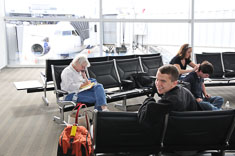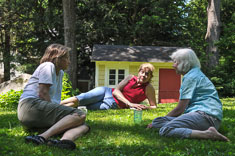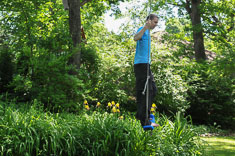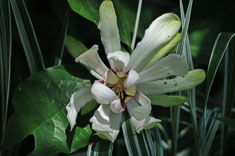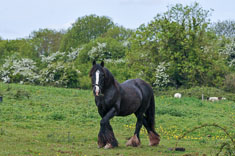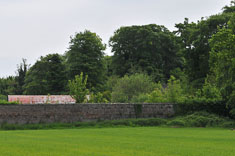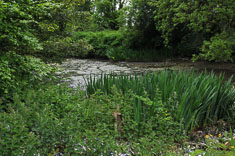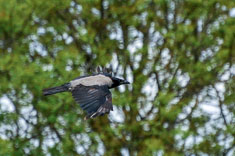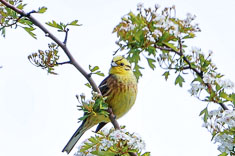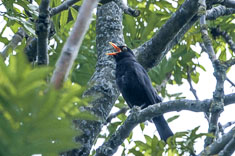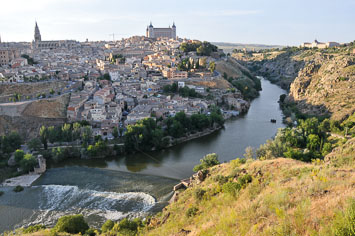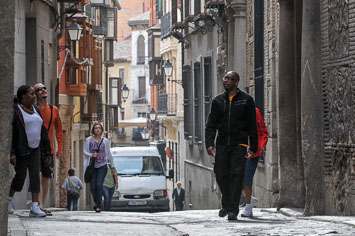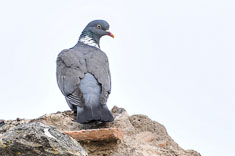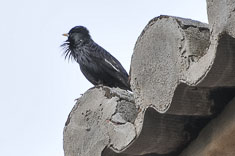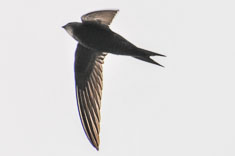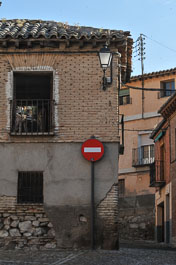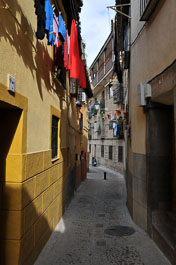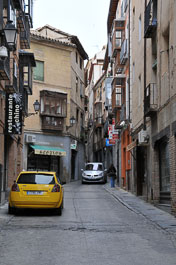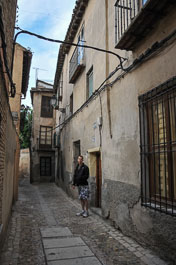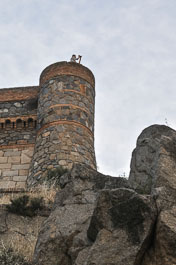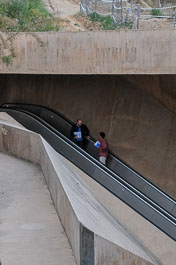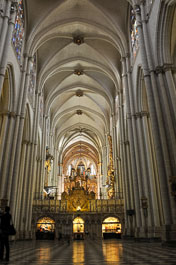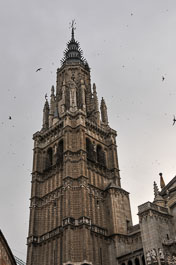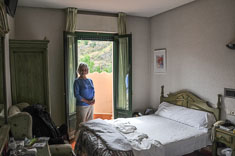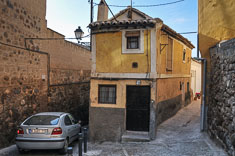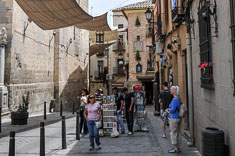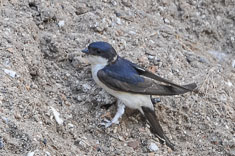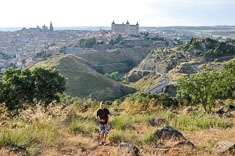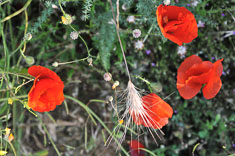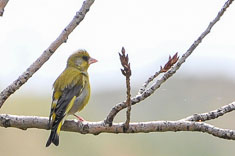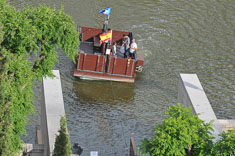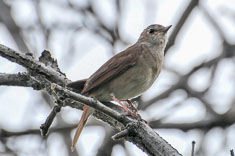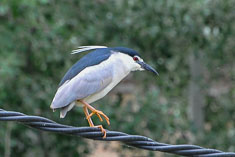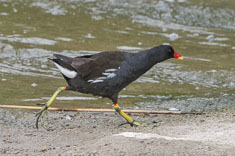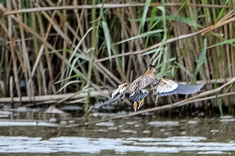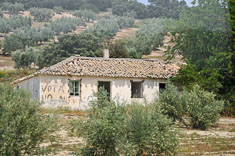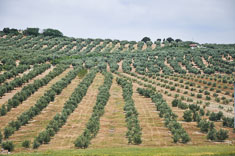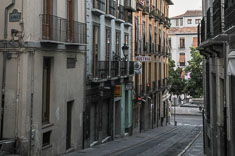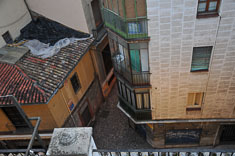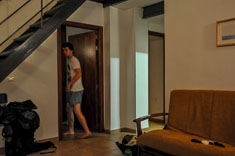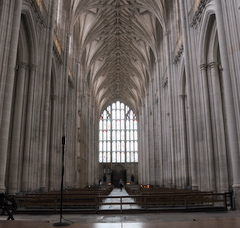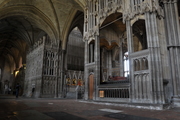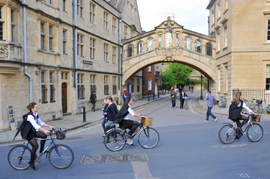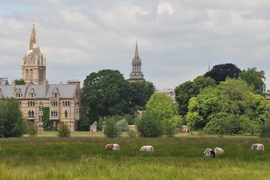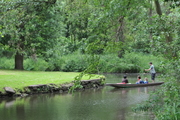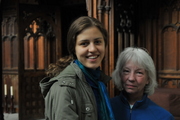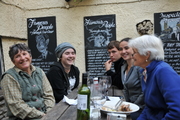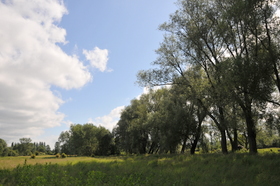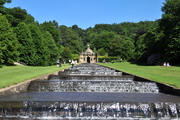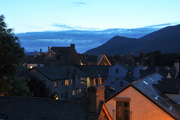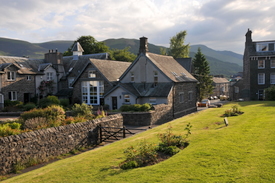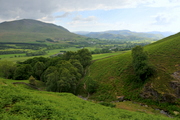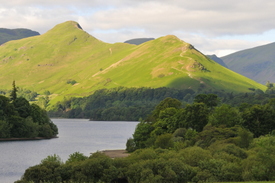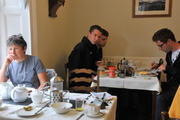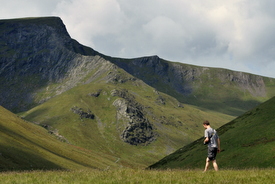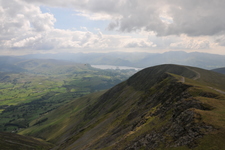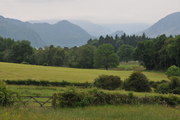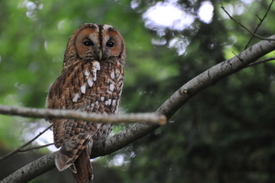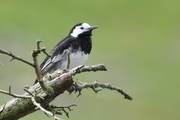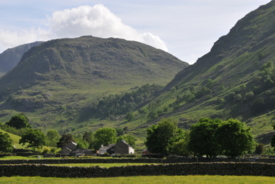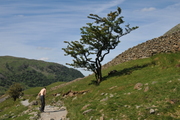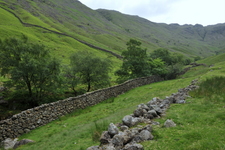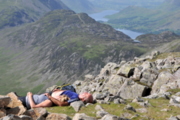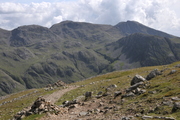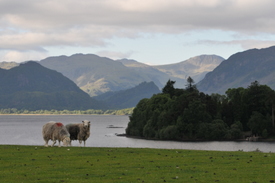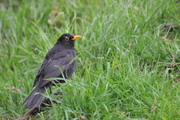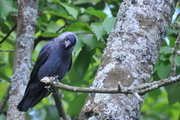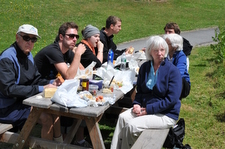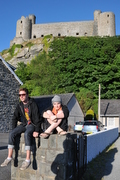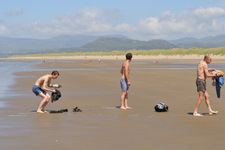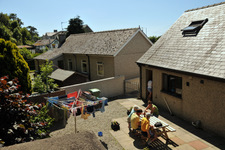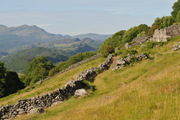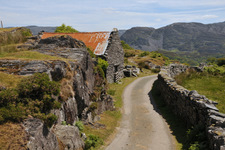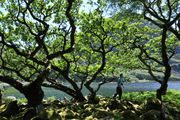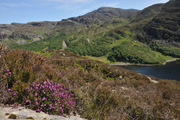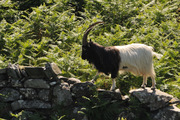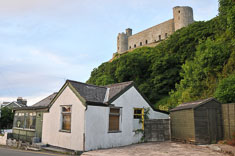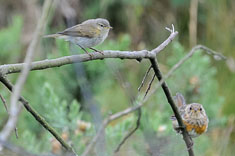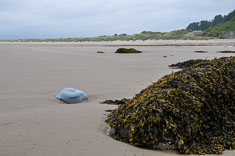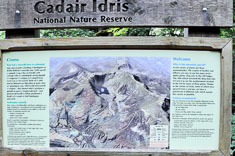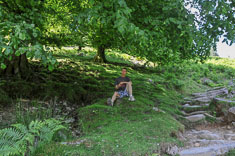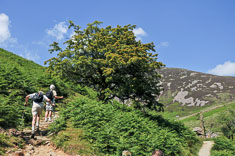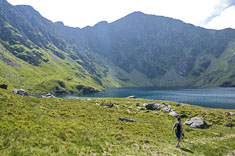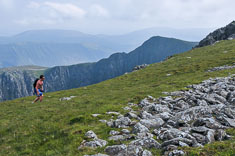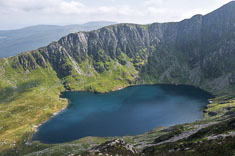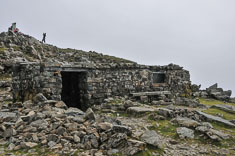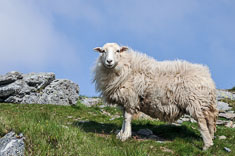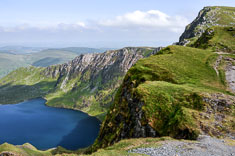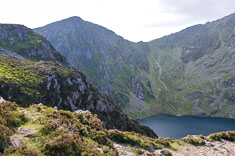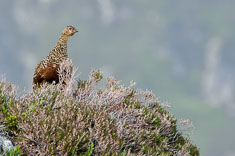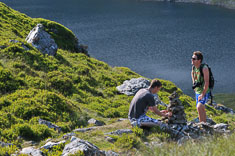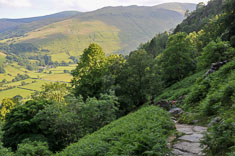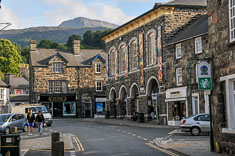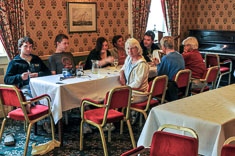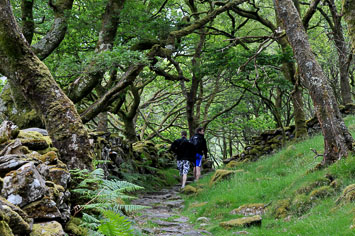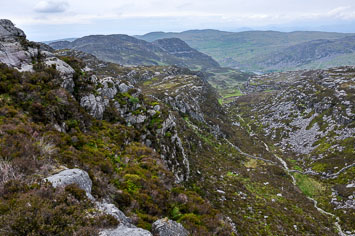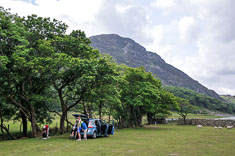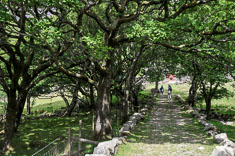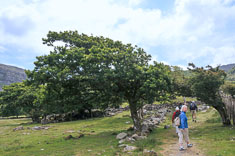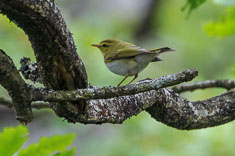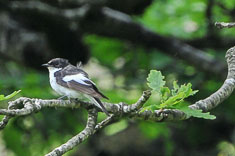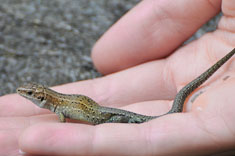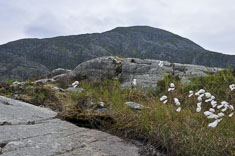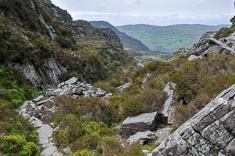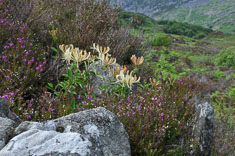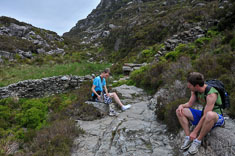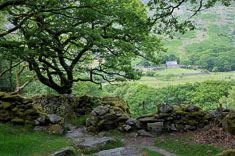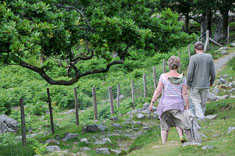05/07/2010 Friday
We had an unusually late frost last night, 37F on the back porch at 7AM and frost on the shingles of the garage roof as well as all across the field. Not a problem for anything in the garden because I don't have anything planted. It was still quite chilly a couple hours later to numb my fingers when I stood out on the back porch watching Yellow-rumped and Orange-crowned warblers foraging for their breakfast in the maple tree. The Orange-crowneds arrived here the day before yesterday; the Yellow-rumps a couple of weeks ago.
We had an unusually late frost last night, 37F on the back porch at 7AM and frost on the shingles of the garage roof as well as all across the field. Not a problem for anything in the garden because I don't have anything planted. It was still quite chilly a couple hours later to numb my fingers when I stood out on the back porch watching Yellow-rumped and Orange-crowned warblers foraging for their breakfast in the maple tree. The Orange-crowneds arrived here the day before yesterday; the Yellow-rumps a couple of weeks ago.
05/25/2010 Boston
Delayed in Seattle by unscheduled engine maintenance, our flight didn't arrive in Boston until 3AM. Alison met us at the airport nonetheless, drove us home and gave us her bed for the night. What a friend! Igor wasn't there; he and Ana have already gone to "Czecko" for the summer. Alison and Marianne will join them in another month or so. As we usually do, I slept on the left and Susan on the right, Igor's side of the bed as it turned out. Igor sleeps on the side closest to the door so he can leap up and defend his home and family from intruders if necessary.
The past few days have been difficult, filled with shopping, housecleaning, packing and putting affairs in order in preparation for leaving home for six weeks. Susan was anxious about how the cat would fare under Brandon's care during our absence, and very worried about what she would wear and how to fit it all into a 21" suitcase/backpack. She also had a list of tasks for David and I to do. Our initial discussion about her to-do list didn't go very well; I balked at being told what to do and we had a blowup over it. Trying to plan our first few days in Spain added to my frustration - too many choices, not enough information.
As departure day approached we found our list of remaining tasks beginning to look more manageable, less intimidating. Two days ago I finally managed to book places for our first two nights, in Toledo, and the next two, in Granada. Yesterday I hung curtains in the bedroom to block the light and vacuum-packed the bedding and clothing Susan wanted vacuum-packed. This morning I backed up the computer and filled out the application for insurance for the Tunnel Marathon. Susan found luggage that would work and travel clothes that she was reasonably comfortable with. David washed the windows around the house and cleaned the carpets in the bedroom and den with the machine I rented at Home Despot. We filled the recycling bin to overflowing and put out three packed trash barrels on Sunday night, a new record. The house looks better than it has in years. Cleaning the house and putting or throwing things away has lifted a big burden off Susan; she's almost happy about the place for a change. She's delighted too about losing weight, close to 20 pounds since the beginning of the year.
I woke up several times starting around 5:30AM, scarcely an hour after falling asleep, but was too sleepy to get up. The air was mild, almost sticky, the songs of birds floated in through the open windows and a soft breeze waltzed with the curtains. Sometime around 9AM I didn't fall back to sleep. Susan was already up and in the shower by the sound of it. A door was rattling somewhere. Later I learned it was Diana who'd been trapped in her room when the doorknob came off in her hand. She was stuck in there for about a half an hour before Susan, returning from the bathroom, heard the door rattling and let her out.
Awake enough now for a run, I went downstairs and dug a leftover pancake out of our foodpack in Alison's refrigerator. Morning runs without at least a few calories first can be tough. Alison came in and suggested I try to catch Donna on the aqueduct trail. It appears to be an old rail trail and it runs straight and level a little over a mile through white pines and mixed hardwoods and along a lake before terminating at highway 9. We flushed three bright Blue Jays from a sunny glade on the way down to the trailhead and I heard a variety of trills and fragments of songs in the woods, a Warbling Vireo, a Rose-breasted Grosbeak, perhaps an oriole, some juncos. I ran fast and reached the end in just 9 minutes, without catching up to Donna.
I found her down a side trail to a small peninsula called Pickle Point which projects out into the lake, puzzling over circular beds of bare gravel excavated in the algae-coated lakebed. A foot or two from shore, they were about 15" wide and dug out an inch or two deep, coarse gravel remaining in the center with sand washed out around the margins. Each was guarded by a stout little fish, bluegills I think, silvery blue and green with indistinct vertical bars on their sides, bright red or orange along the belly and a black spot behind the gills. The guardian fish hovers over the center of its nest or circles slowly around it, standing its ground in front of me as I wade out to test the water. Deterred by the algae-encrusted milfoil and the skin of pollen scum on the surface of the water, I decided not to go for a swim. As we walked back along the trail towards Alison's, I asked about her work. She lost her big case, a custody battle involving a mother in Germany and a father in New Jersey. She did all she could, within reason, but was unable to overcome the judge's apparent bias towards placing the child with the mother. In Germany, the mother virtually always wins custody and it turns out that the judge, though a US citizen, was born and raised in Germany.
We lingered too long in Alison's back yard under the shade of her big oaks, David and I playing on her rope swing while the women visited. After a quick shopping trip to pick up sandals for Susan and clothes for Daniel that we'd forgotten to bring from Seattle, Ali drove us to the airport. Traffic was light and checkin was easy and we were excited to be on our way to Spain but sad to leave Ali, Donna and Diana after such a relaxing, and too short, visit.
Delayed in Seattle by unscheduled engine maintenance, our flight didn't arrive in Boston until 3AM. Alison met us at the airport nonetheless, drove us home and gave us her bed for the night. What a friend! Igor wasn't there; he and Ana have already gone to "Czecko" for the summer. Alison and Marianne will join them in another month or so. As we usually do, I slept on the left and Susan on the right, Igor's side of the bed as it turned out. Igor sleeps on the side closest to the door so he can leap up and defend his home and family from intruders if necessary.
The past few days have been difficult, filled with shopping, housecleaning, packing and putting affairs in order in preparation for leaving home for six weeks. Susan was anxious about how the cat would fare under Brandon's care during our absence, and very worried about what she would wear and how to fit it all into a 21" suitcase/backpack. She also had a list of tasks for David and I to do. Our initial discussion about her to-do list didn't go very well; I balked at being told what to do and we had a blowup over it. Trying to plan our first few days in Spain added to my frustration - too many choices, not enough information.
As departure day approached we found our list of remaining tasks beginning to look more manageable, less intimidating. Two days ago I finally managed to book places for our first two nights, in Toledo, and the next two, in Granada. Yesterday I hung curtains in the bedroom to block the light and vacuum-packed the bedding and clothing Susan wanted vacuum-packed. This morning I backed up the computer and filled out the application for insurance for the Tunnel Marathon. Susan found luggage that would work and travel clothes that she was reasonably comfortable with. David washed the windows around the house and cleaned the carpets in the bedroom and den with the machine I rented at Home Despot. We filled the recycling bin to overflowing and put out three packed trash barrels on Sunday night, a new record. The house looks better than it has in years. Cleaning the house and putting or throwing things away has lifted a big burden off Susan; she's almost happy about the place for a change. She's delighted too about losing weight, close to 20 pounds since the beginning of the year.
I woke up several times starting around 5:30AM, scarcely an hour after falling asleep, but was too sleepy to get up. The air was mild, almost sticky, the songs of birds floated in through the open windows and a soft breeze waltzed with the curtains. Sometime around 9AM I didn't fall back to sleep. Susan was already up and in the shower by the sound of it. A door was rattling somewhere. Later I learned it was Diana who'd been trapped in her room when the doorknob came off in her hand. She was stuck in there for about a half an hour before Susan, returning from the bathroom, heard the door rattling and let her out.
Awake enough now for a run, I went downstairs and dug a leftover pancake out of our foodpack in Alison's refrigerator. Morning runs without at least a few calories first can be tough. Alison came in and suggested I try to catch Donna on the aqueduct trail. It appears to be an old rail trail and it runs straight and level a little over a mile through white pines and mixed hardwoods and along a lake before terminating at highway 9. We flushed three bright Blue Jays from a sunny glade on the way down to the trailhead and I heard a variety of trills and fragments of songs in the woods, a Warbling Vireo, a Rose-breasted Grosbeak, perhaps an oriole, some juncos. I ran fast and reached the end in just 9 minutes, without catching up to Donna.
I found her down a side trail to a small peninsula called Pickle Point which projects out into the lake, puzzling over circular beds of bare gravel excavated in the algae-coated lakebed. A foot or two from shore, they were about 15" wide and dug out an inch or two deep, coarse gravel remaining in the center with sand washed out around the margins. Each was guarded by a stout little fish, bluegills I think, silvery blue and green with indistinct vertical bars on their sides, bright red or orange along the belly and a black spot behind the gills. The guardian fish hovers over the center of its nest or circles slowly around it, standing its ground in front of me as I wade out to test the water. Deterred by the algae-encrusted milfoil and the skin of pollen scum on the surface of the water, I decided not to go for a swim. As we walked back along the trail towards Alison's, I asked about her work. She lost her big case, a custody battle involving a mother in Germany and a father in New Jersey. She did all she could, within reason, but was unable to overcome the judge's apparent bias towards placing the child with the mother. In Germany, the mother virtually always wins custody and it turns out that the judge, though a US citizen, was born and raised in Germany.
We lingered too long in Alison's back yard under the shade of her big oaks, David and I playing on her rope swing while the women visited. After a quick shopping trip to pick up sandals for Susan and clothes for Daniel that we'd forgotten to bring from Seattle, Ali drove us to the airport. Traffic was light and checkin was easy and we were excited to be on our way to Spain but sad to leave Ali, Donna and Diana after such a relaxing, and too short, visit.
05/26/2010 Boston, Dublin, Toledo Birding route Dublin bird list
Had we been first off the plane in Dublin, we might have made our connection to Madrid but instead, delayed by long lines through security, we missed it by 10 minutes. David, who had taken a direct flight from Boston to Madrid, would have to find his way to Toledo without us. I got Euro change at a bar and logged onto an Internet computer for €1/8 minutes to email him and let him know he was on his own. Fortunately I'd given him the hotel information. He waited at the airport for us until around noon before checking email and finding my message. He managed to navigate Metro to the Plaza Elliptica bus station and find the "directo" bus to Toledo, then catch a taxi to Hotel Diamantista. We didn't learn whether or not he'd made it until we ourselves arrived around 2230. Susan was quite worried about him.
Susan wanted to book a hotel room and sleep so I checked some rates at a hotel board then verified our choice at the Tourist Information booth once they opened at 8 and found out where to catch the Hilton shuttle bus. Outside in the sunshine and cold breeze (like Seattle, 30F cooler than Boston was yesterday) I spotted a couple of Rooks and a flock of House Martins, both life birds, even before the bus showed up. It began to dawn on me that a layover in Dublin might not be so bad after all.
Our room at the Hilton Dublin Airport (Malahide Road and N32) for €38, was quiet and dark. Susan pulled the shades and was asleep within minutes. Peering out around the curtain I spotted a Pied Wagtail and gave up trying to bring up a local map on my IPod. I'd just go out and explore on foot. The neighborhood wasn't promising. The Hilton sits at a junction of two busy bulevards kitty-corner to a Tesco shopping center and surrounded by housing projects and light industry. I felt nervous about the neighborhood so left my camera behind, heading out past the Tesco and a big vacant lot then looping back around to the right, keeping to the big streets so as to avoid the housing projects and the gangs of hostile youths I imagined to lurk therein. I encountered a few women out shopping, a couple of kids playing around in a field, a white and black horse with huge hairy feet tethered in the median strip, and finally, some greenspace, a public park (Darndale Park) consisting of a vast lawn. Towards the far side a half dozen men were sitting with 10 foot fishing poles on a concrete sidewalk encircling a small pond. The fishing didn't look promising in the shallow water choked with trash and weeds.
Along the far side of the park a line of low trees and tall shrubs bordered the divided roadway which runs north from the hotel. Across the roadway (look right for oncoming traffic!) behind another hedgerow I found a big short-cropped pasture guarded by an iron picket fence, but there was a hole in the fence inadequately sealed off by rope and scrap metal and clearly well-used for local access judging by the dirt path through the hedge. What caught my attention was the grove of hardwoods across the pasture and the wholly unfamiliar bird songs emanating from them.
I returned to the Hilton for my camera and set off to explore. I found more big-hoofed horses in the pasture and well-worn trails leading into the woods across a small muddy stream, but no sight or sound of other people; it looked safe. And it was. For a couple of hours I explored the woods and the wheat fields and hedgerows beyond. I found old camps in the woods, tarps, sheet metal and fire rings, and a huge pile of empty beer cans but no current residents other than horses and hares and a nice variety of birds. The hedgerows and woods were dense and the birds seemed more skittish than at home. I imagined that might be an adaptation to centuries of human predation, that humans had perhaps been hunting the wildlife here for a millenium or more. I still found a nice variety of birds though, and managed to identify quite a few of them.
Back at the hotel I woke Susan up and we had a difficult hour or so getting packed up again and back to the airport. Susan couldn't get the shower to work and then it would only run hot water so at her insistence I called room service then she figured it out by the time they arrived. At the airport we enjoyed a leisurely lunch of Fish and chips and Eggs Florentine courtesy of Aer Lingus (lots of food but overpriced I thought at €43) before getting to the gate just in time to wait another 20 minutes for our delayed flight. Having not slept at all in the 27 hours since waking up at Ali's yesterday, I was asleep before our plane left the gate. Not for long though.
I woke up to a planeful of Irish schoolgirls practicing their Spanish vocabulary words. We glimpsed Cornwall through fluffy cumulus clouds, then later some dry-looking mountains with a few lingering patches of snow as we began our descent into Madrid. Spain from the air looked as I imagined it would, though greener - yellow-green fields, gray green groves and orchards, rusty limestone outcrops, dry blue sky. We met the challenge of finding the Metro, getting change, buying tickets, finding the bus station and boarding the directo bus to Toledo, following David's trail we hoped. On the subway we played musical chairs; I gave my seat to an older woman, then the girl next to me moved across the aisle to a seat next to her girlfriend, then a young African-looking man got up as if to get out at the next stop, indicating that I could take his place across from Susan, and finally I moved myself, my backpack and my plastic shopping bag of food and fleece over next to Susan for the last few stops. From Terminal 2 at the airport we took one subway line, the only one we realized after skipping the first train that came by, to Muros Ministerios then switched to line 6 to Plaza Elliptica to get the bus to Toledo from the Estacion del Autobus Sur. The subway was €2 each, the bus €4.71, both tickets dispensed by machines. The bus station in Toledo was an empty concrete cavern lit by yellowing flourescents. Upstairs we found a lone official in a glass-walled booth labeled Informacion who directed us to taxis outside the building. The driver of the first taxi in line knew Hotel El Diamantista and drove us there for €5.70. I gave him 7. We were both relieved nearly to tears when the proprietor, a quiet man in his 40's, said something about uno person in the room already when he'd been expecting tres. We climbed the stairs to room #214 and David opened the door.
Had we been first off the plane in Dublin, we might have made our connection to Madrid but instead, delayed by long lines through security, we missed it by 10 minutes. David, who had taken a direct flight from Boston to Madrid, would have to find his way to Toledo without us. I got Euro change at a bar and logged onto an Internet computer for €1/8 minutes to email him and let him know he was on his own. Fortunately I'd given him the hotel information. He waited at the airport for us until around noon before checking email and finding my message. He managed to navigate Metro to the Plaza Elliptica bus station and find the "directo" bus to Toledo, then catch a taxi to Hotel Diamantista. We didn't learn whether or not he'd made it until we ourselves arrived around 2230. Susan was quite worried about him.
Susan wanted to book a hotel room and sleep so I checked some rates at a hotel board then verified our choice at the Tourist Information booth once they opened at 8 and found out where to catch the Hilton shuttle bus. Outside in the sunshine and cold breeze (like Seattle, 30F cooler than Boston was yesterday) I spotted a couple of Rooks and a flock of House Martins, both life birds, even before the bus showed up. It began to dawn on me that a layover in Dublin might not be so bad after all.
Our room at the Hilton Dublin Airport (Malahide Road and N32) for €38, was quiet and dark. Susan pulled the shades and was asleep within minutes. Peering out around the curtain I spotted a Pied Wagtail and gave up trying to bring up a local map on my IPod. I'd just go out and explore on foot. The neighborhood wasn't promising. The Hilton sits at a junction of two busy bulevards kitty-corner to a Tesco shopping center and surrounded by housing projects and light industry. I felt nervous about the neighborhood so left my camera behind, heading out past the Tesco and a big vacant lot then looping back around to the right, keeping to the big streets so as to avoid the housing projects and the gangs of hostile youths I imagined to lurk therein. I encountered a few women out shopping, a couple of kids playing around in a field, a white and black horse with huge hairy feet tethered in the median strip, and finally, some greenspace, a public park (Darndale Park) consisting of a vast lawn. Towards the far side a half dozen men were sitting with 10 foot fishing poles on a concrete sidewalk encircling a small pond. The fishing didn't look promising in the shallow water choked with trash and weeds.
Along the far side of the park a line of low trees and tall shrubs bordered the divided roadway which runs north from the hotel. Across the roadway (look right for oncoming traffic!) behind another hedgerow I found a big short-cropped pasture guarded by an iron picket fence, but there was a hole in the fence inadequately sealed off by rope and scrap metal and clearly well-used for local access judging by the dirt path through the hedge. What caught my attention was the grove of hardwoods across the pasture and the wholly unfamiliar bird songs emanating from them.
I returned to the Hilton for my camera and set off to explore. I found more big-hoofed horses in the pasture and well-worn trails leading into the woods across a small muddy stream, but no sight or sound of other people; it looked safe. And it was. For a couple of hours I explored the woods and the wheat fields and hedgerows beyond. I found old camps in the woods, tarps, sheet metal and fire rings, and a huge pile of empty beer cans but no current residents other than horses and hares and a nice variety of birds. The hedgerows and woods were dense and the birds seemed more skittish than at home. I imagined that might be an adaptation to centuries of human predation, that humans had perhaps been hunting the wildlife here for a millenium or more. I still found a nice variety of birds though, and managed to identify quite a few of them.
Back at the hotel I woke Susan up and we had a difficult hour or so getting packed up again and back to the airport. Susan couldn't get the shower to work and then it would only run hot water so at her insistence I called room service then she figured it out by the time they arrived. At the airport we enjoyed a leisurely lunch of Fish and chips and Eggs Florentine courtesy of Aer Lingus (lots of food but overpriced I thought at €43) before getting to the gate just in time to wait another 20 minutes for our delayed flight. Having not slept at all in the 27 hours since waking up at Ali's yesterday, I was asleep before our plane left the gate. Not for long though.
I woke up to a planeful of Irish schoolgirls practicing their Spanish vocabulary words. We glimpsed Cornwall through fluffy cumulus clouds, then later some dry-looking mountains with a few lingering patches of snow as we began our descent into Madrid. Spain from the air looked as I imagined it would, though greener - yellow-green fields, gray green groves and orchards, rusty limestone outcrops, dry blue sky. We met the challenge of finding the Metro, getting change, buying tickets, finding the bus station and boarding the directo bus to Toledo, following David's trail we hoped. On the subway we played musical chairs; I gave my seat to an older woman, then the girl next to me moved across the aisle to a seat next to her girlfriend, then a young African-looking man got up as if to get out at the next stop, indicating that I could take his place across from Susan, and finally I moved myself, my backpack and my plastic shopping bag of food and fleece over next to Susan for the last few stops. From Terminal 2 at the airport we took one subway line, the only one we realized after skipping the first train that came by, to Muros Ministerios then switched to line 6 to Plaza Elliptica to get the bus to Toledo from the Estacion del Autobus Sur. The subway was €2 each, the bus €4.71, both tickets dispensed by machines. The bus station in Toledo was an empty concrete cavern lit by yellowing flourescents. Upstairs we found a lone official in a glass-walled booth labeled Informacion who directed us to taxis outside the building. The driver of the first taxi in line knew Hotel El Diamantista and drove us there for €5.70. I gave him 7. We were both relieved nearly to tears when the proprietor, a quiet man in his 40's, said something about uno person in the room already when he'd been expecting tres. We climbed the stairs to room #214 and David opened the door.
05/27/2010 Toledo Running and walking routes
The walled old city of Toledo sits on a prominent cliff-rimmed hill enclosed on three sides by a big incised oxbow of the Tajo River. Hotel El Diamantista abuts the south wall of the city, about in the center of the oxbow where the city spills down to the river's edge. Our room with its tight triangular high-walled balcony overlooks a narrow park along the river; day and night we hear the rushing of the water over a low weir, augmented during the day by the tinkling chatter of goldfinches and the harsher twittering of Barn Swallows and screeing of swifts.
The swallows are fairly common but the swifts are ubiquitous, soaring by the hundreds over the tile roofs and cathedral spires of the city. They strafe the streets like manic swept-wing fighters. The birds are relatively large so the effect of a squadron of swifts streaking at eye level down a narrow cobblestone alley can be a little intimidating - no time to run and no place to hide. Fortunately they're skilled navigators and collisions appear to be rare; they usually don't even come close enough for us to hear the whoosh of their wings. The other abundant bird, at least on the river side of town, is the Rock Dove which, along with an occasional Woodpigeon, seem to be always shuttling between one gray outcrop and another on the far side of the canyon.
Regarding the streets, they range in width from about the spread of my arms up to a scant meter wider than a delivery truck. Despite the streets' obvious unsuitability for cars, drivers clearly have priority over pedestrians. It is a common experience to be walking up a twisting lane lined on one or both sides with Citroens and Renaults and enclosed by continuous walls of brick, stone and mortar with only an occasional doorway for refuge as a car comes rattling down the cobblestones towards you. You tuck into a doorway or squeeze between parked car bumpers to let the car, piloted as likely as not by a young woman holding a cellphone to her ear, sweep past you. On a busy street you might advance only a few parked carlengths before hearing another vehicle approaching around the next bend. The street is rarely straight enough to see the next car coming.
Streets are often paved with two lanes of generally brownish quartzite pebbles divided and bordered by doubled rows of 10x20cm granite blocks, all mortared together and apparently resurfaced occasionally with gray cement/sand mix. The walls on either side are two or three stories tall with windows overhead sprouting geraniums through their iron grills, or the morning laundry hanging between balcony railings. The walls are composed of flat bricks, local gneiss rubble, blocks of granite or concrete or some mix of these materials and more built and maintained piecemeal over several centuries. Some houses are empty and gradually decaying. Workmen were hauling sand and rubble out of others, remodeling projects I assume. No telling how old the houses and streets are but the cathedral and other major buildings date back to the 12th to 15th centuries. Older ruins around the edge of town include Moorish baths, fragments of walls and foundations of a Roman aqueduct which once towered nearly 100' above the river.
We toured the cathedral, apparently one of the finest in Spain, after David and I returned from a morning exploration across the city to the northwest escalator and back. In addition to a couple of ramped streets and a couple more bike trails, the main pedestrian access to the old city is via a series of long, covered escalators. The cathedral is an imposing monument to the wealth of the church and the power of the men who've ruled it over the centuries. I can't imagine how much it cost to construct but the project took over 200 years. The gold-plated iron bars which wall off the high alter are an appropirate metaphor for the role the church has played in excluding people from the presence of God. I found much of the detail work to be too overwrought to be attractive but the stout columns ascending to improbably high vaulted ceilings were very impressive, particularly considering they were all made of stone.
Touring the city was frustrating in a way. Isolated by our inability to speak or understand the language, I felt as though we were viewing an animated diorama for which the captions were missing. I took lots of pictures of narrow alleys and window boxes. We worked up our courage to buy an Empanada con tomate and savored the sweet pastry with its thin tomato and onion filling as we wandered back towards our hotel. Tomato and onion must be a flavor principle of Spanish cooking; we encountered it again in the delicous Gazpacho we shared for lunch at the Madre de Tierre, Toledo's excellent vegetarian restaurant tucked into an alley below the SE corner of the cathedral.
Later in the afternoon, after siesta (I slept about an hour and a half, David about three) we discovered La Ruta de Don Quixota, a paved trail running along the river east from our hotel, and followed it up past the foundations of the old aqueduct to the first bridge over the river. We crossed and hiked up the road to the next bridge over a side canyon where we left the road to hike up into the hills. Lots of flowers - chamomile, lavender and vermilion poppies among them, and oaks and junipers scattered among the bunchgrasses. Someone has been replanting oaks in protective plastic sleeves (protection from feral goats?) up on top of the hills. From our vantage point we realized that the cathedral has a fine set of flying buttresses; they're not visible from the streets below.
We'd told Susan that we'd be back by 9PM so I'd been watching the "ferry" across the river to time our return. A cable runs across the river not far upstream from our hotel and a square steel box slides back and forth on the cable to ferry passengers between the two parks bordering the river. Unfortunately the ferry conductor went home for the evening after the 8:50 crossing. I was surprised since commerical activity, including the fancy restaurant high on the canyon rim across the river from our hotel, seems to continue until 10PM or later. When we went down to make sure the ferry was closed for the night, I photographed the nightingale we'd heard singing for most of the previous 24 hours from our hotel room. It was nearly 10PM by the time we made it out to dinner back at Madre de Tierre. Even at that hour we weren't the only diners in the restaurant, though I think we did close the place down.
The walled old city of Toledo sits on a prominent cliff-rimmed hill enclosed on three sides by a big incised oxbow of the Tajo River. Hotel El Diamantista abuts the south wall of the city, about in the center of the oxbow where the city spills down to the river's edge. Our room with its tight triangular high-walled balcony overlooks a narrow park along the river; day and night we hear the rushing of the water over a low weir, augmented during the day by the tinkling chatter of goldfinches and the harsher twittering of Barn Swallows and screeing of swifts.
The swallows are fairly common but the swifts are ubiquitous, soaring by the hundreds over the tile roofs and cathedral spires of the city. They strafe the streets like manic swept-wing fighters. The birds are relatively large so the effect of a squadron of swifts streaking at eye level down a narrow cobblestone alley can be a little intimidating - no time to run and no place to hide. Fortunately they're skilled navigators and collisions appear to be rare; they usually don't even come close enough for us to hear the whoosh of their wings. The other abundant bird, at least on the river side of town, is the Rock Dove which, along with an occasional Woodpigeon, seem to be always shuttling between one gray outcrop and another on the far side of the canyon.
Regarding the streets, they range in width from about the spread of my arms up to a scant meter wider than a delivery truck. Despite the streets' obvious unsuitability for cars, drivers clearly have priority over pedestrians. It is a common experience to be walking up a twisting lane lined on one or both sides with Citroens and Renaults and enclosed by continuous walls of brick, stone and mortar with only an occasional doorway for refuge as a car comes rattling down the cobblestones towards you. You tuck into a doorway or squeeze between parked car bumpers to let the car, piloted as likely as not by a young woman holding a cellphone to her ear, sweep past you. On a busy street you might advance only a few parked carlengths before hearing another vehicle approaching around the next bend. The street is rarely straight enough to see the next car coming.
Streets are often paved with two lanes of generally brownish quartzite pebbles divided and bordered by doubled rows of 10x20cm granite blocks, all mortared together and apparently resurfaced occasionally with gray cement/sand mix. The walls on either side are two or three stories tall with windows overhead sprouting geraniums through their iron grills, or the morning laundry hanging between balcony railings. The walls are composed of flat bricks, local gneiss rubble, blocks of granite or concrete or some mix of these materials and more built and maintained piecemeal over several centuries. Some houses are empty and gradually decaying. Workmen were hauling sand and rubble out of others, remodeling projects I assume. No telling how old the houses and streets are but the cathedral and other major buildings date back to the 12th to 15th centuries. Older ruins around the edge of town include Moorish baths, fragments of walls and foundations of a Roman aqueduct which once towered nearly 100' above the river.
We toured the cathedral, apparently one of the finest in Spain, after David and I returned from a morning exploration across the city to the northwest escalator and back. In addition to a couple of ramped streets and a couple more bike trails, the main pedestrian access to the old city is via a series of long, covered escalators. The cathedral is an imposing monument to the wealth of the church and the power of the men who've ruled it over the centuries. I can't imagine how much it cost to construct but the project took over 200 years. The gold-plated iron bars which wall off the high alter are an appropirate metaphor for the role the church has played in excluding people from the presence of God. I found much of the detail work to be too overwrought to be attractive but the stout columns ascending to improbably high vaulted ceilings were very impressive, particularly considering they were all made of stone.
Touring the city was frustrating in a way. Isolated by our inability to speak or understand the language, I felt as though we were viewing an animated diorama for which the captions were missing. I took lots of pictures of narrow alleys and window boxes. We worked up our courage to buy an Empanada con tomate and savored the sweet pastry with its thin tomato and onion filling as we wandered back towards our hotel. Tomato and onion must be a flavor principle of Spanish cooking; we encountered it again in the delicous Gazpacho we shared for lunch at the Madre de Tierre, Toledo's excellent vegetarian restaurant tucked into an alley below the SE corner of the cathedral.
Later in the afternoon, after siesta (I slept about an hour and a half, David about three) we discovered La Ruta de Don Quixota, a paved trail running along the river east from our hotel, and followed it up past the foundations of the old aqueduct to the first bridge over the river. We crossed and hiked up the road to the next bridge over a side canyon where we left the road to hike up into the hills. Lots of flowers - chamomile, lavender and vermilion poppies among them, and oaks and junipers scattered among the bunchgrasses. Someone has been replanting oaks in protective plastic sleeves (protection from feral goats?) up on top of the hills. From our vantage point we realized that the cathedral has a fine set of flying buttresses; they're not visible from the streets below.
We'd told Susan that we'd be back by 9PM so I'd been watching the "ferry" across the river to time our return. A cable runs across the river not far upstream from our hotel and a square steel box slides back and forth on the cable to ferry passengers between the two parks bordering the river. Unfortunately the ferry conductor went home for the evening after the 8:50 crossing. I was surprised since commerical activity, including the fancy restaurant high on the canyon rim across the river from our hotel, seems to continue until 10PM or later. When we went down to make sure the ferry was closed for the night, I photographed the nightingale we'd heard singing for most of the previous 24 hours from our hotel room. It was nearly 10PM by the time we made it out to dinner back at Madre de Tierre. Even at that hour we weren't the only diners in the restaurant, though I think we did close the place down.
05/28/2010 Toledo, Granada Our routes Toledo bird list
I ran this morning on the trail north along the river, with binoculars, which meant that I spent as much time birding as running. Beyond about a half mile north of town access to the river is fenced off; a sign said something about "conservacion". Reeds line the river in dense stands 10 feet or more tall. In from the reeds is a narrow band of trees - elm, poplar (a silvery-leafed cottonwood), a green-leafed cottonwood, tamarisk, a nut tree, perhaps walnut, mulberry, almond, fig. The mulberries were ripe and sweet and very popular with the house sparrows.
After my run David and I went out to find some food and managed to buy a loaf of bread, along with some olives, three oranges, two tomatoes and at another store, a chunk of queso fresca. We had a delicious breakfast with Susan back in our hotel room but eating and packing up used up all the time we had before checking out at noon so Susan didn't have time to go to Sinagoga del Transito. Adding considerable insult to minor injury, I decided to have us walk to the bus station rather than take a taxi. The woman at the hotel was angry with us because we were five or ten minutes late checking out, so I didn't want to ask her to call a taxi for us. Susan was unhappy about that so the walk to the bus was a little tense. Being interviewed in Plaza Zocovodere by a group of schoolgirls for their English class helped a little. Fortunately we arrived at the bus station in time for the next bus and before it started to rain, and fortunately also we made our connection in Madrid with time enough to buy sandwiches for lunch before the 5 hour trip. I slept most of the way to Madrid and halfway to Granada .
The bus stopped after a couple of hours in a little town that seemed to consist mostly of the bus stop cafe, a big square building (as I recall) surrounded by an even bigger empty parking lot. At the stop everyone rushed off to buy pastries and sandwiches and to use the bathrooms. Especially popular were wheels of cheeses in a gift shop next to the cafeteria. We didn't buy anything since I didn't know how to ask what stuff was or how much it cost, and no-one spoke English.
Soon after the halfway stop we entered a gorge through the mountains and ran into a long traffic jam. That provided me with an opportunity for some birding. Over the crags of the gorge a flock of 15 Griffon Vultures materialized - huge birds with dark flight feathers contrasting with paler brown forewing both from above and below, and a relatively small-looking pale head.
Coming out of the gorge the mixed woodland changed to oak grassland. Occasional ruined buildings of ochre-0colored stone lent a sense of mystery to the landscape. Roadside birds in that area included magpie, jay (my first), red-rumped swallow, house martin, collared dove and spotless starling. Following that we drove through miles of olive groves, ranks of shrubby gray-green trees marching over scarified hillsides. From the scarce patches of undisturbed vegetation it appeared that the original plant communities were chapparal and pine forest, not unlike northern California. Those are fire-adapted communities so I'm guessing that industrial olive production seeks to remove all vegetation from under the olive trees to limit the spread of fire in the orchards. So instead of losing trees in the short term to fire, they lose the productivity of the soil in the long term to erosion. So much for the verdant groves of ancient trees pictured on the labels of fancy olive oil bottles. That ain't the way it is.
Though we glimpsed the sun outside of Granada it was raining again and getting dark as we reached the bus station. We found a row of taxis and caught one into town to Plaza Nueva for €9.50. I assumed we'd been ripped off because Rick Steves said €6 but felt better when I later came across an email from Daniel in which he said to expect a €10 fare.
Our room in Hostal Austria turned out to be nicer than I'd expected when I booked it. We had #315, the penthouse suite in a basic sort of way, two rooms with our own bathroom and a large balcony up four flights of increasingly narrow and steep steps to the top floor. The beds are firm but the mattress covers thin - we can feel the springs - and the outside revelers, at least on festival nights, don't quiet down until sunrise the next morning. But it slept four of us with good ventilation, a reasonable amount of privacy, and of course the balcony with chairs for sitting outside in the warm evening right underneath the illuminated ancient fortress of the Alhambra. The location was great too, right in the middle of the interesting part of town yet only 15 minutes from hiking trails through undeveloped country outside the city.
I ran this morning on the trail north along the river, with binoculars, which meant that I spent as much time birding as running. Beyond about a half mile north of town access to the river is fenced off; a sign said something about "conservacion". Reeds line the river in dense stands 10 feet or more tall. In from the reeds is a narrow band of trees - elm, poplar (a silvery-leafed cottonwood), a green-leafed cottonwood, tamarisk, a nut tree, perhaps walnut, mulberry, almond, fig. The mulberries were ripe and sweet and very popular with the house sparrows.
After my run David and I went out to find some food and managed to buy a loaf of bread, along with some olives, three oranges, two tomatoes and at another store, a chunk of queso fresca. We had a delicious breakfast with Susan back in our hotel room but eating and packing up used up all the time we had before checking out at noon so Susan didn't have time to go to Sinagoga del Transito. Adding considerable insult to minor injury, I decided to have us walk to the bus station rather than take a taxi. The woman at the hotel was angry with us because we were five or ten minutes late checking out, so I didn't want to ask her to call a taxi for us. Susan was unhappy about that so the walk to the bus was a little tense. Being interviewed in Plaza Zocovodere by a group of schoolgirls for their English class helped a little. Fortunately we arrived at the bus station in time for the next bus and before it started to rain, and fortunately also we made our connection in Madrid with time enough to buy sandwiches for lunch before the 5 hour trip. I slept most of the way to Madrid and halfway to Granada .
The bus stopped after a couple of hours in a little town that seemed to consist mostly of the bus stop cafe, a big square building (as I recall) surrounded by an even bigger empty parking lot. At the stop everyone rushed off to buy pastries and sandwiches and to use the bathrooms. Especially popular were wheels of cheeses in a gift shop next to the cafeteria. We didn't buy anything since I didn't know how to ask what stuff was or how much it cost, and no-one spoke English.
Soon after the halfway stop we entered a gorge through the mountains and ran into a long traffic jam. That provided me with an opportunity for some birding. Over the crags of the gorge a flock of 15 Griffon Vultures materialized - huge birds with dark flight feathers contrasting with paler brown forewing both from above and below, and a relatively small-looking pale head.
Coming out of the gorge the mixed woodland changed to oak grassland. Occasional ruined buildings of ochre-0colored stone lent a sense of mystery to the landscape. Roadside birds in that area included magpie, jay (my first), red-rumped swallow, house martin, collared dove and spotless starling. Following that we drove through miles of olive groves, ranks of shrubby gray-green trees marching over scarified hillsides. From the scarce patches of undisturbed vegetation it appeared that the original plant communities were chapparal and pine forest, not unlike northern California. Those are fire-adapted communities so I'm guessing that industrial olive production seeks to remove all vegetation from under the olive trees to limit the spread of fire in the orchards. So instead of losing trees in the short term to fire, they lose the productivity of the soil in the long term to erosion. So much for the verdant groves of ancient trees pictured on the labels of fancy olive oil bottles. That ain't the way it is.
Though we glimpsed the sun outside of Granada it was raining again and getting dark as we reached the bus station. We found a row of taxis and caught one into town to Plaza Nueva for €9.50. I assumed we'd been ripped off because Rick Steves said €6 but felt better when I later came across an email from Daniel in which he said to expect a €10 fare.
Our room in Hostal Austria turned out to be nicer than I'd expected when I booked it. We had #315, the penthouse suite in a basic sort of way, two rooms with our own bathroom and a large balcony up four flights of increasingly narrow and steep steps to the top floor. The beds are firm but the mattress covers thin - we can feel the springs - and the outside revelers, at least on festival nights, don't quiet down until sunrise the next morning. But it slept four of us with good ventilation, a reasonable amount of privacy, and of course the balcony with chairs for sitting outside in the warm evening right underneath the illuminated ancient fortress of the Alhambra. The location was great too, right in the middle of the interesting part of town yet only 15 minutes from hiking trails through undeveloped country outside the city.
05/29/2010 Granada
A frustrating day following a too-short night. We weren't able to see the Alhambra as planned because Daniel had purchased the tickets with his debit card and reserved a place but hadn't printed out the tickets. Then he left his debit card in Morocco and had no record of his card number. He had sent it to me in email but I didn't make it down to the Cybercafe in time to look it up until too ate. We spent several hours trying unsuccessfully to call Chase Bank to cancel the card. We couldn't get the international calling card to work, couldn't call out on the Penion phone, couldn't communicate on Skype even after we managed to connect. Finally we sent an email and are hoping Chase will get it and respond.
I went out birding early along the pedestrian way up to the Alhambra from Plaza Nueva. I didn't see many but did manage to confirm my identification of Blackcap as the source of the Warbling Vireo-type song and to verify that the Serin I identified in Toledo was in fact a Serin. It has a high buzzy song much like an Anna's Hummingbird. I also saw my first Robin, the original Robin which is about half the size of the American version but with superficially similar mannerisms.
I forgot to take my binoculars with me but was able to use the 70-300mm lens for the most part. There were more people out than I expected and I felt self-conscious standing around birding and using the long lens. Near the Carmine de los Muertes a friendly man greeted me and offered directions to the Alhambra. Too late I recalled the warning about people who approach you; he volunteered his services as a guide then offered to sell me his belt and after I declined both of those began begging for change for coffee. I walked away feeling cruel for ignoring his entreaties. After trying to photograph swifts in the Alhambra for a while I started down some steps through the woods, heading back to town. Two young guys began following me, I think, so I turned back to let them go past me. They stopped and sat down at the top of the steps I'd started down so I walked away and took another route down feeling ashamed of my timidity and angry that I have to deal with that here. So far Granada strikes me as a haunt of ripoff artists and petty criminals, and I don't much like it. On the other hand, my detour back down led me to both the Blackcap and the Robin so I ought not to complain too much.
I cut my birding short to join Susan and David at the fountain in Plaza Nueva for our scheduled rendezvous with Daniel at 9:30AM. He didn't show. Susan waited. David and I explored around some. We bought and ate a croissant then found a table at Cafe Lisbon for white bread with tomato sauce on it, the standard Spanish breakfast fare. Finally I went by the CyberCafe to check email and realized that our meeting time was not 9:30, but in five minutes at 11AM. We monitored the fountain from Cafe Lisbon and intercepted Daniel striding up the sidewalk with his backpack at 11:45. We were relieved to see him.
Towards sunset, after getting the email off to Chase and after my 1 1/2 hour siesta nap, the boys and I hiked back up to the Alhambra. I took a few photos but we were too late for the best light. We watched the swifts surge out over the Albaycin and back again while the color faded from the sunset. As we turned to leave, a falcon suddenly appeared with a swift struggling in its talons. The hawk flapped heavily over to a nearby rampart and dispatched the swift with a bite to its neck before taking off again. I snapped a couple of dark photos with the 18-105 and obtained enough detail to identify the hawk as a Common Kestrel.
Around 10:30PM we went out to eat at a Teteria Daniel knew. Delicious felafel pita sandwiches for only €3 each and tea afterwards, a nice meal. Daniel told us about Morocco and the Alhambra. I struggled to stay awake.
A frustrating day following a too-short night. We weren't able to see the Alhambra as planned because Daniel had purchased the tickets with his debit card and reserved a place but hadn't printed out the tickets. Then he left his debit card in Morocco and had no record of his card number. He had sent it to me in email but I didn't make it down to the Cybercafe in time to look it up until too ate. We spent several hours trying unsuccessfully to call Chase Bank to cancel the card. We couldn't get the international calling card to work, couldn't call out on the Penion phone, couldn't communicate on Skype even after we managed to connect. Finally we sent an email and are hoping Chase will get it and respond.
I went out birding early along the pedestrian way up to the Alhambra from Plaza Nueva. I didn't see many but did manage to confirm my identification of Blackcap as the source of the Warbling Vireo-type song and to verify that the Serin I identified in Toledo was in fact a Serin. It has a high buzzy song much like an Anna's Hummingbird. I also saw my first Robin, the original Robin which is about half the size of the American version but with superficially similar mannerisms.
I forgot to take my binoculars with me but was able to use the 70-300mm lens for the most part. There were more people out than I expected and I felt self-conscious standing around birding and using the long lens. Near the Carmine de los Muertes a friendly man greeted me and offered directions to the Alhambra. Too late I recalled the warning about people who approach you; he volunteered his services as a guide then offered to sell me his belt and after I declined both of those began begging for change for coffee. I walked away feeling cruel for ignoring his entreaties. After trying to photograph swifts in the Alhambra for a while I started down some steps through the woods, heading back to town. Two young guys began following me, I think, so I turned back to let them go past me. They stopped and sat down at the top of the steps I'd started down so I walked away and took another route down feeling ashamed of my timidity and angry that I have to deal with that here. So far Granada strikes me as a haunt of ripoff artists and petty criminals, and I don't much like it. On the other hand, my detour back down led me to both the Blackcap and the Robin so I ought not to complain too much.
I cut my birding short to join Susan and David at the fountain in Plaza Nueva for our scheduled rendezvous with Daniel at 9:30AM. He didn't show. Susan waited. David and I explored around some. We bought and ate a croissant then found a table at Cafe Lisbon for white bread with tomato sauce on it, the standard Spanish breakfast fare. Finally I went by the CyberCafe to check email and realized that our meeting time was not 9:30, but in five minutes at 11AM. We monitored the fountain from Cafe Lisbon and intercepted Daniel striding up the sidewalk with his backpack at 11:45. We were relieved to see him.
Towards sunset, after getting the email off to Chase and after my 1 1/2 hour siesta nap, the boys and I hiked back up to the Alhambra. I took a few photos but we were too late for the best light. We watched the swifts surge out over the Albaycin and back again while the color faded from the sunset. As we turned to leave, a falcon suddenly appeared with a swift struggling in its talons. The hawk flapped heavily over to a nearby rampart and dispatched the swift with a bite to its neck before taking off again. I snapped a couple of dark photos with the 18-105 and obtained enough detail to identify the hawk as a Common Kestrel.
Around 10:30PM we went out to eat at a Teteria Daniel knew. Delicious felafel pita sandwiches for only €3 each and tea afterwards, a nice meal. Daniel told us about Morocco and the Alhambra. I struggled to stay awake.
05/30/2010 Granada
Despite not getting to bed until 2:30 this morning, I woke up early and got out for an awesome early run up past the Alhambra, then up to the ridge on the left above the upper parking lot, then SE along the ridge about 2 miles to where a trail, part of the Parque periurbano trail system, descends into the Darro river valley. That trail switchbacks down through maquis (chapparal) into oak woods then traverses across steep meadows above the Darro back to the Alhambra. I cut down a steep waytrail to an aqueduct control station of some kind about even with the Sacramonte wall, then descended a little farther to a road which runs back to a little bridge over the Darro at the upper end of the Plaza de los Tristes, about a half mile up from Plaza Nueva.
I started up at sunrise, 0715 under a clear sky with a light breeze, temp about 18C. Lots of Blackcaps in the woods; what at first seemed a bewildering variey of bird songs seems to have settled out to just 3 or 4 species - Blackcap, Robin, Serin and Blackbird, though the latter weren't singing this morning. I had closeup views of all four but unfortunately did not have my camera. Beyond the Alhambra I found a set of 3 or 4 parking lots bordered by orange groves, with an open pine woodland/weedy grassland along the side of the ridge to the left, NE of the parking lots. Following an unfamiliar song which turned out to be a chaffinch, I hiked up to the crest of the ridge and after a long diversion to search for the singing chaffinch, continued on a dirt road across an olive grove to a paved road which lead up to the next ridge. I met a pair of mountain bikers on that road and gradually overtook them; I don't think they appreciated that because they didn't acknowledge me. The far side of that second ridge was a steep slope of maquis with scattered oak and ash trees which dropped about 800' down to the Darro river above the Sacromonte.
I continued along the ridge, which broadened into a plateau dipping slightly to the SE and covered with dense pine forest.About 2 1/2 miles SE of the Alhambra I found the trail down the maquis slope. Down there I found a whole new set of birds of which I was able to identify 5 new ones though I missed at least as many more. From where I started down the trail it was 3.6 miles by my GPS back to Plaza Nueva, about 7 miles and 3 hours altogether. Here is a link to the list of birds I saw.
After siesta (I slept about an hour and a half) we intended to go out for tapas but it took us too long to get ready so we walked up to the Albaycin instead. I took pictures of the alleys and the spectacular view across the valley to the Alhambra, its pock-marked walls basking in orange light. We looked at restaurants and settled on a Moroccan place near Casa del Chapiz at the corner of the Camino del Sacromonte around dusk. We sat in the courtyard and it was noisy due to the traffic but the food was good. The eggplant and yoghurt "salads" were very good. My Hake Tajin, mostly seasoned potatoes with what appeared to be a commercially-prepared fish patty, was also pretty good. Susan and the boys had couscous with vegetables. Total bill was about €50.
That was our second meal of the day. The first was "breakfast" around noon at Cafe Futbol, an outdoor cafe on Plaza de Mariana Pineda. Our breakfast consisted of white bread thinly spread with tomato paste, olive oil and melted cheese of unremarkable provenance, along with churros, which are fried doughnut sticks with chocolate dipping sauce. €30 for the four of us and filling but not a meal I'd want to order again. Afterwards we walked down Carrera de Genil, a divided boulevard with a median of smooth decorative stone. Street vendors lined the median selling belts, handbags, dress shirts and such. The vendors were all black or Arab and were gone by the time we returned, having been cleared out, Daniel surmised, by the local police. We left Susan in a shaded square while we walked up Paseo de Salon and Paseo de La Bomba along the Rio Genil looking for a Supermercado. We never found it but a woman we asked told us that it was "cerrado". Being Sunday, all the shops were closed, not by law but by tradition, according to Daniel.
We checked out of Hostal Austria this morning and moved to Apartamente del Puerta Real for two nights. When I booked them from home I wasn't sure if Hostal Austria would be up to Susan's standards so I hedged my bets by booking part of our stay at the more expensive Apartamente.
Despite not getting to bed until 2:30 this morning, I woke up early and got out for an awesome early run up past the Alhambra, then up to the ridge on the left above the upper parking lot, then SE along the ridge about 2 miles to where a trail, part of the Parque periurbano trail system, descends into the Darro river valley. That trail switchbacks down through maquis (chapparal) into oak woods then traverses across steep meadows above the Darro back to the Alhambra. I cut down a steep waytrail to an aqueduct control station of some kind about even with the Sacramonte wall, then descended a little farther to a road which runs back to a little bridge over the Darro at the upper end of the Plaza de los Tristes, about a half mile up from Plaza Nueva.
I started up at sunrise, 0715 under a clear sky with a light breeze, temp about 18C. Lots of Blackcaps in the woods; what at first seemed a bewildering variey of bird songs seems to have settled out to just 3 or 4 species - Blackcap, Robin, Serin and Blackbird, though the latter weren't singing this morning. I had closeup views of all four but unfortunately did not have my camera. Beyond the Alhambra I found a set of 3 or 4 parking lots bordered by orange groves, with an open pine woodland/weedy grassland along the side of the ridge to the left, NE of the parking lots. Following an unfamiliar song which turned out to be a chaffinch, I hiked up to the crest of the ridge and after a long diversion to search for the singing chaffinch, continued on a dirt road across an olive grove to a paved road which lead up to the next ridge. I met a pair of mountain bikers on that road and gradually overtook them; I don't think they appreciated that because they didn't acknowledge me. The far side of that second ridge was a steep slope of maquis with scattered oak and ash trees which dropped about 800' down to the Darro river above the Sacromonte.
I continued along the ridge, which broadened into a plateau dipping slightly to the SE and covered with dense pine forest.About 2 1/2 miles SE of the Alhambra I found the trail down the maquis slope. Down there I found a whole new set of birds of which I was able to identify 5 new ones though I missed at least as many more. From where I started down the trail it was 3.6 miles by my GPS back to Plaza Nueva, about 7 miles and 3 hours altogether. Here is a link to the list of birds I saw.
After siesta (I slept about an hour and a half) we intended to go out for tapas but it took us too long to get ready so we walked up to the Albaycin instead. I took pictures of the alleys and the spectacular view across the valley to the Alhambra, its pock-marked walls basking in orange light. We looked at restaurants and settled on a Moroccan place near Casa del Chapiz at the corner of the Camino del Sacromonte around dusk. We sat in the courtyard and it was noisy due to the traffic but the food was good. The eggplant and yoghurt "salads" were very good. My Hake Tajin, mostly seasoned potatoes with what appeared to be a commercially-prepared fish patty, was also pretty good. Susan and the boys had couscous with vegetables. Total bill was about €50.
That was our second meal of the day. The first was "breakfast" around noon at Cafe Futbol, an outdoor cafe on Plaza de Mariana Pineda. Our breakfast consisted of white bread thinly spread with tomato paste, olive oil and melted cheese of unremarkable provenance, along with churros, which are fried doughnut sticks with chocolate dipping sauce. €30 for the four of us and filling but not a meal I'd want to order again. Afterwards we walked down Carrera de Genil, a divided boulevard with a median of smooth decorative stone. Street vendors lined the median selling belts, handbags, dress shirts and such. The vendors were all black or Arab and were gone by the time we returned, having been cleared out, Daniel surmised, by the local police. We left Susan in a shaded square while we walked up Paseo de Salon and Paseo de La Bomba along the Rio Genil looking for a Supermercado. We never found it but a woman we asked told us that it was "cerrado". Being Sunday, all the shops were closed, not by law but by tradition, according to Daniel.
We checked out of Hostal Austria this morning and moved to Apartamente del Puerta Real for two nights. When I booked them from home I wasn't sure if Hostal Austria would be up to Susan's standards so I hedged my bets by booking part of our stay at the more expensive Apartamente.
05/31/2010 Granada
Apartamente del Puerta Real was considerably more spacious but seemed spare and colorless by comparison with our humble penthouse suite at Hostal Austria. The Apartamente did have a very nice courtyard though, with marble floor and warm ochre walls, dark varnished doors and deep green shutters, all accented by big clumps of scarlet geraniums. The wifi wouldn't work in our apartment so Daniel, David and I sat on the lower steps in the courtyard and called John on Skype. Having received the email I sent from the WiFi place after breakfast, he was awaiting our call. I confirmed what we wanted from the suitcase they're bringing on the QM2 for us and reported how we were faring in Spain. John reported that smoke from big forest fires in Quebec had cut visibility to three miles but was not deterring the black flies which are exceptionally bad this year. Daniel and David reported their grades. Daniel did very poorly academically in Granada so may not be able to study in Mexico next semester. Given the political instability and drug-related violence down there, perhaps that's not a bad thing.
After our chat I went out to get cash and food for tomorrow. Cash was easy once I got the PIN right though transferring it into my money belt without looking like I was playing with myself was a bit tricky. Food was tougher to procure. The Panderia near Plaza Nueva was out of "Pan Integra" (whole wheat) but I found some up a side street, or two or three. Heading generally towards the sun I made my way to the cathedral but the fruterias I remembered in that area were all closed. I guess they don't open after siesta. I did find a place with olives and bought two kinds. One is yellowish green with a subtle flavor hinting of ham; the other is a red wine, garlic and orange peel marinade. Susan and I sampled both when I returned with my booty, wich also included Queso Ovieja, a hard sheep cheese, and Clarityne and Ibuprofen from a Pharmacia for David's hay fever and sore thumb respectively. What I didn't find was more cereal and milk so the boys and I went back out to find the Supermercado I'd discovered nearby this morning. We walked past it the first time without noticing it, explored half a dozen narrow lanes (10' of granite-cobbled street sandwiched between continuous 2-4 storey stucco or brick buildings - no leaves to mow here. We asked a passing Señor if there was a Supermercado nearby and he told us there was not, then around the next corner we found it. So even the locals don't know their way around, or more likely, the Señora does all the shopping. Turns out the Coviren Supermercado is closer than I thought, just around the corner at the end of Padre Alcover, our street, next to the Inlingua school where Daniel is considering teaching English after he graduates. Just one of a number of options which he hasn't investigated yet.
Worn out from my afternoon of shopping, wayfinding and efforts at communication, I decided to stay in tonight and sent Daniel, David and Susan out for tapas without me. Instead, I'm having the ham-flavored (Manzanilla, I think she called them) acetunas, a naranje and a piece of the Empañada con queso y espinaces I bought at the Panderia. Each is pretty good by itself but they don't go together very well. Outside at 2135 the light is fading and the swifts are screering as they drop lower over the rooftops in preparation for finding their roosts in the cracks and crannies of the local landmarks which they do around 2150, about the time it gets too dark to write by daylight.
I went out birding again this morning, this time with camera, up the trail from Plaza de los Tristes. There are two trails actually, a lower trail which traverses down to the valley floor from the end of the road (below the water station) and an upper trail which I think proceeds from the Alhambra though I'm not sure exactly where. Getting between them is tough; if there's an easy way I haven't found it yet. The lower trail runs along the edge of the riparian corridor of the Darro River, thickly vegetated with broadleaf trees and shrubs. The upper trail begins in pine forest, crosses a mile or more of steep grassy slopes with scattered shrubs then enters oak woodland for a short distance before splitting. The right fork switchbacks up the hill through oaks and maquis while the left drops down into the riparian, choked with reeds, brush and trees, very thick and difficult for birding unless you know the songs and calls, which I for the most part don't yet. I started up the lower trail which follows the lip of an aqueduct and gradually peters out within the first half mile, about where I left it to scramble up to the upper trail through annual grasses laden with pollen and a foot-deep tangle of perennials, a climb more annoying than difficult. I started up too late in the morning so had the sun in my face all the way up the valley, unhelpful for identifying birds ahead of me. Though I felt frustrated most of the way, I actually made some good progress towards identifying more of the local birdlife. I got a few photos too even though I accidentally had the image stabilization turned off part of the time. Here's today's bird list, with photos.
At 2245 Susan and the boys are still out. The family, or perhaps just a couple of young women, in the third-floor apartment across the street, just sat down to eat supper, while watching and talking over the TV. Were I not hiding behind one of our shutters we'd be in plain sight of each other. They're heating bread in a toaster oven, not that I'm spying or anything.
Apartamente del Puerta Real was considerably more spacious but seemed spare and colorless by comparison with our humble penthouse suite at Hostal Austria. The Apartamente did have a very nice courtyard though, with marble floor and warm ochre walls, dark varnished doors and deep green shutters, all accented by big clumps of scarlet geraniums. The wifi wouldn't work in our apartment so Daniel, David and I sat on the lower steps in the courtyard and called John on Skype. Having received the email I sent from the WiFi place after breakfast, he was awaiting our call. I confirmed what we wanted from the suitcase they're bringing on the QM2 for us and reported how we were faring in Spain. John reported that smoke from big forest fires in Quebec had cut visibility to three miles but was not deterring the black flies which are exceptionally bad this year. Daniel and David reported their grades. Daniel did very poorly academically in Granada so may not be able to study in Mexico next semester. Given the political instability and drug-related violence down there, perhaps that's not a bad thing.
After our chat I went out to get cash and food for tomorrow. Cash was easy once I got the PIN right though transferring it into my money belt without looking like I was playing with myself was a bit tricky. Food was tougher to procure. The Panderia near Plaza Nueva was out of "Pan Integra" (whole wheat) but I found some up a side street, or two or three. Heading generally towards the sun I made my way to the cathedral but the fruterias I remembered in that area were all closed. I guess they don't open after siesta. I did find a place with olives and bought two kinds. One is yellowish green with a subtle flavor hinting of ham; the other is a red wine, garlic and orange peel marinade. Susan and I sampled both when I returned with my booty, wich also included Queso Ovieja, a hard sheep cheese, and Clarityne and Ibuprofen from a Pharmacia for David's hay fever and sore thumb respectively. What I didn't find was more cereal and milk so the boys and I went back out to find the Supermercado I'd discovered nearby this morning. We walked past it the first time without noticing it, explored half a dozen narrow lanes (10' of granite-cobbled street sandwiched between continuous 2-4 storey stucco or brick buildings - no leaves to mow here. We asked a passing Señor if there was a Supermercado nearby and he told us there was not, then around the next corner we found it. So even the locals don't know their way around, or more likely, the Señora does all the shopping. Turns out the Coviren Supermercado is closer than I thought, just around the corner at the end of Padre Alcover, our street, next to the Inlingua school where Daniel is considering teaching English after he graduates. Just one of a number of options which he hasn't investigated yet.
Worn out from my afternoon of shopping, wayfinding and efforts at communication, I decided to stay in tonight and sent Daniel, David and Susan out for tapas without me. Instead, I'm having the ham-flavored (Manzanilla, I think she called them) acetunas, a naranje and a piece of the Empañada con queso y espinaces I bought at the Panderia. Each is pretty good by itself but they don't go together very well. Outside at 2135 the light is fading and the swifts are screering as they drop lower over the rooftops in preparation for finding their roosts in the cracks and crannies of the local landmarks which they do around 2150, about the time it gets too dark to write by daylight.
I went out birding again this morning, this time with camera, up the trail from Plaza de los Tristes. There are two trails actually, a lower trail which traverses down to the valley floor from the end of the road (below the water station) and an upper trail which I think proceeds from the Alhambra though I'm not sure exactly where. Getting between them is tough; if there's an easy way I haven't found it yet. The lower trail runs along the edge of the riparian corridor of the Darro River, thickly vegetated with broadleaf trees and shrubs. The upper trail begins in pine forest, crosses a mile or more of steep grassy slopes with scattered shrubs then enters oak woodland for a short distance before splitting. The right fork switchbacks up the hill through oaks and maquis while the left drops down into the riparian, choked with reeds, brush and trees, very thick and difficult for birding unless you know the songs and calls, which I for the most part don't yet. I started up the lower trail which follows the lip of an aqueduct and gradually peters out within the first half mile, about where I left it to scramble up to the upper trail through annual grasses laden with pollen and a foot-deep tangle of perennials, a climb more annoying than difficult. I started up too late in the morning so had the sun in my face all the way up the valley, unhelpful for identifying birds ahead of me. Though I felt frustrated most of the way, I actually made some good progress towards identifying more of the local birdlife. I got a few photos too even though I accidentally had the image stabilization turned off part of the time. Here's today's bird list, with photos.
At 2245 Susan and the boys are still out. The family, or perhaps just a couple of young women, in the third-floor apartment across the street, just sat down to eat supper, while watching and talking over the TV. Were I not hiding behind one of our shutters we'd be in plain sight of each other. They're heating bread in a toaster oven, not that I'm spying or anything.
06/01/2010 Granada (Gaudix)
Susan and the boys made it home just after I went to bed. They visited two bars, the first catering mostly to tourists, the second hosting a more local clientele. The tapas were delicious - a felafel with sour cream and cumin, bread with olive oil and tomatoes, toasted bread with pumpkin cream on top, saluka yoghurt, half-baked potato w/ spinach cream cheese mixture on top, hot totilla Española (potato and egg) with olives and bread spread w/ sweetened cream cheese topped with dried apricots and walnuts. The wines Daniel ordered were mostly sweet white wines including Olerosso Seco (resiny w/ molasses, caramel and honey), Calvente Blanco (a dry white, fruity with green apple, rose and clover), Manzanilla (pine, resiny, smoky, green apple) and Pedro Jimenez (over 30 years old, smooth w/ notes of molasses, burnt sugar, clover and woodsmoke). Daniel has cultivated a knowledge of Spanish wines over the past six months.
The second bar wasn't very busy so the owner, a woman in her 30's to 40's (hard to tell because she smoked) named Luisa talked with them about the history of the place. It had been in her family for 17 years and until recently, the neighborhood had been a red light district but 4 years ago it had been cleaned up. Luisa's mother bought the place originally and it was she who crocheted the shelf and table edgings which give the place its character.
This morning I ran up Granada's other river, the Rio Genil, for about 4 miles. I followed a trail along the north side of the river in its concrete channel for a mile or two then scrambled up to the road when the trail became impassable. I ran along the Carretera de la Sierra out of town through a couple of somewhat seedy suburbs, then turned right on a road that crossed the river to the highway on the south side. Just short of the highway I found a trail which, though a little overgrown with reeds and brambles in places, followed the river all the way back in to town. Heard and saw numerous birds but didn't stop to study them. One I did note was a brownish finch about the size of a white-crowned sparrow w/ black cap and no white in wings or tail, flocking in weeds near the road. Also heard Cetti's warblers singing. Having not eaten breakfast before I left, I was feeling pretty tired by the time I made it back to Padre Alcover.
We meant to go to the coast today but Susan was late getting ready so we missed our bus. Daniel suggested Gaudix instead so we bought tickets for €34 round trip for four of us and rode out there. The highway climbed up through limestone mountains east of the city, through ubiquitous olive groves and occasional patches of maquis into pine and mixed forest, craggy country with higher heather-covered peaks to the east begging to be explored. The town of Gaudix, back down into a broad plain again, was a disappointment. It is known for its dwellings built into cliffs of the local volcanic tuff (I think) but those were too far out of town to reach on foot. The local cathedral is the other main attraction but we arrived just 20 minutes before it closed for siesta, and the ticket booth couldn't change a €50 note anyhow. Most other businesses closed for siesta as well and the sun was hot. We wandered around a bit and found a restaurant in an outdoor mall which was open, so we sat down and ordered pisto but it turned out to be mostly hamburger instead of the customary (and tasty) mix of vegetables. I ate it anyway. The boys picked the peppers and zucchini out of theirs and we ordered an extra tortilla (potato-egg frittata) for Susan along with drinks. €30 for an unsatisfying but too filling lunch. Too hot to explore, we sat in a nearby park until it was time to catch our return bus. Daniel did talk with another guy who invited him out to visit his family in their cave home but he wouldn't have been able to make the bus in time, and wasn't totally confident of the man's intentions. Not a very happy afternoon.
Back in town we managed to partially redeem the day by touring Granada's cathedral, reported to be one of the most beautiful in Spain. It didn't disappoint us. The Toledo cathedral, while impressive, wasn't particularly appealing. My primary impression was of a mausoleum for dead bishops and a monument to the power and wealth of the evil and corrupt church which built it. The Granada cathedral on the other hand, while still Catholic, managed to be beautiful and even reverential. Lots of gold on whitewashed stone and a soaring interior infused with soft light from windows high overhead. We spent an hour or more inside taking photos (no ban, unlike at Toledo), then I waited another half hour in the giftshop while Susan perused the book selection. Having not napped on the bus, standing around was a struggle.
After some discussion we ate in and plotted out the rest of our stay in Spain to work around the lost day. We'll skip Salobreña and the coast and head up to the Andalusian hill country for the rest of our time in Spain before returning to Madrid for the flight out to Paris.
Susan and the boys made it home just after I went to bed. They visited two bars, the first catering mostly to tourists, the second hosting a more local clientele. The tapas were delicious - a felafel with sour cream and cumin, bread with olive oil and tomatoes, toasted bread with pumpkin cream on top, saluka yoghurt, half-baked potato w/ spinach cream cheese mixture on top, hot totilla Española (potato and egg) with olives and bread spread w/ sweetened cream cheese topped with dried apricots and walnuts. The wines Daniel ordered were mostly sweet white wines including Olerosso Seco (resiny w/ molasses, caramel and honey), Calvente Blanco (a dry white, fruity with green apple, rose and clover), Manzanilla (pine, resiny, smoky, green apple) and Pedro Jimenez (over 30 years old, smooth w/ notes of molasses, burnt sugar, clover and woodsmoke). Daniel has cultivated a knowledge of Spanish wines over the past six months.
The second bar wasn't very busy so the owner, a woman in her 30's to 40's (hard to tell because she smoked) named Luisa talked with them about the history of the place. It had been in her family for 17 years and until recently, the neighborhood had been a red light district but 4 years ago it had been cleaned up. Luisa's mother bought the place originally and it was she who crocheted the shelf and table edgings which give the place its character.
This morning I ran up Granada's other river, the Rio Genil, for about 4 miles. I followed a trail along the north side of the river in its concrete channel for a mile or two then scrambled up to the road when the trail became impassable. I ran along the Carretera de la Sierra out of town through a couple of somewhat seedy suburbs, then turned right on a road that crossed the river to the highway on the south side. Just short of the highway I found a trail which, though a little overgrown with reeds and brambles in places, followed the river all the way back in to town. Heard and saw numerous birds but didn't stop to study them. One I did note was a brownish finch about the size of a white-crowned sparrow w/ black cap and no white in wings or tail, flocking in weeds near the road. Also heard Cetti's warblers singing. Having not eaten breakfast before I left, I was feeling pretty tired by the time I made it back to Padre Alcover.
We meant to go to the coast today but Susan was late getting ready so we missed our bus. Daniel suggested Gaudix instead so we bought tickets for €34 round trip for four of us and rode out there. The highway climbed up through limestone mountains east of the city, through ubiquitous olive groves and occasional patches of maquis into pine and mixed forest, craggy country with higher heather-covered peaks to the east begging to be explored. The town of Gaudix, back down into a broad plain again, was a disappointment. It is known for its dwellings built into cliffs of the local volcanic tuff (I think) but those were too far out of town to reach on foot. The local cathedral is the other main attraction but we arrived just 20 minutes before it closed for siesta, and the ticket booth couldn't change a €50 note anyhow. Most other businesses closed for siesta as well and the sun was hot. We wandered around a bit and found a restaurant in an outdoor mall which was open, so we sat down and ordered pisto but it turned out to be mostly hamburger instead of the customary (and tasty) mix of vegetables. I ate it anyway. The boys picked the peppers and zucchini out of theirs and we ordered an extra tortilla (potato-egg frittata) for Susan along with drinks. €30 for an unsatisfying but too filling lunch. Too hot to explore, we sat in a nearby park until it was time to catch our return bus. Daniel did talk with another guy who invited him out to visit his family in their cave home but he wouldn't have been able to make the bus in time, and wasn't totally confident of the man's intentions. Not a very happy afternoon.
Back in town we managed to partially redeem the day by touring Granada's cathedral, reported to be one of the most beautiful in Spain. It didn't disappoint us. The Toledo cathedral, while impressive, wasn't particularly appealing. My primary impression was of a mausoleum for dead bishops and a monument to the power and wealth of the evil and corrupt church which built it. The Granada cathedral on the other hand, while still Catholic, managed to be beautiful and even reverential. Lots of gold on whitewashed stone and a soaring interior infused with soft light from windows high overhead. We spent an hour or more inside taking photos (no ban, unlike at Toledo), then I waited another half hour in the giftshop while Susan perused the book selection. Having not napped on the bus, standing around was a struggle.
After some discussion we ate in and plotted out the rest of our stay in Spain to work around the lost day. We'll skip Salobreña and the coast and head up to the Andalusian hill country for the rest of our time in Spain before returning to Madrid for the flight out to Paris.
06/02/2010 Granada to Cordoba
I had a good hike this morning, revisiting my running route from three days ago up the ridge beyond the Alhambra and down into the Darro river valley, returning this time via the Alhambra to buy tickets for tomorrow (unsuccessfully) and to reserve a room at the Pension Austria for tomorrow night (successfully). At 0545 the sky was still dark and the temperature was a comfortable 21C. The night workers were still hosing down the stone tile sidewalks. I was surprised at the number of people out and about, mostly young men with a few women, probably returning home to bed after a long night out.
The Alhambra was quieter. Using flash I photographed a robin along the road and a blackbird on a light post silhouetted against the moon, then wasted 15 minutes trying to spot a singing chaffinch forgetting that I already identified that song two days ago. I reached the ridge overlooking Rio Darro shortly before sunrise (0711, an hour after first light) and started down the trail. The birding was frustrating because there were so many songs and calls, and birds flying by, that I couldn't recognize. On the other hand I did succeed in identifying several species that I hadn't been sure of, the Sardinian and Western Bonelli's warblers for instance, and I flushed an owl, most likely a little owl. Here's my annotated bird list for the morning.
In the afternoon we caught a bus to Cordoba. Very bright and hot (33C) on the broad broad boulevard we walked from the bus station to our hotel in a semi-commercial neighborhood about 20 minutes from the old part of town. The Hotel Serrano was surprisingly difficult to find, on a side street between Doce de Octobre and Gran Capitaine. Daniel had booked two rooms for us, both cozy but quite comfortable with wooden furniture, twin beds, private bath with bidet and small windows looking out at opposing walls. From the second floor, it was difficult to see the sky above the window but we could hear the swifts overhead.
We ate at a cafe in Plaza San Miguel popularized by Rick Steves for its pisto, as indicated by its nickname Cafe de Pisto. Vegetarian pisto, potatoes, corn, poblanes (peppers) and a salad, all quite good if a tad overpriced. Afterwards Daniel talked us into (and paid for) a visit to the Arab baths. Thick walls and Moorish arches of thin bricks, tile trim, marble floors, water running everywhere. The central room held a large lukewarm pool and adjoining rooms, smaller cold and hot pools respectively, with a steam room off the hot pool room. Everything was clean, well-maintained and mildly fragrant with incense. Masseurs and masseuses at tables around the central room offered their services for an additional €10-20. Though not particularly authentic I don't think, the baths were tastefully done. Around the edges of the lukewarm and hot pools youngish Spanish couples cuddled passionately, older couples more companionably.
I had a good hike this morning, revisiting my running route from three days ago up the ridge beyond the Alhambra and down into the Darro river valley, returning this time via the Alhambra to buy tickets for tomorrow (unsuccessfully) and to reserve a room at the Pension Austria for tomorrow night (successfully). At 0545 the sky was still dark and the temperature was a comfortable 21C. The night workers were still hosing down the stone tile sidewalks. I was surprised at the number of people out and about, mostly young men with a few women, probably returning home to bed after a long night out.
The Alhambra was quieter. Using flash I photographed a robin along the road and a blackbird on a light post silhouetted against the moon, then wasted 15 minutes trying to spot a singing chaffinch forgetting that I already identified that song two days ago. I reached the ridge overlooking Rio Darro shortly before sunrise (0711, an hour after first light) and started down the trail. The birding was frustrating because there were so many songs and calls, and birds flying by, that I couldn't recognize. On the other hand I did succeed in identifying several species that I hadn't been sure of, the Sardinian and Western Bonelli's warblers for instance, and I flushed an owl, most likely a little owl. Here's my annotated bird list for the morning.
In the afternoon we caught a bus to Cordoba. Very bright and hot (33C) on the broad broad boulevard we walked from the bus station to our hotel in a semi-commercial neighborhood about 20 minutes from the old part of town. The Hotel Serrano was surprisingly difficult to find, on a side street between Doce de Octobre and Gran Capitaine. Daniel had booked two rooms for us, both cozy but quite comfortable with wooden furniture, twin beds, private bath with bidet and small windows looking out at opposing walls. From the second floor, it was difficult to see the sky above the window but we could hear the swifts overhead.
We ate at a cafe in Plaza San Miguel popularized by Rick Steves for its pisto, as indicated by its nickname Cafe de Pisto. Vegetarian pisto, potatoes, corn, poblanes (peppers) and a salad, all quite good if a tad overpriced. Afterwards Daniel talked us into (and paid for) a visit to the Arab baths. Thick walls and Moorish arches of thin bricks, tile trim, marble floors, water running everywhere. The central room held a large lukewarm pool and adjoining rooms, smaller cold and hot pools respectively, with a steam room off the hot pool room. Everything was clean, well-maintained and mildly fragrant with incense. Masseurs and masseuses at tables around the central room offered their services for an additional €10-20. Though not particularly authentic I don't think, the baths were tastefully done. Around the edges of the lukewarm and hot pools youngish Spanish couples cuddled passionately, older couples more companionably.
06/03/2010 Cordoba to Orgiva
I ran in the morning heading out towards the mosque and the Punta Romana but got quite disoriented despite my best efforts to maintain a southerly bearing by sun and morning clouds. I reached the river at the east edge of the old town, ran down to the mosque then got lost again on the way back. No attempt at birding.
We ate breakfast at the hotel, which included orange juice, milk and cereal as well as the more Spanish croissants and short baguettes w/ tomato and cheese. The €115 for the two rooms included all we could eat for breakfast, so we ate alot. After breakfast we walked down to the mosque and arrived prior to 1000 while entry was still free, and while the vast interior was still relatively uncongested. Nice for photos.
Rick Steves offers an interesting perspective on how the mosque, and the cathedral erected in its center, reflect Muslim and Christian/Catholic ideas about God respectively. The breadth and intricate detail of the mosque describe a God who is inclusive and accessible. The high arches and ostentations ornamentation of the cathedral portray a God who is powerful, remote and unapproachable. The one brings God to the people, the other holds God over the people. His view of Islam may be a little rosy considering the exclusive and hateful god of modern Islamic fundamentalism, but there something to Rick's ideas. In any case, the mosque was delightful in its orderly array of subtly varying columns, repeated geometric patterns and bright colors. The building encloses a courtyard with a garden of trees and flowing water, thus incorporating a portion of God's creation into the building intended to be a place where God and his people met together. The mosque was built on top of a 7th century Christian church, and in turn the cathedral was built within and protruding out of the mosque.
During the heat of the day we caught a taxi to the bus station and a bus to Granada, then another bus to Orgiva on the southern side of the Sierra Nevada, the snow-covered mountains prominent on the horizon south of Granada. We nearly missed the Orgiva bus - the automated ticket machines weren't function and the line to buy tickets from the ticket booths was long and slow. When it became clear, with less than 10 minutes until the bus was scheduled to depart, that we weren't going to make it, Daniel went off, found the bus and learned that we could pay at the door as we boarded. We all raced off to the bus stall and made it with a couple of minutes to spare.
We crossed gorges, traversed maquis-covered hillsides, passed huge wind turbines on steep ridges and scraggly towns perched on limestone mountainsides on the way to Orgiva, once we finally made it out of suburban Granada. But Orgiva was disappointing, too far down into the valley. We could see little white-washed villages on the higher slopes above us but Orgiva was the town where Daniel had booked our stay. With misgivings I went ahead and paid for three nights at the hotel, even though they'd misplaced our reservation. Immediately I concluded that it was a mistake. From Orgiva we wouldn't be able to do the hikes we'd planned and now we were stuck here. Sitting on the hotel steps, Daniel dug out his computer and started looking online while I walked over to the Informacion Touristica I'd seen nearby. We both reached the same conclusion, that Trevelez, or better yet, Capileira, 20 km closer, was where we wanted to be, but by this time we'd missed the last bus and had dropped €180 on three nights at the Hotel Mirador. Fortunately when Daniel explained that we'd made a mistake and stopped in the wrong town, the young woman at the desk readily refunded our money for the second two nights. Daniel found the schedule online for the bus to Capileira; we could easily catch the 11:30AM bus tomorrow morning. So the story had a happy ending and we had an interesting stay in Orgiva.
For dinner we found a vegetarian restaurant around the corner from the cathedral on the main street through town. A flowering vine near the entrance to the patio wafted its fragrance over us as we ate and the food was quite good, though I don't remember what we ate. The owner was Swedish and among the few other diners were three guys from Denmark, as I recall. The town itself seems to have a significant hippiepopulation - guys walking around in dreadlocks.
I ran in the morning heading out towards the mosque and the Punta Romana but got quite disoriented despite my best efforts to maintain a southerly bearing by sun and morning clouds. I reached the river at the east edge of the old town, ran down to the mosque then got lost again on the way back. No attempt at birding.
We ate breakfast at the hotel, which included orange juice, milk and cereal as well as the more Spanish croissants and short baguettes w/ tomato and cheese. The €115 for the two rooms included all we could eat for breakfast, so we ate alot. After breakfast we walked down to the mosque and arrived prior to 1000 while entry was still free, and while the vast interior was still relatively uncongested. Nice for photos.
Rick Steves offers an interesting perspective on how the mosque, and the cathedral erected in its center, reflect Muslim and Christian/Catholic ideas about God respectively. The breadth and intricate detail of the mosque describe a God who is inclusive and accessible. The high arches and ostentations ornamentation of the cathedral portray a God who is powerful, remote and unapproachable. The one brings God to the people, the other holds God over the people. His view of Islam may be a little rosy considering the exclusive and hateful god of modern Islamic fundamentalism, but there something to Rick's ideas. In any case, the mosque was delightful in its orderly array of subtly varying columns, repeated geometric patterns and bright colors. The building encloses a courtyard with a garden of trees and flowing water, thus incorporating a portion of God's creation into the building intended to be a place where God and his people met together. The mosque was built on top of a 7th century Christian church, and in turn the cathedral was built within and protruding out of the mosque.
During the heat of the day we caught a taxi to the bus station and a bus to Granada, then another bus to Orgiva on the southern side of the Sierra Nevada, the snow-covered mountains prominent on the horizon south of Granada. We nearly missed the Orgiva bus - the automated ticket machines weren't function and the line to buy tickets from the ticket booths was long and slow. When it became clear, with less than 10 minutes until the bus was scheduled to depart, that we weren't going to make it, Daniel went off, found the bus and learned that we could pay at the door as we boarded. We all raced off to the bus stall and made it with a couple of minutes to spare.
We crossed gorges, traversed maquis-covered hillsides, passed huge wind turbines on steep ridges and scraggly towns perched on limestone mountainsides on the way to Orgiva, once we finally made it out of suburban Granada. But Orgiva was disappointing, too far down into the valley. We could see little white-washed villages on the higher slopes above us but Orgiva was the town where Daniel had booked our stay. With misgivings I went ahead and paid for three nights at the hotel, even though they'd misplaced our reservation. Immediately I concluded that it was a mistake. From Orgiva we wouldn't be able to do the hikes we'd planned and now we were stuck here. Sitting on the hotel steps, Daniel dug out his computer and started looking online while I walked over to the Informacion Touristica I'd seen nearby. We both reached the same conclusion, that Trevelez, or better yet, Capileira, 20 km closer, was where we wanted to be, but by this time we'd missed the last bus and had dropped €180 on three nights at the Hotel Mirador. Fortunately when Daniel explained that we'd made a mistake and stopped in the wrong town, the young woman at the desk readily refunded our money for the second two nights. Daniel found the schedule online for the bus to Capileira; we could easily catch the 11:30AM bus tomorrow morning. So the story had a happy ending and we had an interesting stay in Orgiva.
For dinner we found a vegetarian restaurant around the corner from the cathedral on the main street through town. A flowering vine near the entrance to the patio wafted its fragrance over us as we ate and the food was quite good, though I don't remember what we ate. The owner was Swedish and among the few other diners were three guys from Denmark, as I recall. The town itself seems to have a significant hippiepopulation - guys walking around in dreadlocks.
06/04/2010 Orgiva to Capileira (Capi-LAY-eera) Orgiva bird list
Daniel and I went for a run before breakfast, following a trail marked on the map we bought at the Libreria behind/above the cathedral the previous afternoon. We carefully crept past a dog tethered in the shade under a car right at the start of the trail only to discover that we weren't on the trail. The real trail started at the end of the road past the TI and followed the river up to a road which led to Carataunas from Barajas, two little towns of square whitewashed houses all agglomerated together above the rocky river valley. There we lost the trail, found it along an irrigation ditch and accessed it by downclimbing the terrace wall from someone's olive orchard. The trail returned to Orgiva via the crest of a steep ridge of eroded limey schist above the river. Scrubby dry vegetation, some of it flowering, but there wasn't much I recognized other than Scotch Broom and a shrubby oak. I did note birds 0730-0900.
As we were waiting for the second bus to Capileira, having missed the 11:30 bus by waiting in the wrong place, cause of some consternation until I found out that there was a second bus, I got a crazy notion to hike up to Capileira instead of taking the bus. Thirty kilometers, 3000' of elevation gain and 30C in the midday sun - it sounded almost crazy enough to be fun, and if nothing else we'd get to know the local countryside in a way that riding the bus would never enable us to do. Daniel decided to join me while Susan and David would take our stuff with them on the bus.
With my camera, the map, a couple tomatoes, a little bread and a small water bottle each, we set out on our adventure. We made it about two blocks before the bus with David and Susan on it overtook us. We waved goodbye then stopped to pick up a piece of fruit each at a hole in the wall fruteria near our hotel before heading out of town. About an hour up the road we came across a dirt road off to the left marked by an antique VW bus, a hippymobile for sure. The road traversed a dry hillside down into a scraggly valley marked by a line of trees and bushes, probably an ephemeral stream with perhaps a perennial spring. We were already out of water and the sun was hot; a dunk in the stream would feel really good, so we started down the dirt road.A dozen cars, some fairly new and others obviously decrepit, were parked along the half-kilometer gravel road. As we approached the valley we met a couple of people coming out. I think they were wearing bathing suits and carrying towels as if returning from a swimming hole. There was a running stream in the valley, slightly muddy water spilling over one of the 10' high concrete dams typical in local canyons.
Above the dam the road continued as a rough track with beat-up old trailers, busses, cars and campers lined up on both sides. The place appeared vacant but on our left was a crooked wooden sign with "informacion" spray-painted on it, and beyond the sign, a tin-roofed, one-room mud-brick(?) shanty. We stepped through the open door. On our right a half-dozen men, mostly young and fairly clean-cut, were sitting around in the dim light drinking beer. On our left was a makeshift counter with several empty plastic jugs and an old cooler on it, and behind it a young man standing. He didn't look unfriendly so Daniel asked if he could have some water to fill his bottle. The young man behind the counter began to explain in a mixture of Spanish and English how to find the spring, then giving up on communication, just offered to fill the bottle.
After he filled our bottles we offered to help the young man carry water up from the spring before we left. He grew up in Estonia but spoke English quite well, told us that the head of the hippy community in the valley wanted to take a vacation and leave him in charge. I had the impression that he wasn't sure he wanted to be mayor.
We walked about another five kilometers up the road towards Pamaneira before coming across a roadside bar and restaurant above Carataunas. Having eaten our tomatoes and bread and drunk most of our water again we decided to stop for lunch. The dining room offered a great view out over the valley towards Orgiva but we sat at the bar instead, under a row of whole leg hams hanging from the ceiling, each with a paper cup suspended underneath it to catch the dripping fat. We split a plate of "potates con tomates" (oily but tasty) with bread. Feeling much refreshed (though still hot and tired) we set out again. As I had before lunch, I stuck out my thumb when I heard a car approaching behind us, and to my surprise someone stopped. Afterwards it occurred to me that they were just stopping for directions, but we hopped in the back seat as soon as they pulled up. They held up their map and asked where they were, whether in Spanish or French I'm not sure. We found Orgiva and Carataunas and pointed out their location. They were vacationing from France and driving the back way, via Trevelez, to Almeira, though whether that was the route they'd intended to take was unclear. In any case, Daniel marked the towns on the map for them to look for and they drove us seven kilometers up the road to Pamaneira, a cute little tourist trap of a town with colorfully-dyed wool rugs hanging from whitewashed buildings all around the little town plaza. By road Capileira was another 13km but a footpath cut that distance down to just 5km so we were nearly home.
We wandered up from the plaza along narrow alleys sandwiched between flat-roofed houses of whitewashed stone all joined together and found the trail at the upper edge of town. We followed the trail, sometimes paved with stones, sometimes just hard-packed dirt, across steep meadows of annual grasses beginning to brown in the sun, past terraced gardens and over gullies hosting little groves of old chestnut and oak trees rich green in the late afternoon sunshine, up through another cluster of whitewashed buildings clinging to the hillside, the village of Bubion. There we passed a young man with his pants slid halfway down his buttocks arguing with his petulant but very pretty girlfriend, whose picture I wanted to take but didn't. We also found a fountain and drenched our heads. We didn't drink any but the cold water revived us for the last relatively gentle mile or so over to Capileira, the largest of the three towns. We wondered how we'd find Mommy and David but needn't have worried; we just followed the main street up through town until we came across them sitting at a cafe with a British couple named Rory and Barb. David had procured two hotel rooms at Hotel Moraima(?) and had carried all of our bags upstairs all at the same time. Susan was delighted to see us and proud of how David had taken care of things in our absence.
Daniel and I went for a run before breakfast, following a trail marked on the map we bought at the Libreria behind/above the cathedral the previous afternoon. We carefully crept past a dog tethered in the shade under a car right at the start of the trail only to discover that we weren't on the trail. The real trail started at the end of the road past the TI and followed the river up to a road which led to Carataunas from Barajas, two little towns of square whitewashed houses all agglomerated together above the rocky river valley. There we lost the trail, found it along an irrigation ditch and accessed it by downclimbing the terrace wall from someone's olive orchard. The trail returned to Orgiva via the crest of a steep ridge of eroded limey schist above the river. Scrubby dry vegetation, some of it flowering, but there wasn't much I recognized other than Scotch Broom and a shrubby oak. I did note birds 0730-0900.
As we were waiting for the second bus to Capileira, having missed the 11:30 bus by waiting in the wrong place, cause of some consternation until I found out that there was a second bus, I got a crazy notion to hike up to Capileira instead of taking the bus. Thirty kilometers, 3000' of elevation gain and 30C in the midday sun - it sounded almost crazy enough to be fun, and if nothing else we'd get to know the local countryside in a way that riding the bus would never enable us to do. Daniel decided to join me while Susan and David would take our stuff with them on the bus.
With my camera, the map, a couple tomatoes, a little bread and a small water bottle each, we set out on our adventure. We made it about two blocks before the bus with David and Susan on it overtook us. We waved goodbye then stopped to pick up a piece of fruit each at a hole in the wall fruteria near our hotel before heading out of town. About an hour up the road we came across a dirt road off to the left marked by an antique VW bus, a hippymobile for sure. The road traversed a dry hillside down into a scraggly valley marked by a line of trees and bushes, probably an ephemeral stream with perhaps a perennial spring. We were already out of water and the sun was hot; a dunk in the stream would feel really good, so we started down the dirt road.A dozen cars, some fairly new and others obviously decrepit, were parked along the half-kilometer gravel road. As we approached the valley we met a couple of people coming out. I think they were wearing bathing suits and carrying towels as if returning from a swimming hole. There was a running stream in the valley, slightly muddy water spilling over one of the 10' high concrete dams typical in local canyons.
Above the dam the road continued as a rough track with beat-up old trailers, busses, cars and campers lined up on both sides. The place appeared vacant but on our left was a crooked wooden sign with "informacion" spray-painted on it, and beyond the sign, a tin-roofed, one-room mud-brick(?) shanty. We stepped through the open door. On our right a half-dozen men, mostly young and fairly clean-cut, were sitting around in the dim light drinking beer. On our left was a makeshift counter with several empty plastic jugs and an old cooler on it, and behind it a young man standing. He didn't look unfriendly so Daniel asked if he could have some water to fill his bottle. The young man behind the counter began to explain in a mixture of Spanish and English how to find the spring, then giving up on communication, just offered to fill the bottle.
After he filled our bottles we offered to help the young man carry water up from the spring before we left. He grew up in Estonia but spoke English quite well, told us that the head of the hippy community in the valley wanted to take a vacation and leave him in charge. I had the impression that he wasn't sure he wanted to be mayor.
We walked about another five kilometers up the road towards Pamaneira before coming across a roadside bar and restaurant above Carataunas. Having eaten our tomatoes and bread and drunk most of our water again we decided to stop for lunch. The dining room offered a great view out over the valley towards Orgiva but we sat at the bar instead, under a row of whole leg hams hanging from the ceiling, each with a paper cup suspended underneath it to catch the dripping fat. We split a plate of "potates con tomates" (oily but tasty) with bread. Feeling much refreshed (though still hot and tired) we set out again. As I had before lunch, I stuck out my thumb when I heard a car approaching behind us, and to my surprise someone stopped. Afterwards it occurred to me that they were just stopping for directions, but we hopped in the back seat as soon as they pulled up. They held up their map and asked where they were, whether in Spanish or French I'm not sure. We found Orgiva and Carataunas and pointed out their location. They were vacationing from France and driving the back way, via Trevelez, to Almeira, though whether that was the route they'd intended to take was unclear. In any case, Daniel marked the towns on the map for them to look for and they drove us seven kilometers up the road to Pamaneira, a cute little tourist trap of a town with colorfully-dyed wool rugs hanging from whitewashed buildings all around the little town plaza. By road Capileira was another 13km but a footpath cut that distance down to just 5km so we were nearly home.
We wandered up from the plaza along narrow alleys sandwiched between flat-roofed houses of whitewashed stone all joined together and found the trail at the upper edge of town. We followed the trail, sometimes paved with stones, sometimes just hard-packed dirt, across steep meadows of annual grasses beginning to brown in the sun, past terraced gardens and over gullies hosting little groves of old chestnut and oak trees rich green in the late afternoon sunshine, up through another cluster of whitewashed buildings clinging to the hillside, the village of Bubion. There we passed a young man with his pants slid halfway down his buttocks arguing with his petulant but very pretty girlfriend, whose picture I wanted to take but didn't. We also found a fountain and drenched our heads. We didn't drink any but the cold water revived us for the last relatively gentle mile or so over to Capileira, the largest of the three towns. We wondered how we'd find Mommy and David but needn't have worried; we just followed the main street up through town until we came across them sitting at a cafe with a British couple named Rory and Barb. David had procured two hotel rooms at Hotel Moraima(?) and had carried all of our bags upstairs all at the same time. Susan was delighted to see us and proud of how David had taken care of things in our absence.
06/05/2010 Capileira - Hike above Cebadilla Capileira bird list
The boys and I left around 0845 from the northwest corner of town, following (I think) the Ruta de la Sierra towards Cebadilla, an abandoned town built around an old powerplant in the Rio Poqueira gorge. The trail climbed up through steep meadows with scattered rock outcrops then reached the gravel road which traverses slightly downhill across the steep slopes of the canyon, gradually converging on the river across meadows and past occasional stone houses, usually abandoned, their no longer irrigated vegetable plots on stone-walled terraces barely supporting a sparse growth of weedy flowers. The scattered trees were mostly familiar - chestnut, ash, oaks, elm, walnut/pecan, elderberry, a cottonwood and others. A stand of pine mixed in places w/ white oak and a prickly-leaved scrubby oak extended across the slope above us. Snow patches on the massive but not particularly steep peaks above us fed numerous little streams and aqueducts along our way; the sound and sight of running water everywhere particularly tormented us on the descent when we'd long since drained our water bottles. The hiking was warm, the hazy sun overhead tempered intermittently with a comfortable breeze.
Approaching the powerplant in Cebadilla, we were overtaken by a group of about a dozen Spanish hikers. One of their apparent leaders was a woman who spoke English quite well. She explained that they were a group of friends from southern Spain who'd rented a house together for the weekend in Capileira for €16/person/night and were heading up to the Refugio al Poqueira, a hut at around 2500 meters on Mulhacen, the highest peak in the range. We hiked with them for 10 minutes or so, talking about our intended routes, potential problems with the river crossings due to the snowmelt runoff, and about hiking and running generally. Reyes (I learned her name when I ran into her in Capileira the next day) had run two half marathons, and her husband one full one in 3:20 at Sevilla. We diverged from them to follow an old foot-trail up along the powerplant feedstock pipe while they continued up the trail along the river. Later Reyes told me they'd had to turn back at the second river crossing where the bridge was partly underwater. The pipeline originated about 2000' above the powerplant in a military-looking compound of low concrete and stone buildings with weeds growing on their thick windowsills. The central feature was a swimming-pool-sized rectangular concrete holding tank with clear water rushing in at one end and draining out at the other end through an iron grill into the feedstock pipe. The whole area of about 10 acres was enclosed by a chain-link fence topped with barbed wire and was marked as Camara de carga on the map, with no indication as to what it was. David predictably found a way in and explored the area while I looked for birds singing in the small grove of pines below the holding tank, the only patch of trees for several miles in either direction along the south slopes of the range. In the trees I found a Coal Tit, a Chaffinch, a Black Redstart and a pair of siskin-like finchs which I tentatively identified as Rock Sparrows, while overhead a large dark buteo trailing a branch like a telemetry antenna turned out to be a Golden Eagle.
Beginning to drag, we ate lunch a few hundred feet higher, out in the sun on a broad slope carpeted with hummocks of an alpine broom of some kind, two or three kinds actually, one of them in bright yellow flower. Originally I supposed these slopes had been forested and/or perhaps carpeted with meadows and flowers but centuries of overgrazing had left them barren except for these low goat-resistant shrubs. Or perhaps this sparse oligoculture of brooms was the original flora though judging by pine plantations on distant ridges, trees could grow this high even if they now did not. In any case the broom, though less than knee-high, made for somewhat difficult walking. We dodged from rock to rock for another 1000' after lunch, up to a crag on a flat at 8000' where the broom was largely replaced by low annuals and perennial herbs. David rested at the crag while Daniel and I continued up to a rocky ridge at 8900'. We sat on the crest of the ridge overlooking a rocky, snowy valley about a thousand feet below us leading up to snowy peaks still a couple thousand feet above us. Though more craggy than most of the range, they looked hikeable but we lacked time to get there. We picked out couple of stone-circled campsites in the floor of the valley for next time and tracked a Common Kestrel soaring along the slope below us and another Black Redstart flitting among the rocks up the ridge. The snowfield down which we slid much of the way back to David would have been decent riding, scarcely sun-cupped at all.
We worked our way down into the valley, keeping right to avoid cliffs, and reached the trail along the river while still above both river crossings. They proved not as difficult as we'd feared; we found an uprooted willow across the current for the first (I didn't notice the underwater bridge though Daniel said it was somewhat above our spot) and waded across a couple braided channels for the second, lower crossing. The water was clear, not icy cold, with a shadow of a trout in one of the pools and beatiful old shrubs of yellow broom blooming along the banks. We were almost three hours late returning to Capileira, though still an hour befor dark.
At the urging of the British couple and with the help of a local man named Xavier whom she found in a bar, Susan had notified the police, in Orgiva because the Capileira police had gone home hours earlier. As the evening light began to fade Susan and David went inside to prepare for dinner while Daniel and I stayed out in the plaza to await the police. They never showed up, saving us some embarassment and perhaps the cost of their trip up the hill as well. We ate supper at the semi-vegetarian place again, Casa Iberia, which Susan liked. I'd found the Taratour soup the night before disappointing, as was Daniel's dahl but my Greek salad and David's Couscous w/ vegetables were both very good.
The boys and I left around 0845 from the northwest corner of town, following (I think) the Ruta de la Sierra towards Cebadilla, an abandoned town built around an old powerplant in the Rio Poqueira gorge. The trail climbed up through steep meadows with scattered rock outcrops then reached the gravel road which traverses slightly downhill across the steep slopes of the canyon, gradually converging on the river across meadows and past occasional stone houses, usually abandoned, their no longer irrigated vegetable plots on stone-walled terraces barely supporting a sparse growth of weedy flowers. The scattered trees were mostly familiar - chestnut, ash, oaks, elm, walnut/pecan, elderberry, a cottonwood and others. A stand of pine mixed in places w/ white oak and a prickly-leaved scrubby oak extended across the slope above us. Snow patches on the massive but not particularly steep peaks above us fed numerous little streams and aqueducts along our way; the sound and sight of running water everywhere particularly tormented us on the descent when we'd long since drained our water bottles. The hiking was warm, the hazy sun overhead tempered intermittently with a comfortable breeze.
Approaching the powerplant in Cebadilla, we were overtaken by a group of about a dozen Spanish hikers. One of their apparent leaders was a woman who spoke English quite well. She explained that they were a group of friends from southern Spain who'd rented a house together for the weekend in Capileira for €16/person/night and were heading up to the Refugio al Poqueira, a hut at around 2500 meters on Mulhacen, the highest peak in the range. We hiked with them for 10 minutes or so, talking about our intended routes, potential problems with the river crossings due to the snowmelt runoff, and about hiking and running generally. Reyes (I learned her name when I ran into her in Capileira the next day) had run two half marathons, and her husband one full one in 3:20 at Sevilla. We diverged from them to follow an old foot-trail up along the powerplant feedstock pipe while they continued up the trail along the river. Later Reyes told me they'd had to turn back at the second river crossing where the bridge was partly underwater. The pipeline originated about 2000' above the powerplant in a military-looking compound of low concrete and stone buildings with weeds growing on their thick windowsills. The central feature was a swimming-pool-sized rectangular concrete holding tank with clear water rushing in at one end and draining out at the other end through an iron grill into the feedstock pipe. The whole area of about 10 acres was enclosed by a chain-link fence topped with barbed wire and was marked as Camara de carga on the map, with no indication as to what it was. David predictably found a way in and explored the area while I looked for birds singing in the small grove of pines below the holding tank, the only patch of trees for several miles in either direction along the south slopes of the range. In the trees I found a Coal Tit, a Chaffinch, a Black Redstart and a pair of siskin-like finchs which I tentatively identified as Rock Sparrows, while overhead a large dark buteo trailing a branch like a telemetry antenna turned out to be a Golden Eagle.
Beginning to drag, we ate lunch a few hundred feet higher, out in the sun on a broad slope carpeted with hummocks of an alpine broom of some kind, two or three kinds actually, one of them in bright yellow flower. Originally I supposed these slopes had been forested and/or perhaps carpeted with meadows and flowers but centuries of overgrazing had left them barren except for these low goat-resistant shrubs. Or perhaps this sparse oligoculture of brooms was the original flora though judging by pine plantations on distant ridges, trees could grow this high even if they now did not. In any case the broom, though less than knee-high, made for somewhat difficult walking. We dodged from rock to rock for another 1000' after lunch, up to a crag on a flat at 8000' where the broom was largely replaced by low annuals and perennial herbs. David rested at the crag while Daniel and I continued up to a rocky ridge at 8900'. We sat on the crest of the ridge overlooking a rocky, snowy valley about a thousand feet below us leading up to snowy peaks still a couple thousand feet above us. Though more craggy than most of the range, they looked hikeable but we lacked time to get there. We picked out couple of stone-circled campsites in the floor of the valley for next time and tracked a Common Kestrel soaring along the slope below us and another Black Redstart flitting among the rocks up the ridge. The snowfield down which we slid much of the way back to David would have been decent riding, scarcely sun-cupped at all.
We worked our way down into the valley, keeping right to avoid cliffs, and reached the trail along the river while still above both river crossings. They proved not as difficult as we'd feared; we found an uprooted willow across the current for the first (I didn't notice the underwater bridge though Daniel said it was somewhat above our spot) and waded across a couple braided channels for the second, lower crossing. The water was clear, not icy cold, with a shadow of a trout in one of the pools and beatiful old shrubs of yellow broom blooming along the banks. We were almost three hours late returning to Capileira, though still an hour befor dark.
At the urging of the British couple and with the help of a local man named Xavier whom she found in a bar, Susan had notified the police, in Orgiva because the Capileira police had gone home hours earlier. As the evening light began to fade Susan and David went inside to prepare for dinner while Daniel and I stayed out in the plaza to await the police. They never showed up, saving us some embarassment and perhaps the cost of their trip up the hill as well. We ate supper at the semi-vegetarian place again, Casa Iberia, which Susan liked. I'd found the Taratour soup the night before disappointing, as was Daniel's dahl but my Greek salad and David's Couscous w/ vegetables were both very good.
06/06/2010 Capileira - Hike above Puenta Buchite
Before we left Capileira I wanted to check out the Puenta Buchite marked on the map as a bridge over the Rio Poqueira below town. I also wanted to hike up to the pine forest on the ridge across the river, on the other side of the bridge. We must have gotten a late start on the day though, because I didn't get out hiking unil 3PM, other than a brief bird-walk before breakfast up into the pine-oak forest above town. I devoted much of that to tracking down a junco-like trill which turned out to be, as I suspected, a Western Bonelli's warbler. I eventually found it in a pine tree and got better views than in Granada, though no photos. We ate breakfast in our rooms, muesli, milk and peaches perhaps, then sat around together in the cafe associated with the hotel for a couple of hours before I set out on my hike. The boys, still tired from yesterday, decided not to join me.
The trail to Puenta Buchite leaves town from the public car parking area, which overlooks the river. The bridge itself consists of a stout log span paved with stones and sitting on square stone piers battered but not broken by recent floods. From the bridge I ascended more or less NE up a ridge past half a dozen abandoned stone dwellings, most of them associated with dry terraces of rocky soil carpeted with cheatgrass and other offensive seed disseminators. Also associated with many of the dwellings was a round threshing floor made of flattish stones, typical of the area.
By my altimeter Capileira is at 4700', the bridge at 4300', the beginning of open pastures (above the oak woodlands which extend down to the river) at 6300' and the pine belt from about 6800' to 7800'. I turned around at crags at around 8400' marked Cerro Redondo on the map. Although not really a summit, the ridge flattens somewhat at that point forming a slight prominence when viewed in profile. Descent back to the bridge took me about 90 minutes via a stone cabin in the pine forest and the crags at 6300', from there following goat trails around the cliffs and down the terrace steps, some of which were more than 10' tall. Years, perhaps centuries, of work went into building up those now-abandoned terraces, and judging by the tattered plastic sheeting in the collapsed roofs and the sections of PVC pipe scattered around, the broken stone homes weren't abandoned all that long ago.
I caught the family just about to head out for supper. We found pizza and Greek salad at a local bar/pizzeria. My "Greek" salad turned out to be a spinach salad laced with pieces of ham so salty they burned my tongue.
Before we left Capileira I wanted to check out the Puenta Buchite marked on the map as a bridge over the Rio Poqueira below town. I also wanted to hike up to the pine forest on the ridge across the river, on the other side of the bridge. We must have gotten a late start on the day though, because I didn't get out hiking unil 3PM, other than a brief bird-walk before breakfast up into the pine-oak forest above town. I devoted much of that to tracking down a junco-like trill which turned out to be, as I suspected, a Western Bonelli's warbler. I eventually found it in a pine tree and got better views than in Granada, though no photos. We ate breakfast in our rooms, muesli, milk and peaches perhaps, then sat around together in the cafe associated with the hotel for a couple of hours before I set out on my hike. The boys, still tired from yesterday, decided not to join me.
The trail to Puenta Buchite leaves town from the public car parking area, which overlooks the river. The bridge itself consists of a stout log span paved with stones and sitting on square stone piers battered but not broken by recent floods. From the bridge I ascended more or less NE up a ridge past half a dozen abandoned stone dwellings, most of them associated with dry terraces of rocky soil carpeted with cheatgrass and other offensive seed disseminators. Also associated with many of the dwellings was a round threshing floor made of flattish stones, typical of the area.
By my altimeter Capileira is at 4700', the bridge at 4300', the beginning of open pastures (above the oak woodlands which extend down to the river) at 6300' and the pine belt from about 6800' to 7800'. I turned around at crags at around 8400' marked Cerro Redondo on the map. Although not really a summit, the ridge flattens somewhat at that point forming a slight prominence when viewed in profile. Descent back to the bridge took me about 90 minutes via a stone cabin in the pine forest and the crags at 6300', from there following goat trails around the cliffs and down the terrace steps, some of which were more than 10' tall. Years, perhaps centuries, of work went into building up those now-abandoned terraces, and judging by the tattered plastic sheeting in the collapsed roofs and the sections of PVC pipe scattered around, the broken stone homes weren't abandoned all that long ago.
I caught the family just about to head out for supper. We found pizza and Greek salad at a local bar/pizzeria. My "Greek" salad turned out to be a spinach salad laced with pieces of ham so salty they burned my tongue.
06/07/2010 Capileira to Granada - Alhambra
We finally made it to the Alhambra this afternoon. I wasn't very impressed, probably because I was so damn tired. Susan and I just dragged ourselves around the place in pursuit of Daniel and David. Susan rented an audioguide which was pretty helpful when there was something to describe but excessively florid to our taste when there wasn't much to say. The amount of decorative embellishment is remarkable and its complexity apparently inspired Escher's famous interlocking designs. It was quite hard to tell how much of what we saw was original and how much was reproduced based on reliable history and how much was just invented for the tourist appeal. In the Generalife gardens we found lots of fading roses, flowering pomegranates, and cypress trees shaped into walls and arches. Roses don't like the summer heat in Granada but Granadians love roses.
We again stayed in room 315 at the top of Pension Austria. We love the terrace overlooking our corner of the city, the Albaycin and the Alhambra, with the color and commotion of Plaza Nueva below and the swifts careening overhead.
While waiting for the early bus in Capileira this morning (it showed up 35 minutes later than the 0620 time published in the ALSA internet schedules, meaning all my pushing to get Susan out the door on time only annoyed her for no purpose) we, actually Susan, started talking with a British girl named Anna, sturdy but not fat with an attractive round face framed in bushy brown hair. Susan liked her immediately and observed that Anna found Daniel appealing, so arranged to have them sit together and continued to promote Daniel's virtues from time to time to Anna, much to Daniel's annoyance. But they did seem to hit it off; sitting in the seat behind me they talked much of the way to Granada.
Anna found a friend already on the bus when we boarded. Janie had been hiking with Anna on Mulhacen and had met a guy from Germany, Andreas, whom she found attractive. Andreas was hiking back down to Trevelez while Anna and Janie had come up from Capileira. When the trails diverged Andreas went one way and Anna and Jamie the other but Janie kept going on about Andreas so Anna suggested she go down after him. Janie did so, scrambling down the mountain with nothing but the clothes she was wearing. She caught him before he reached Trevelez and they spent the night together, the details of which Janie shared in her breathless way with all of us in the back of the bus during the ride down to Granada. Andreas was on the bus too, with his uncle; the two of them got off in a town about halfway back to Granada. Turns out he was in his late 30's, a successful businessman (I think) back in Germany and a good 15 years older than Janie.
Susan invited Anna and Janie to join us for breakfast and they did, at a cafe down near the city hall. Afterwards they returned to our room with us for a lazy afternoon until it was time for us to head up for our Alhambra tour.
We finally made it to the Alhambra this afternoon. I wasn't very impressed, probably because I was so damn tired. Susan and I just dragged ourselves around the place in pursuit of Daniel and David. Susan rented an audioguide which was pretty helpful when there was something to describe but excessively florid to our taste when there wasn't much to say. The amount of decorative embellishment is remarkable and its complexity apparently inspired Escher's famous interlocking designs. It was quite hard to tell how much of what we saw was original and how much was reproduced based on reliable history and how much was just invented for the tourist appeal. In the Generalife gardens we found lots of fading roses, flowering pomegranates, and cypress trees shaped into walls and arches. Roses don't like the summer heat in Granada but Granadians love roses.
We again stayed in room 315 at the top of Pension Austria. We love the terrace overlooking our corner of the city, the Albaycin and the Alhambra, with the color and commotion of Plaza Nueva below and the swifts careening overhead.
While waiting for the early bus in Capileira this morning (it showed up 35 minutes later than the 0620 time published in the ALSA internet schedules, meaning all my pushing to get Susan out the door on time only annoyed her for no purpose) we, actually Susan, started talking with a British girl named Anna, sturdy but not fat with an attractive round face framed in bushy brown hair. Susan liked her immediately and observed that Anna found Daniel appealing, so arranged to have them sit together and continued to promote Daniel's virtues from time to time to Anna, much to Daniel's annoyance. But they did seem to hit it off; sitting in the seat behind me they talked much of the way to Granada.
Anna found a friend already on the bus when we boarded. Janie had been hiking with Anna on Mulhacen and had met a guy from Germany, Andreas, whom she found attractive. Andreas was hiking back down to Trevelez while Anna and Janie had come up from Capileira. When the trails diverged Andreas went one way and Anna and Jamie the other but Janie kept going on about Andreas so Anna suggested she go down after him. Janie did so, scrambling down the mountain with nothing but the clothes she was wearing. She caught him before he reached Trevelez and they spent the night together, the details of which Janie shared in her breathless way with all of us in the back of the bus during the ride down to Granada. Andreas was on the bus too, with his uncle; the two of them got off in a town about halfway back to Granada. Turns out he was in his late 30's, a successful businessman (I think) back in Germany and a good 15 years older than Janie.
Susan invited Anna and Janie to join us for breakfast and they did, at a cafe down near the city hall. Afterwards they returned to our room with us for a lazy afternoon until it was time for us to head up for our Alhambra tour.
06/08/2010 Granada
Daniel had a checklist of people to see and tapas bars to visit before he left Granada, but it wasn't until 7PM yesterday evening after our Alhambra tour that he and David set out to get started on it. David returned around 1:00AM. Daniel showed up early in the morning and reported that they'd met the girls, hit some bars and ended up at Jorge's apartment in the Abaycin, where he'd talked to Anna late into the night then slept on a couch for a few hours until dawn. He'd left his belt there so he and I walked back up to retrieve it, up near the top of the Sacromonte. I watched Barn Swallows nesting in the carport next door and girls walking to school while I waited outside for him.
When we got back to Plaza Nueva Daniel and I stopped by the Ciber place to check the bus schedules and discovered that he had only 40 minutes to get himself and David packed up and out to the bus station to catch their bus to Madrid. Susan and I had already decided to stay in Spain another couple of days. The boys' bus turned out to be the Supra, an extra €15 each to Madrid, where they missed their plane anyhow and had to spend the night in a hostel there before catching a flight the next day to Paris for an extra couple hundred euro. It was an expensive lesson in the value of planning ahead.
After the boys left Susan and I walked down to the Tourist Office at city hall to inquire about bus schedules and happened across the girls again. We talked awhile; Anna showed me her website and I suggested she hire someone to help her with SEO. Her site, ProfesseurD'Anglais, which advertises her services in France as a private tutor and corporate teacher for learning English, is appealing and informative but hard to find. While I spent the rest of the afternoon researching and arranging travel from Malaga to Paris and on to Caen on the computers at the TI, Susan took the Anna and Janie out to lunch at the same cafe as yesterday. They were gone by the time I finally finished, though it would have taken me much longer to make the same arrangements at the Ciber cafe where the internet connection isn't nearly as fast.
Susan and I ventured out for supper into the area northwest of Plaza Nueva, more or less between the plaza and the cathedral. After each vetoing the other's first choice we compromised on a felafel place named Damascos run by a Moroccan who won Susan's affections by calling her a "guapa", then lost them again by becoming too interested in her. As we were leaving though, he gave us two extra felafel balls, still hot from the grill, with hommous to accompany them.
Daniel had a checklist of people to see and tapas bars to visit before he left Granada, but it wasn't until 7PM yesterday evening after our Alhambra tour that he and David set out to get started on it. David returned around 1:00AM. Daniel showed up early in the morning and reported that they'd met the girls, hit some bars and ended up at Jorge's apartment in the Abaycin, where he'd talked to Anna late into the night then slept on a couch for a few hours until dawn. He'd left his belt there so he and I walked back up to retrieve it, up near the top of the Sacromonte. I watched Barn Swallows nesting in the carport next door and girls walking to school while I waited outside for him.
When we got back to Plaza Nueva Daniel and I stopped by the Ciber place to check the bus schedules and discovered that he had only 40 minutes to get himself and David packed up and out to the bus station to catch their bus to Madrid. Susan and I had already decided to stay in Spain another couple of days. The boys' bus turned out to be the Supra, an extra €15 each to Madrid, where they missed their plane anyhow and had to spend the night in a hostel there before catching a flight the next day to Paris for an extra couple hundred euro. It was an expensive lesson in the value of planning ahead.
After the boys left Susan and I walked down to the Tourist Office at city hall to inquire about bus schedules and happened across the girls again. We talked awhile; Anna showed me her website and I suggested she hire someone to help her with SEO. Her site, ProfesseurD'Anglais, which advertises her services in France as a private tutor and corporate teacher for learning English, is appealing and informative but hard to find. While I spent the rest of the afternoon researching and arranging travel from Malaga to Paris and on to Caen on the computers at the TI, Susan took the Anna and Janie out to lunch at the same cafe as yesterday. They were gone by the time I finally finished, though it would have taken me much longer to make the same arrangements at the Ciber cafe where the internet connection isn't nearly as fast.
Susan and I ventured out for supper into the area northwest of Plaza Nueva, more or less between the plaza and the cathedral. After each vetoing the other's first choice we compromised on a felafel place named Damascos run by a Moroccan who won Susan's affections by calling her a "guapa", then lost them again by becoming too interested in her. As we were leaving though, he gave us two extra felafel balls, still hot from the grill, with hommous to accompany them.
06/09/2010 Granada to Salobreña Morning bird list
I went out for one last bird walk in Granada this morning, up the Rio Darro valley again. This time I scrambled up the steep semi-open slope to the right of the waterworks, up into the woods to a trail along an aqueduct, which in turn met up with the road/trail from the upper Alhambra up the Darro valley in the stream gully above the waterworks. I hiked up the Darro valley trail farther than I've been before, continuing beyond the intersection with the trail down from the ridge until the trail I was following dropped down into the dense thickets of brush and reeds along the river. After asking directions (in Spanish) from a woman I overtook on the trail downstream, I skipped the first turn off to the right and continued down with the stream on my right until the main trail turned and crossed the river then climbed up to a gravel road. I turned left on the gravel road and followed it down the valley back to the Sacramonte. The birding was somewhat frustrating; it seems that the more I get to know the local birds, the more unknown calls and fly-bys I encounter. I started out keeping a list today but gave it up after awhile, frustrated by all the birds I couldn't identify. Nonetheless, here's what I came up with for the hike up the valley.
We took a taxi to the bus station from Plaza Nueva and caught a midday bus to Salobreña. It was cloudy and warm and threatening to rain when we arrived. We found the TI across the traffic circle from the bus stop and looked up a place to stay. I found a couple of pensions in the old part of town not too far away, but before heading up there Susan wanted to eat so we stopped at Restaurante La Bodega kitty corner to the TI. We sat on the sidewalk under a canopy and waited some time for service. Susan ordered grilled fish which proved to be much better than I expected, so I picked at that in addition to the salad I'd ordered. After lunch we hiked up the hill in search of our pensions. The map was confusing and a cliff blocked the direct route I'd thought to take but I carried both packs so Susan could handle the hike and within ten minutes or so we'd found the neighborhood of the pensions. A woman in her 40's was tending some flowers near the sign to the first place so I asked her about it and she immediately took us up the street to #13, then up the stairs to a 3-bedroom, 2-bath apartment with a large balcony, all fully furnished, for €30 for the night. I think the place was associated with Pension Mari Carmen, Calle Nueva 32 (13), Salobreña (Granada), 0034-958610906. Susan and our landlady got along great despite neither of them understanding a word of what the other was saying. The place was very clean though, and the balcony provided a great view of the mountains, shrouded in clouds and showers this evening.
While Susan rested I went out for a run/walk down the hill and out towards the sea to find the beach. It was maybe a half-mile away down alleys and steps between whitewashed buildings decorated with colorful flowers, then out a wide boulevard to the water. The sea was gray-blue with a stiff breeze blowing diagonally onshore. The only birds I could find were Rock Doves and the restaurants and cabanas all seemed to be vacant. June must still be the off-season in Salobreña. The old town, crowned by an Arab fortress, caps a half-dome of limestone overlooking the sea behind a shallow coastal plain mostly cultivated in small fields separated by reed fences. I found a way back from the shore along the edge of the agricultural area to a road which runs along the base of the cliff. I thought I might find more birds that way and did, Common Kestrels on the rock overhead and a Hoopoe flushed from a track right in front of me, a couple of Turtle Doves in the road and a warbler scolding in the brush below the cliff. Along the road a small stream of very clear water emerges from a litter-strewn cistern and flows right along the base of the rock before crossing under the road and out into the agricultural area, apparently a spring though I'd hesitate to drink from it. A trail led up the face of the cliff and I started up it but turned back, concerned that it might not go all the way up and not wanting to backtrack. Instead I found my way back around to the right and up to the fortress which unfortunately was just closing for the day. It wouldn't open in the morning until after we had to leave so will have to wait for a future trip.
We didn't have much to eat in the apartment so went out around dusk to find something. The streets were nearly empty and most places were closed but down in the commercial district at the base of the hill we found a bar that was open, Cerveceria Jesus Miguel. About half of the 8 or so tables were occupied by couples or small groups and a handful of men sat at the bar, all locals by the looks of it. No-one spoke English but we managed to pick something without meat off the menu, a round torus of bread like a long baguette turned in a circle. Mine came with tomato sauce and anchovies on it, Susan's with just the sauce. Nothing special, but filling. The place was emptying out when we left around 10:30PM.
I went out for one last bird walk in Granada this morning, up the Rio Darro valley again. This time I scrambled up the steep semi-open slope to the right of the waterworks, up into the woods to a trail along an aqueduct, which in turn met up with the road/trail from the upper Alhambra up the Darro valley in the stream gully above the waterworks. I hiked up the Darro valley trail farther than I've been before, continuing beyond the intersection with the trail down from the ridge until the trail I was following dropped down into the dense thickets of brush and reeds along the river. After asking directions (in Spanish) from a woman I overtook on the trail downstream, I skipped the first turn off to the right and continued down with the stream on my right until the main trail turned and crossed the river then climbed up to a gravel road. I turned left on the gravel road and followed it down the valley back to the Sacramonte. The birding was somewhat frustrating; it seems that the more I get to know the local birds, the more unknown calls and fly-bys I encounter. I started out keeping a list today but gave it up after awhile, frustrated by all the birds I couldn't identify. Nonetheless, here's what I came up with for the hike up the valley.
We took a taxi to the bus station from Plaza Nueva and caught a midday bus to Salobreña. It was cloudy and warm and threatening to rain when we arrived. We found the TI across the traffic circle from the bus stop and looked up a place to stay. I found a couple of pensions in the old part of town not too far away, but before heading up there Susan wanted to eat so we stopped at Restaurante La Bodega kitty corner to the TI. We sat on the sidewalk under a canopy and waited some time for service. Susan ordered grilled fish which proved to be much better than I expected, so I picked at that in addition to the salad I'd ordered. After lunch we hiked up the hill in search of our pensions. The map was confusing and a cliff blocked the direct route I'd thought to take but I carried both packs so Susan could handle the hike and within ten minutes or so we'd found the neighborhood of the pensions. A woman in her 40's was tending some flowers near the sign to the first place so I asked her about it and she immediately took us up the street to #13, then up the stairs to a 3-bedroom, 2-bath apartment with a large balcony, all fully furnished, for €30 for the night. I think the place was associated with Pension Mari Carmen, Calle Nueva 32 (13), Salobreña (Granada), 0034-958610906. Susan and our landlady got along great despite neither of them understanding a word of what the other was saying. The place was very clean though, and the balcony provided a great view of the mountains, shrouded in clouds and showers this evening.
While Susan rested I went out for a run/walk down the hill and out towards the sea to find the beach. It was maybe a half-mile away down alleys and steps between whitewashed buildings decorated with colorful flowers, then out a wide boulevard to the water. The sea was gray-blue with a stiff breeze blowing diagonally onshore. The only birds I could find were Rock Doves and the restaurants and cabanas all seemed to be vacant. June must still be the off-season in Salobreña. The old town, crowned by an Arab fortress, caps a half-dome of limestone overlooking the sea behind a shallow coastal plain mostly cultivated in small fields separated by reed fences. I found a way back from the shore along the edge of the agricultural area to a road which runs along the base of the cliff. I thought I might find more birds that way and did, Common Kestrels on the rock overhead and a Hoopoe flushed from a track right in front of me, a couple of Turtle Doves in the road and a warbler scolding in the brush below the cliff. Along the road a small stream of very clear water emerges from a litter-strewn cistern and flows right along the base of the rock before crossing under the road and out into the agricultural area, apparently a spring though I'd hesitate to drink from it. A trail led up the face of the cliff and I started up it but turned back, concerned that it might not go all the way up and not wanting to backtrack. Instead I found my way back around to the right and up to the fortress which unfortunately was just closing for the day. It wouldn't open in the morning until after we had to leave so will have to wait for a future trip.
We didn't have much to eat in the apartment so went out around dusk to find something. The streets were nearly empty and most places were closed but down in the commercial district at the base of the hill we found a bar that was open, Cerveceria Jesus Miguel. About half of the 8 or so tables were occupied by couples or small groups and a handful of men sat at the bar, all locals by the looks of it. No-one spoke English but we managed to pick something without meat off the menu, a round torus of bread like a long baguette turned in a circle. Mine came with tomato sauce and anchovies on it, Susan's with just the sauce. Nothing special, but filling. The place was emptying out when we left around 10:30PM.
06/10/2010 Salobreña to Malaga Bird list
I got out around sunrise to explore the old town a little more and take a few pictures. The sky had mostly cleared and from our balcony I could see the Mulhacen and perhaps even Cerro Redondo, the crag on the ridge up to which I hiked from Capileira four days ago. Yesterday's clouds had cleared to a deep blue sky and the white buildings clustered over the hilltop glowed in the morning sunlight. I hiked up through town and down to the corner of the cliff via alleys draped in blue shadows and past cars tucked into tiny alcoves and entryways framed by multi-colored tiles. There wasn't much greenery, just an occasional potted plant or wall box, and scarcely any inhabitants, avian or human. I preferred the dusty green disorder of the cane-fenced fields (though I wasn't much interested in interacting with anyone) to the bright orthogonal emptiness of the town above.
I followed the road from the base of the cliff across the fields to the next town, Caleta La Quardia, walked partway back on the beach then, with some trepidation, cut back to the road on a dirt track sandwiched between cane hedges. When barking dogs alerted the owner of one of the shantys half hidden in the cane, I made as if I were lost and asked him directions. He was friendly and pointed down the way I was headed. Three young guys around a backhoe digging out a roadside ditch responded to my greeting too. No other hurdles, and I did manage to find a few interesting birds. Here's my bird list for Salobreña. This time I hiked up the trail up the cliff. The face of the cliff is apparently some kind of park. The trail, paved partly with steps and partly just gravel, switchbacks up past overlooks with benches and a children's playground tucked in between brown limestone boulders. Three boys playing in a cave formed by several big rocks looked surprised to see me pass by. The trail reached the rim of the cliff near the main entrance to the Arab castle which unfortunately was not open yet so I vacillated down the hill trying the left-hand street here and the right-hand one there and eventually ended up back at Calle Nueva 13.
The landlady came by to show the place to another couple while we were packing up to leave. Susan was in her underwear but nobody seemed to mind. The man was from France, the woman from somewhere else but perhaps they'd been to New Zealand recently, I can't remember. They were planning to spend several months in Salobreña this fall and were scouting out a place to stay. We enthusiastically recommended our apartment. The landlady and Susan got to chatting again. Seeing my bare arm, she rolled up her sleeve then grabbed my arm and held it next to hers, proudly pointing out that hers was not as dark.
I took her keyring with me when we left. It was a good-sized ring with at least half a dozen keys on it and I didn't discover that I had it until we reached the hotel in Malaga. I slept through much of our bus tour of the Costa Del Sol on the way there, waking up in somewhat worn-looking downtown Malaga near shiny cruise ships parked on the waterfront. The route to the Estacion de Autobus was complicated and by the time we arrived, I had no idea which way led back to the old town. The map showed a TI nearby but I couldn't figure out which way it was either so I parked Susan near the bus station while I searched for a hotel. We were in a multi-ethnic residential area - black, white, Arab - urban middle class I'd guess, small businesses and large apartment buildings. I didn't feel very good, tired and weak with that scratchy crawly feeling that sometimes precedes a fever. After about 15 minutes I found a small hotel (Hotel Goartin), a bit threadbare but the young man at the counter seemed earnest and friendly and the room was clean so I booked it then returned with Susan.
After a nap I set out to try to return the keys. I didn't even know the name of the place we'd stayed and wasn't sure if I could just mail them back to Calle Nueva 13. The young man at the counter was studying English and though he had a long ways to go, together we managed to find a phone number to try in Salobreña. After a couple of tries, he got through, confirmed that it was our landlady that he was speaking with and got an address to which to mail the keys. He directed me to a nearby papeleria where with the help of a high school girl who spoke some English I managed to purchase an envelope. According to the hours posted on the door of the post office, it should have been open, but it was not, so I gave the addressed envelope with the keys in it to the young man at our hotel desk (whose name I should have noted but didn't - Hector comes to mind, but seems unlikely) along with a €10 who promised to mail it for me. I hope our landlady got her keys back because she was so nice, and the place such a good deal, that it would be a shame if she didn't.
We ate at a Moroccan place named Tanger down the street from Hotel Goartin. It was smoky but the portions were large; the food was bland but reasonably good.
I got out around sunrise to explore the old town a little more and take a few pictures. The sky had mostly cleared and from our balcony I could see the Mulhacen and perhaps even Cerro Redondo, the crag on the ridge up to which I hiked from Capileira four days ago. Yesterday's clouds had cleared to a deep blue sky and the white buildings clustered over the hilltop glowed in the morning sunlight. I hiked up through town and down to the corner of the cliff via alleys draped in blue shadows and past cars tucked into tiny alcoves and entryways framed by multi-colored tiles. There wasn't much greenery, just an occasional potted plant or wall box, and scarcely any inhabitants, avian or human. I preferred the dusty green disorder of the cane-fenced fields (though I wasn't much interested in interacting with anyone) to the bright orthogonal emptiness of the town above.
I followed the road from the base of the cliff across the fields to the next town, Caleta La Quardia, walked partway back on the beach then, with some trepidation, cut back to the road on a dirt track sandwiched between cane hedges. When barking dogs alerted the owner of one of the shantys half hidden in the cane, I made as if I were lost and asked him directions. He was friendly and pointed down the way I was headed. Three young guys around a backhoe digging out a roadside ditch responded to my greeting too. No other hurdles, and I did manage to find a few interesting birds. Here's my bird list for Salobreña. This time I hiked up the trail up the cliff. The face of the cliff is apparently some kind of park. The trail, paved partly with steps and partly just gravel, switchbacks up past overlooks with benches and a children's playground tucked in between brown limestone boulders. Three boys playing in a cave formed by several big rocks looked surprised to see me pass by. The trail reached the rim of the cliff near the main entrance to the Arab castle which unfortunately was not open yet so I vacillated down the hill trying the left-hand street here and the right-hand one there and eventually ended up back at Calle Nueva 13.
The landlady came by to show the place to another couple while we were packing up to leave. Susan was in her underwear but nobody seemed to mind. The man was from France, the woman from somewhere else but perhaps they'd been to New Zealand recently, I can't remember. They were planning to spend several months in Salobreña this fall and were scouting out a place to stay. We enthusiastically recommended our apartment. The landlady and Susan got to chatting again. Seeing my bare arm, she rolled up her sleeve then grabbed my arm and held it next to hers, proudly pointing out that hers was not as dark.
I took her keyring with me when we left. It was a good-sized ring with at least half a dozen keys on it and I didn't discover that I had it until we reached the hotel in Malaga. I slept through much of our bus tour of the Costa Del Sol on the way there, waking up in somewhat worn-looking downtown Malaga near shiny cruise ships parked on the waterfront. The route to the Estacion de Autobus was complicated and by the time we arrived, I had no idea which way led back to the old town. The map showed a TI nearby but I couldn't figure out which way it was either so I parked Susan near the bus station while I searched for a hotel. We were in a multi-ethnic residential area - black, white, Arab - urban middle class I'd guess, small businesses and large apartment buildings. I didn't feel very good, tired and weak with that scratchy crawly feeling that sometimes precedes a fever. After about 15 minutes I found a small hotel (Hotel Goartin), a bit threadbare but the young man at the counter seemed earnest and friendly and the room was clean so I booked it then returned with Susan.
After a nap I set out to try to return the keys. I didn't even know the name of the place we'd stayed and wasn't sure if I could just mail them back to Calle Nueva 13. The young man at the counter was studying English and though he had a long ways to go, together we managed to find a phone number to try in Salobreña. After a couple of tries, he got through, confirmed that it was our landlady that he was speaking with and got an address to which to mail the keys. He directed me to a nearby papeleria where with the help of a high school girl who spoke some English I managed to purchase an envelope. According to the hours posted on the door of the post office, it should have been open, but it was not, so I gave the addressed envelope with the keys in it to the young man at our hotel desk (whose name I should have noted but didn't - Hector comes to mind, but seems unlikely) along with a €10 who promised to mail it for me. I hope our landlady got her keys back because she was so nice, and the place such a good deal, that it would be a shame if she didn't.
We ate at a Moroccan place named Tanger down the street from Hotel Goartin. It was smoky but the portions were large; the food was bland but reasonably good.
06/11/2010 Malaga to Paris
Feeling better in the morning. The Malaga airport terminal was capacious and modern-looking and mostly empty. There was only one big crowd, apparently the line to checkin for our flight, so we tacked onto the end of it. Susan then observed that the checkin counter for our flight appeared to be the next one over, the one with no line. We investigated and she was right so we checked right in. She had to hit the bathroom before we went any further so I waited what seemed like a long time in an empty corner of the cavernous terminal building. I think I saw only two people go by the whole time.
The landscape below us as we descended into Paris was remarkably different from Spain outside of Madrid. The countryside near Paris was as neat as a Mondrian painting, green or yellow fields delineated by lines of poplars and neat country lanes, with an occasional square of lush broadleaf forest or a tight cluster of stone buildings for contrast. Even from 10,000' not a patch of bare dirt or even a weed was visible, nor was a house or tree out of place.
The city was as crowded and busy as the countryside was quiet. We ate in the airport, an acceptable lunch (Susan had a burger; I might have had a salad) at a franchised steakhouse where all the waitresses spoke French and most of the diners, English, including the missionaries from Texas at the table next to us, talking about the material posessions with which God had blessed them. Susan got riled up overhearing them but fortunately if they heard her, they pretended not to and there was no scene. I practiced my French by asking for directions to the bus to the city, several times because I didn't understand the response. No doubt the directions would have been easier to understand if I'd asked in English. Eventually we found the place to wait for the bus and wait we did, but it finally showed up. The glimpses of the landmarks of Paris, le Tour Eiffel among them, as we rode into the city gave us a romantic thrill. The sidewalks around the La Gare St Lazare at rush hour were exciting too, absolutely jammed with people. I found the Best Western Opera quite easily. Unfortunately it was not our hotel, the Best Western Opera St Lazare. I suspected as much when we stepped into the lobby, elegantly adorned with glass sculptures illuminated with soft purple light. It just didn't look like a €116 type of place. The clerk at the counter didn't think we looked like his type of clientele either. After making me wait for a suitable period of time, he deigned to direct me to the Best Western Opera St Lazare, which was clearly better suited for us than his establishment. I was almost at the point of attempting to ask for directions again again when I spotted it at 9 Rue De Constantinople, a short distance in some direction from the Gare St Lazare. Our room was the smallest we've stayed in yet, but large enough and fully furnished complete with tiny balcony framed by an iron grillwork railing.
I found an internet cafe down the street. Price per hour was €5 I think, which made it about five times as expensive as the place in Granada. The French keyboard wasn't as difficult to use as the Spanish one had been and I managed to get online and email our location to the boys. Susan and I found some supper at a cafe on Place Dublin. Our French waiter spoke excellent English; he had a kid in Huntington Beach California whom he hoped would come live with him next summer. He didn't have a very positive view of women though, as I recall. He talked at some length about his problems with his ex-wife then avoided us for the rest of the evening, perhaps feeling that he'd said too much. Or perhaps just because he wanted to watch the World Cup soccer game running on the big screen TV out front.
When we returned to our room we found the door unlocked and the boys inside. What a surprise! They were full of tales of sightseeing in Paris, the Louvre, Notre Dame, Montmartre. We were delighted to hear about their adventures. They were off to some other engagement so we arranged to see them in the morning for breakfast.
Feeling better in the morning. The Malaga airport terminal was capacious and modern-looking and mostly empty. There was only one big crowd, apparently the line to checkin for our flight, so we tacked onto the end of it. Susan then observed that the checkin counter for our flight appeared to be the next one over, the one with no line. We investigated and she was right so we checked right in. She had to hit the bathroom before we went any further so I waited what seemed like a long time in an empty corner of the cavernous terminal building. I think I saw only two people go by the whole time.
The landscape below us as we descended into Paris was remarkably different from Spain outside of Madrid. The countryside near Paris was as neat as a Mondrian painting, green or yellow fields delineated by lines of poplars and neat country lanes, with an occasional square of lush broadleaf forest or a tight cluster of stone buildings for contrast. Even from 10,000' not a patch of bare dirt or even a weed was visible, nor was a house or tree out of place.
The city was as crowded and busy as the countryside was quiet. We ate in the airport, an acceptable lunch (Susan had a burger; I might have had a salad) at a franchised steakhouse where all the waitresses spoke French and most of the diners, English, including the missionaries from Texas at the table next to us, talking about the material posessions with which God had blessed them. Susan got riled up overhearing them but fortunately if they heard her, they pretended not to and there was no scene. I practiced my French by asking for directions to the bus to the city, several times because I didn't understand the response. No doubt the directions would have been easier to understand if I'd asked in English. Eventually we found the place to wait for the bus and wait we did, but it finally showed up. The glimpses of the landmarks of Paris, le Tour Eiffel among them, as we rode into the city gave us a romantic thrill. The sidewalks around the La Gare St Lazare at rush hour were exciting too, absolutely jammed with people. I found the Best Western Opera quite easily. Unfortunately it was not our hotel, the Best Western Opera St Lazare. I suspected as much when we stepped into the lobby, elegantly adorned with glass sculptures illuminated with soft purple light. It just didn't look like a €116 type of place. The clerk at the counter didn't think we looked like his type of clientele either. After making me wait for a suitable period of time, he deigned to direct me to the Best Western Opera St Lazare, which was clearly better suited for us than his establishment. I was almost at the point of attempting to ask for directions again again when I spotted it at 9 Rue De Constantinople, a short distance in some direction from the Gare St Lazare. Our room was the smallest we've stayed in yet, but large enough and fully furnished complete with tiny balcony framed by an iron grillwork railing.
I found an internet cafe down the street. Price per hour was €5 I think, which made it about five times as expensive as the place in Granada. The French keyboard wasn't as difficult to use as the Spanish one had been and I managed to get online and email our location to the boys. Susan and I found some supper at a cafe on Place Dublin. Our French waiter spoke excellent English; he had a kid in Huntington Beach California whom he hoped would come live with him next summer. He didn't have a very positive view of women though, as I recall. He talked at some length about his problems with his ex-wife then avoided us for the rest of the evening, perhaps feeling that he'd said too much. Or perhaps just because he wanted to watch the World Cup soccer game running on the big screen TV out front.
When we returned to our room we found the door unlocked and the boys inside. What a surprise! They were full of tales of sightseeing in Paris, the Louvre, Notre Dame, Montmartre. We were delighted to hear about their adventures. They were off to some other engagement so we arranged to see them in the morning for breakfast.
06/12/2010 Paris to Caen
I'd hoped to get up early and explore Paris but that didn't work out. I was feeling a bit intimidated by the prospect and ended up sleeping in anyhow so by the time I got out I had less than an hour. I managed to find one minor landmark, a massive Catholic church named L'Eglise de Madelaine. Madelaine must have been one hefty lady if her namesake church is any indication. I ventured inside and took a few photos, then it was time to return to the hotel. The boys weren't there yet but we weren't ready anyhow when they did show up so they had to wait for us. By the time we got out for breakfast it was time for lunch, which we found a cafe near the Gare St Lazare.
For one reason and another we were a bit tense when we sat down but our waitress was sweet and we were soon distracted from our difficulties by watching our fellow diners, in particular a middle-aged Parisian man picking up a young black streetwalker. I noticed her first, an attractive black woman perhaps in her late 20's wearing a stylish gray overshirt, mid-calf length black high-heeled boots and a very short skirt and carrying a rather large black purse. She was standing on the corner by the cafe when the man approached her. He reminded me a bit of a younger Jack Nicholson, squarish face w/ hairline receding on either side of a thinning center patch allowed to grow long and combed over to one side. He was wearing casual business attire, a gray sportscoat over a black shirt open at the collar, dark slacks I think. He walked up to her as if he were meeting her by prior arrangement although they didn't appear to be acquainted with one another. Susan thought they negotiated a price at that point; if so, I missed it. He escorted her to a table just out of earshot (I thought) from ours and they ordered coffee. I think she might have had a cigarette. As they sat there talking, he began touching her, at first casually brushing her shoulder, then laying his hand on her forearm then perhaps on her bare thigh. At some point it finally occurred to me that she was a prostitute and he was in the process of purchasing her services, so I whispered to Susan "I think that woman is a prostitute and that man is picking her up." At least I thought I whispered. Perhaps I didn't, or perhaps the man just had particularly acute hearing, because he immediately began glaring at me and I don't think he dropped his gaze for a good minute or more. Awkward! Susan scolded me for being so rude while I pretended not to notice his attention. She also pointed out that while I might be correct, the man was in a oddly gracious way courting her with his attentions. The boys thought the whole thing quite funny. Finally the cute waitress brought our lunch and chatting with her broke up the scene I'd gotten us into. I asked the waitress if I could take her picture and managed to sneak a picture of the two of them as well. Before we left we watched them get up and walk off across the park together.
The boys saw us off at the train station. I was hoping to spot a pickpocket because Rick Steve's warned that they frequent train stations in Paris. Whether Saturday is their day off, or they're just too good at blending in with the crowd, I didn't manage to find any. Our tickets assigned us to a particular compartment and car but didn't indicate which of the many bays our train would leave from so we, along with everyone else catching the train to Caen, watched the electronic readerboard overhead waiting for our departure to be posted. When it was, we all rushed towards the train like water released from a bursting dam. I wasn't clear why the hurry, only that hurry was de rigeur. We managed to find our compartment in time for me to secure a window seat; I'm not sure we ever figured out if that was our assigned seat or not. Two young black men and a French couple about my age boarded the train after us. It turned out that the man sitting by the window across from me was the father of the two young men. Susan started talking with them, drew a map of the USA for them to show the location of some major states and cities, while I got to talking with the French couple. He'd been hiking in Switzerland and pulled out his iPod to show me photos, so I in turn pulled out mine to show him some photos of hiking in Washington. Unfortunately my battery was low so mine went dead in a few minutes. We had a nice visit nonetheless. Afterward I wished we'd exchanged email addresses.
Our hotel in Caen, Inter-Hotel De France, was northwest of the train station and just a couple of blocks away, an easy walk. We had a spacious corner room with windows facing east and south, the largest room of any we had during our entire time in Europe. We opened both windows so the breeze could blow through, then washed some clothes and hung them on Susan's clothesline to dry while we set out to pick up my packet for the race. The race expo was across town at the finish area near the Caen Memorial museum, an easy bus ride I thought. I suggested that Susan stay in the room while I head over there but she wanted to come, so we walked together downtown. Finding the right bus going the right direction took twenty minutes or so, then we immediately found ourselves in a big traffic jam moving barely faster than walking pace. After another twenty minutes or so we got clear of the traffic, rode awhile on spacious residential boulevards, then hit a roadblock. By this time it was already 6:45 and the expo closed at 7:00 and I didn't yet even know exactly where it was. A policeman pointed the way to the Memorial Museum and Susan sat down to wait in the median strip while I started running. In about 5 minutes I passed workers setting up the finish line banners and in another 5 minutes I reached the tents of the Expo on the museum lawn. It was 6:55PM when I finally found reached the tent where they were still dispensing packets and picked up mine. No safety pins for the bib though, so for €2 I bought two round black pins proclaiming "I ♥ Rochambelle" from a charity booth. A little heavy but they'd have to do.
I found Susan back in the median. No one knew where to catch the bus so we started walking back towards town. I did have a map of sorts and we met a couple from Mexico heading the same direction so we walked with them for about twenty minutes. They were staying some 20 kilometers outside of town in Ouistreham I think. I'm not sure how they were going to get back to their hotel but we split up as we approached town. I enjoyed talking with Mario and we ended up running a good deal of the race together the next day. Susan was getting hungry so we started looking at menus as we approached downtown. The first place looked great but had no room for us; the next couple weren't very interesting, then we came across ArchiDona. They had room just for the two of us so we sat down at a little table by the windows in front and had one of the finest meals I've ever eaten. The service was a bit slow, perhaps because we arrived at the peak of the evening, but the food was amazing. Each course, from appetizer to dessert, was rich and intriguing and the whole experience so delightful that we completely forgot the trials of the afternoon.
The restaurant called a taxi for us which arrrived before we were quite ready so we left in a hurry. Before getting out at the hotel we had our driver arrange for a taxi to pick me up in the morning, to save me running two miles across town to catch the buses to the start. The taxi left just before I realized I'd left my packet race packet with my camera back at the restaurant. Without it I wouldn't be running in the morning. The clerk at the hotel desk called the restaurant to confirm that they had it and a taxi to take us there to retrieve it. Though the restaurant would be closed they'd leave my packet and camera at the front desk of the hotel next door.
Our taxi driver could have been a character in a Marx Brothers movie. He was on his phone when we got in "Allo. D'ou allez vous? Oui, je vous ecoute. A l'hotel Kyriad. Oui, oui. Dix minutes. Aue revoir". As he was pulling out into the street he dropped the phone and grabbed a pen instead, leaning over to scribble in a notebook on the passenger's seat. The phone rang again and he grabbed it as he accelerated towards downtown. "Allo. Oui, je vous ecoute, je vous ecoute. Ou allez vous?..." This time he steered with his elbow while he logged the call in his notebook. It was a good thing there wasn't much traffic because he took probably ten calls during the five minute drive to the restaurant. Or rather it should have been five minutes, but he missed at least one light because he was on the phone when it turned green and wasn't done writing notes in his little book until it had turned red again. Susan complained about that and he at least didn't miss any more lights though he did pull over once more before we made it to the restaurant. At the restaurant I found the hotel and picked up my packet. Back at our hotel I didn't have exact change for the €8 fare so he kept the extra €2 of my €10 note for his tip. One thing I didn't understand though, was how he was going to pick up all of his fares within the 10 minutes he'd promised each of them.
I'd hoped to get up early and explore Paris but that didn't work out. I was feeling a bit intimidated by the prospect and ended up sleeping in anyhow so by the time I got out I had less than an hour. I managed to find one minor landmark, a massive Catholic church named L'Eglise de Madelaine. Madelaine must have been one hefty lady if her namesake church is any indication. I ventured inside and took a few photos, then it was time to return to the hotel. The boys weren't there yet but we weren't ready anyhow when they did show up so they had to wait for us. By the time we got out for breakfast it was time for lunch, which we found a cafe near the Gare St Lazare.
For one reason and another we were a bit tense when we sat down but our waitress was sweet and we were soon distracted from our difficulties by watching our fellow diners, in particular a middle-aged Parisian man picking up a young black streetwalker. I noticed her first, an attractive black woman perhaps in her late 20's wearing a stylish gray overshirt, mid-calf length black high-heeled boots and a very short skirt and carrying a rather large black purse. She was standing on the corner by the cafe when the man approached her. He reminded me a bit of a younger Jack Nicholson, squarish face w/ hairline receding on either side of a thinning center patch allowed to grow long and combed over to one side. He was wearing casual business attire, a gray sportscoat over a black shirt open at the collar, dark slacks I think. He walked up to her as if he were meeting her by prior arrangement although they didn't appear to be acquainted with one another. Susan thought they negotiated a price at that point; if so, I missed it. He escorted her to a table just out of earshot (I thought) from ours and they ordered coffee. I think she might have had a cigarette. As they sat there talking, he began touching her, at first casually brushing her shoulder, then laying his hand on her forearm then perhaps on her bare thigh. At some point it finally occurred to me that she was a prostitute and he was in the process of purchasing her services, so I whispered to Susan "I think that woman is a prostitute and that man is picking her up." At least I thought I whispered. Perhaps I didn't, or perhaps the man just had particularly acute hearing, because he immediately began glaring at me and I don't think he dropped his gaze for a good minute or more. Awkward! Susan scolded me for being so rude while I pretended not to notice his attention. She also pointed out that while I might be correct, the man was in a oddly gracious way courting her with his attentions. The boys thought the whole thing quite funny. Finally the cute waitress brought our lunch and chatting with her broke up the scene I'd gotten us into. I asked the waitress if I could take her picture and managed to sneak a picture of the two of them as well. Before we left we watched them get up and walk off across the park together.
The boys saw us off at the train station. I was hoping to spot a pickpocket because Rick Steve's warned that they frequent train stations in Paris. Whether Saturday is their day off, or they're just too good at blending in with the crowd, I didn't manage to find any. Our tickets assigned us to a particular compartment and car but didn't indicate which of the many bays our train would leave from so we, along with everyone else catching the train to Caen, watched the electronic readerboard overhead waiting for our departure to be posted. When it was, we all rushed towards the train like water released from a bursting dam. I wasn't clear why the hurry, only that hurry was de rigeur. We managed to find our compartment in time for me to secure a window seat; I'm not sure we ever figured out if that was our assigned seat or not. Two young black men and a French couple about my age boarded the train after us. It turned out that the man sitting by the window across from me was the father of the two young men. Susan started talking with them, drew a map of the USA for them to show the location of some major states and cities, while I got to talking with the French couple. He'd been hiking in Switzerland and pulled out his iPod to show me photos, so I in turn pulled out mine to show him some photos of hiking in Washington. Unfortunately my battery was low so mine went dead in a few minutes. We had a nice visit nonetheless. Afterward I wished we'd exchanged email addresses.
Our hotel in Caen, Inter-Hotel De France, was northwest of the train station and just a couple of blocks away, an easy walk. We had a spacious corner room with windows facing east and south, the largest room of any we had during our entire time in Europe. We opened both windows so the breeze could blow through, then washed some clothes and hung them on Susan's clothesline to dry while we set out to pick up my packet for the race. The race expo was across town at the finish area near the Caen Memorial museum, an easy bus ride I thought. I suggested that Susan stay in the room while I head over there but she wanted to come, so we walked together downtown. Finding the right bus going the right direction took twenty minutes or so, then we immediately found ourselves in a big traffic jam moving barely faster than walking pace. After another twenty minutes or so we got clear of the traffic, rode awhile on spacious residential boulevards, then hit a roadblock. By this time it was already 6:45 and the expo closed at 7:00 and I didn't yet even know exactly where it was. A policeman pointed the way to the Memorial Museum and Susan sat down to wait in the median strip while I started running. In about 5 minutes I passed workers setting up the finish line banners and in another 5 minutes I reached the tents of the Expo on the museum lawn. It was 6:55PM when I finally found reached the tent where they were still dispensing packets and picked up mine. No safety pins for the bib though, so for €2 I bought two round black pins proclaiming "I ♥ Rochambelle" from a charity booth. A little heavy but they'd have to do.
I found Susan back in the median. No one knew where to catch the bus so we started walking back towards town. I did have a map of sorts and we met a couple from Mexico heading the same direction so we walked with them for about twenty minutes. They were staying some 20 kilometers outside of town in Ouistreham I think. I'm not sure how they were going to get back to their hotel but we split up as we approached town. I enjoyed talking with Mario and we ended up running a good deal of the race together the next day. Susan was getting hungry so we started looking at menus as we approached downtown. The first place looked great but had no room for us; the next couple weren't very interesting, then we came across ArchiDona. They had room just for the two of us so we sat down at a little table by the windows in front and had one of the finest meals I've ever eaten. The service was a bit slow, perhaps because we arrived at the peak of the evening, but the food was amazing. Each course, from appetizer to dessert, was rich and intriguing and the whole experience so delightful that we completely forgot the trials of the afternoon.
The restaurant called a taxi for us which arrrived before we were quite ready so we left in a hurry. Before getting out at the hotel we had our driver arrange for a taxi to pick me up in the morning, to save me running two miles across town to catch the buses to the start. The taxi left just before I realized I'd left my packet race packet with my camera back at the restaurant. Without it I wouldn't be running in the morning. The clerk at the hotel desk called the restaurant to confirm that they had it and a taxi to take us there to retrieve it. Though the restaurant would be closed they'd leave my packet and camera at the front desk of the hotel next door.
Our taxi driver could have been a character in a Marx Brothers movie. He was on his phone when we got in "Allo. D'ou allez vous? Oui, je vous ecoute. A l'hotel Kyriad. Oui, oui. Dix minutes. Aue revoir". As he was pulling out into the street he dropped the phone and grabbed a pen instead, leaning over to scribble in a notebook on the passenger's seat. The phone rang again and he grabbed it as he accelerated towards downtown. "Allo. Oui, je vous ecoute, je vous ecoute. Ou allez vous?..." This time he steered with his elbow while he logged the call in his notebook. It was a good thing there wasn't much traffic because he took probably ten calls during the five minute drive to the restaurant. Or rather it should have been five minutes, but he missed at least one light because he was on the phone when it turned green and wasn't done writing notes in his little book until it had turned red again. Susan complained about that and he at least didn't miss any more lights though he did pull over once more before we made it to the restaurant. At the restaurant I found the hotel and picked up my packet. Back at our hotel I didn't have exact change for the €8 fare so he kept the extra €2 of my €10 note for his tip. One thing I didn't understand though, was how he was going to pick up all of his fares within the 10 minutes he'd promised each of them.
06/13/2010 Caen to Southampton - Les Courants de la Liberte Marathon Marathon bird list
The taxi ride to the bus pickup area near the expo was considerably tamer than our ride downtown last night. I spotted Mario while waiting for the next bus so we rode out together and hung out at the start, then since he was hoping to run 3:45 too we ran much of the race together. The highlight of the bus ride was a good view of my first Hobby flying right by the bus about halfway to the start. Its a handsome falcon, dark above with a black cap and moustache like a small peregrine but more sleek and sharp-winged. The rusty area under the tail complements the blue tone of the upperparts nicely.
The start is along a pier in the seaside town of Courseulles-sur-mer. The morning was overcast, chilly and damp, probably around 50F with a light breeze though not actually raining. I didn't know if I could leave a drop bag so didn't bring any extra clothing, and being early Sunday morning, nothing was open when we arrived. Within a half-hour my fingers were starting to go numb. Fortunately around that time a small bakery with a few indoor tables opened up so Mario and I went in and ordered hot chocolate and a croissant. I was finishing my third hot chocolate, but at least I had feeling back in my fingers, by the time we had to go out and line up. As I was standing at the start a French TV reporter and cameraman approached me and asked if they could interview me. The reporter, an attractive woman in her 30's, spoke reasonably good English, and I guess my attempt at French wasn't so good because she asked me to respond to her questions in English. I gathered too late that the subject of her interview was the human interest story of American runners moved by the opportunity to run where so many American lives were sacrificed to begin the liberation of France. I missed the point entirely and explained twice that I didn't choose this race because of the history, but rather because it fit my schedule and I needed a June marathon. Oops! Actually, as I was running, the significance of the place began to sink in and I found myself moved by a sense of its history, though I didn't see much physical indication of it. The buildings look old and long-established even though most of them were completely rebuilt after the war.
The marathon itself didn't feel much different than races I've run in the USA. There were aid stations with water and sponges, sports drink and gels too I think. There were a fair number of spectators cheering us on with calls "Bravo" and "Allez" among them. At one point a little boy was standing on a rooftop by the road tossing handfuls of pink rose petals out over the runners. That was a nice touch. We passed roadside vegetable markets with an assortment of produce. Some green melons the size of small canteloupes looked particularly appealing. A little further along we passed a couple of fish markets which were quite fishy smelling, though not in a bad way. I've never run past an open-air fish market in any of my previous marathons. We ran through half a dozen small towns, stone and brick buildings clustered on either side of our narrow street, each town with a stone church somewhere near the center. Between the towns we ran along the beach or past farm fields, some green, some fallow, and pastures with cows. About halfway through the course we ran through Ouistreham, a somewhat larger port town. Mario pointed out his hotel as we passed, and I think I saw the ferry terminal from which, a few hours later, we'd be departing for Southampton.
For much of the second half we ran on a bike path along a river with fields and scattered patches of woods on the other side of the trail. Nice running through pleasant scenery with a fair number of birds of which I was able to identify some. I felt pretty good through about mile 23 and averaged around 8:35/mile but had to slow down to about 9:20/mile for the last 3 miles. I'd lost Mario about five miles earlier. I thought I might see him at the finish but I couldn't stick around for long because I'd told Susan I'd be back at the hotel by around 1:30. I ended up walking all the way, there being no place to catch a bus or taxi back to town. There also didn't seem to be any Porta-potties around the finish either so I hid in some bushes to do my unexpectedly urgent business. I found Susan at the train station, and soon after I arrived, the boys did too. I'd planned to take a direct bus to the ferry from the train stations, Bus Verte ligne 19 I think it was, but all the Bus Verte offices were closed and no-one seemed to have heard of ligne 19 so we got in line for a taxi instead. Moments before our turn for a taxi came up, a bus #19 pulled into the station and we ran with all our stuff and caught it, saving about €35.
For an extra €5 or 10, I had reserved a cabin for the 5 1/2 hour ferry ride, an excellent choice as it turned out. Though tight, our cabin had a nice shower as well as comfortable bunks so I was able to rinse off then sleep for much of the channel crossing. At the terminal in Southampton we were pretty clueless, despite speaking the language. I hadn't reserved a hotel; Susan asked around and found a place, the Premier Inn, over by a big amusement park on the waterfront. When the taxi showed up we helped the driver stuff our bags into the boot then I went around to the right and was about to hop into the driver's seat when he asked if I wanted to drive. I did the same thing the next morning too.
The taxi ride to the bus pickup area near the expo was considerably tamer than our ride downtown last night. I spotted Mario while waiting for the next bus so we rode out together and hung out at the start, then since he was hoping to run 3:45 too we ran much of the race together. The highlight of the bus ride was a good view of my first Hobby flying right by the bus about halfway to the start. Its a handsome falcon, dark above with a black cap and moustache like a small peregrine but more sleek and sharp-winged. The rusty area under the tail complements the blue tone of the upperparts nicely.
The start is along a pier in the seaside town of Courseulles-sur-mer. The morning was overcast, chilly and damp, probably around 50F with a light breeze though not actually raining. I didn't know if I could leave a drop bag so didn't bring any extra clothing, and being early Sunday morning, nothing was open when we arrived. Within a half-hour my fingers were starting to go numb. Fortunately around that time a small bakery with a few indoor tables opened up so Mario and I went in and ordered hot chocolate and a croissant. I was finishing my third hot chocolate, but at least I had feeling back in my fingers, by the time we had to go out and line up. As I was standing at the start a French TV reporter and cameraman approached me and asked if they could interview me. The reporter, an attractive woman in her 30's, spoke reasonably good English, and I guess my attempt at French wasn't so good because she asked me to respond to her questions in English. I gathered too late that the subject of her interview was the human interest story of American runners moved by the opportunity to run where so many American lives were sacrificed to begin the liberation of France. I missed the point entirely and explained twice that I didn't choose this race because of the history, but rather because it fit my schedule and I needed a June marathon. Oops! Actually, as I was running, the significance of the place began to sink in and I found myself moved by a sense of its history, though I didn't see much physical indication of it. The buildings look old and long-established even though most of them were completely rebuilt after the war.
The marathon itself didn't feel much different than races I've run in the USA. There were aid stations with water and sponges, sports drink and gels too I think. There were a fair number of spectators cheering us on with calls "Bravo" and "Allez" among them. At one point a little boy was standing on a rooftop by the road tossing handfuls of pink rose petals out over the runners. That was a nice touch. We passed roadside vegetable markets with an assortment of produce. Some green melons the size of small canteloupes looked particularly appealing. A little further along we passed a couple of fish markets which were quite fishy smelling, though not in a bad way. I've never run past an open-air fish market in any of my previous marathons. We ran through half a dozen small towns, stone and brick buildings clustered on either side of our narrow street, each town with a stone church somewhere near the center. Between the towns we ran along the beach or past farm fields, some green, some fallow, and pastures with cows. About halfway through the course we ran through Ouistreham, a somewhat larger port town. Mario pointed out his hotel as we passed, and I think I saw the ferry terminal from which, a few hours later, we'd be departing for Southampton.
For much of the second half we ran on a bike path along a river with fields and scattered patches of woods on the other side of the trail. Nice running through pleasant scenery with a fair number of birds of which I was able to identify some. I felt pretty good through about mile 23 and averaged around 8:35/mile but had to slow down to about 9:20/mile for the last 3 miles. I'd lost Mario about five miles earlier. I thought I might see him at the finish but I couldn't stick around for long because I'd told Susan I'd be back at the hotel by around 1:30. I ended up walking all the way, there being no place to catch a bus or taxi back to town. There also didn't seem to be any Porta-potties around the finish either so I hid in some bushes to do my unexpectedly urgent business. I found Susan at the train station, and soon after I arrived, the boys did too. I'd planned to take a direct bus to the ferry from the train stations, Bus Verte ligne 19 I think it was, but all the Bus Verte offices were closed and no-one seemed to have heard of ligne 19 so we got in line for a taxi instead. Moments before our turn for a taxi came up, a bus #19 pulled into the station and we ran with all our stuff and caught it, saving about €35.
For an extra €5 or 10, I had reserved a cabin for the 5 1/2 hour ferry ride, an excellent choice as it turned out. Though tight, our cabin had a nice shower as well as comfortable bunks so I was able to rinse off then sleep for much of the channel crossing. At the terminal in Southampton we were pretty clueless, despite speaking the language. I hadn't reserved a hotel; Susan asked around and found a place, the Premier Inn, over by a big amusement park on the waterfront. When the taxi showed up we helped the driver stuff our bags into the boot then I went around to the right and was about to hop into the driver's seat when he asked if I wanted to drive. I did the same thing the next morning too.
06/14/2010 Southampton to Oxford
We all slept in, especially the boys, who slept through two calls from me and three from the front desk as well as two sessions of me knocking on their door before finally waking up just 10 minutes before our taxi to Portsmouth showed up. We found Mom and John easily at the disembarkation lounge for the QM2. The challenge turned out to be fitting us all into the rental car. I'd reserved a Vauxhall Kafira minivan at Avis which promised to seat 7, and it did, barely, and with a very small amount of room left over for luggage. Fortunately there were only six of us; even so, we only just managed to get us all in with our gear. I was a little apprehensive about driving on the right but it wasn't too bad. The more difficult part was shifting, not so much because I had to use my left hand (at least the clutch pedal was on the left as in the USA) but because the van was a six-speed. I tended to mix up the pairs of middle gears, 2 and 4, and 3 and 5. Mom sat in front to navigate; John sat in back because I don't think he could stand to be in the front and not be driving.
Avis apparently had misplaced our van because it took them an hour or two to get it to our pick-up point at Dock Gate 8. That combined with our late start meant we had to stop for lunch before we made it to Oxford. Winchester, with its famous cathedral, made a good stopping point. We at a very nice lunch (English food has apparently improved ahead of its reputation). I had haddock. While we ate a Woodpigeon cleaned up the crumbs around our feet and a Blue Tit fed young in the bushes hanging over the courtyard wall. The cathedral was impressive, its stonework less obscured by embellishment than the Spanish cathedrals, though like them it houses a collection of bishops' tombs. The boys and I enjoyed taking photos of the interior, propping our cameras at various angles on the floor and pillars to hold them steady.
We had a nice view of a Red Kite right above the shoulder of the M3 on the way up to Oxford. It's a large scavenger with reddish body, prominent forked tail and long narrow wings with a pattern of light and dark underneath, formerly rare in England but apparently more common now as a result of successful reintroduction efforts.
Oxford is a maze of one-way streets clogged with bicycles bearing students in formal black and white attire. The buildings all look like a Harry Potter movie set, and in fact, Hogwarts was modeled after some of them. On first impression it did not appear possible to get to our B&B, the Bath Place Hotel on Holywell street, but we eventually managed to get there. It's a crooked little place which originated in the early 1600's as a cluster of weavers' cottages built against the outside of the medieval city wall. The bedroom floors tilt at different angles inducing a feeling of inebriation as you walk across them, appropriate perhaps since the city's oldest drinking establishment, the Turf Tavern, is right next door. Sarah and Rose were already there when we arrived. Having no reservations, we had a bit of trouble finding a place to eat but got some decent pizza and salad nearby. Bridget, our reason for visiting Oxford, joined us for supper before returning to her studies.
We all slept in, especially the boys, who slept through two calls from me and three from the front desk as well as two sessions of me knocking on their door before finally waking up just 10 minutes before our taxi to Portsmouth showed up. We found Mom and John easily at the disembarkation lounge for the QM2. The challenge turned out to be fitting us all into the rental car. I'd reserved a Vauxhall Kafira minivan at Avis which promised to seat 7, and it did, barely, and with a very small amount of room left over for luggage. Fortunately there were only six of us; even so, we only just managed to get us all in with our gear. I was a little apprehensive about driving on the right but it wasn't too bad. The more difficult part was shifting, not so much because I had to use my left hand (at least the clutch pedal was on the left as in the USA) but because the van was a six-speed. I tended to mix up the pairs of middle gears, 2 and 4, and 3 and 5. Mom sat in front to navigate; John sat in back because I don't think he could stand to be in the front and not be driving.
Avis apparently had misplaced our van because it took them an hour or two to get it to our pick-up point at Dock Gate 8. That combined with our late start meant we had to stop for lunch before we made it to Oxford. Winchester, with its famous cathedral, made a good stopping point. We at a very nice lunch (English food has apparently improved ahead of its reputation). I had haddock. While we ate a Woodpigeon cleaned up the crumbs around our feet and a Blue Tit fed young in the bushes hanging over the courtyard wall. The cathedral was impressive, its stonework less obscured by embellishment than the Spanish cathedrals, though like them it houses a collection of bishops' tombs. The boys and I enjoyed taking photos of the interior, propping our cameras at various angles on the floor and pillars to hold them steady.
We had a nice view of a Red Kite right above the shoulder of the M3 on the way up to Oxford. It's a large scavenger with reddish body, prominent forked tail and long narrow wings with a pattern of light and dark underneath, formerly rare in England but apparently more common now as a result of successful reintroduction efforts.
Oxford is a maze of one-way streets clogged with bicycles bearing students in formal black and white attire. The buildings all look like a Harry Potter movie set, and in fact, Hogwarts was modeled after some of them. On first impression it did not appear possible to get to our B&B, the Bath Place Hotel on Holywell street, but we eventually managed to get there. It's a crooked little place which originated in the early 1600's as a cluster of weavers' cottages built against the outside of the medieval city wall. The bedroom floors tilt at different angles inducing a feeling of inebriation as you walk across them, appropriate perhaps since the city's oldest drinking establishment, the Turf Tavern, is right next door. Sarah and Rose were already there when we arrived. Having no reservations, we had a bit of trouble finding a place to eat but got some decent pizza and salad nearby. Bridget, our reason for visiting Oxford, joined us for supper before returning to her studies.
06/15/2010 Oxford Oxford Bird list
After breakfast downstairs in the dining room with everyone - coffee & croissants most memorably but there were eggs and such as well - I walked over to the rose garden with Mom, John and Rose, then while they went into the Christ Church Botanical Garden I walked south about a half mile on a broad path with the Christ Church meadow on my right and the placid River Cherwell on my left, down to where the Cherwell joins the larger Thames/Isis. A footbridge crosses the Cherwell to a row of boathouses which sit on a triangular island on the west side of the Thames. Behind the boathouses the rest of the island is a patch of mixed deciduous woods, brushy enough to be impassable were it not for several bulldozed tracks through it. I wandered around there for quite a while trying to photograph, or at least identify, some of the singing birds. Tree species included cottonwood, ash, maple, beech, cherry, willow, hawthorne, elderberry and others with stinging nettle and blackberry among other understory species. Birds were difficult to spot but easy to hear - Robin, Song Thrush, Chiffchaff, Blue and Great Tits, Wrens, Magpies, Chaffinches and Blackcaps all singing and calling in the woods, and both Stock Doves and Woodpigeons flying between the trees overhead. The Robin songs were particularly striking, a plaintive mix of clear notes and stuttering/shivery trills quite unlike anything I've ever heard before. I spent an hour or more trying unsuccessfully to track down the source of that song; it wasn't until the next day that a woman whom I met out walking her dog suggested that it might be a Robin. Once I knew what it was I was able to spot it right away.
We met at the Ashmolean museum for tea, preceded by an hour or so of touring the museum. Susan rested in the cafe while I explored the Egyption exhibits. I was too tired to enjoy them much but Susan had an interesting conversation with the curator for the Near Eastern exhibits. Before he had to go he suggested that I try birding out towards University Park on the northeast side of town. After our individual museum explorations we in the cafe up on the roof of the museum and ate tea and scones, my first and only English tea during our visit. On the way back from the museum the boys and I took photos, including a number of hip shots of people passing by on the sidewalk. Daniel does particularly well at that.
This morning while the rest of the family toured the botanical garden Susan had visited the New College, which having been founded in 1380 is not exactly new though the buildings just down Holyoke Street from the Bath Place Hotel date back only to the mid-19th century. While there she met a young woman named Suzanne who'd invited her to the evensong service in the chapel at 6:15PM. Having spent too much time taking pictures, Daniel, David and I arrived late but were able to enter and find seats. The service, a structured arrangement of readings, solos and choruses, was more moving than I expected. Hearing the clear voices of the young choristers echoing under the stone arches of the ancient chapel, it was as if we'd stepped through the massive chapel doors and landed back in the 17th century. There seemed to be something spiritual about it too. Though perhaps reverence was not much on the minds of the participants, the effect was nonetheless reverent.
We ate supper outside in the courtyard of the Turf Tavern, right below our room as it happened. The food was quite good, as was the beer according to the drinkers in the family.
After breakfast downstairs in the dining room with everyone - coffee & croissants most memorably but there were eggs and such as well - I walked over to the rose garden with Mom, John and Rose, then while they went into the Christ Church Botanical Garden I walked south about a half mile on a broad path with the Christ Church meadow on my right and the placid River Cherwell on my left, down to where the Cherwell joins the larger Thames/Isis. A footbridge crosses the Cherwell to a row of boathouses which sit on a triangular island on the west side of the Thames. Behind the boathouses the rest of the island is a patch of mixed deciduous woods, brushy enough to be impassable were it not for several bulldozed tracks through it. I wandered around there for quite a while trying to photograph, or at least identify, some of the singing birds. Tree species included cottonwood, ash, maple, beech, cherry, willow, hawthorne, elderberry and others with stinging nettle and blackberry among other understory species. Birds were difficult to spot but easy to hear - Robin, Song Thrush, Chiffchaff, Blue and Great Tits, Wrens, Magpies, Chaffinches and Blackcaps all singing and calling in the woods, and both Stock Doves and Woodpigeons flying between the trees overhead. The Robin songs were particularly striking, a plaintive mix of clear notes and stuttering/shivery trills quite unlike anything I've ever heard before. I spent an hour or more trying unsuccessfully to track down the source of that song; it wasn't until the next day that a woman whom I met out walking her dog suggested that it might be a Robin. Once I knew what it was I was able to spot it right away.
We met at the Ashmolean museum for tea, preceded by an hour or so of touring the museum. Susan rested in the cafe while I explored the Egyption exhibits. I was too tired to enjoy them much but Susan had an interesting conversation with the curator for the Near Eastern exhibits. Before he had to go he suggested that I try birding out towards University Park on the northeast side of town. After our individual museum explorations we in the cafe up on the roof of the museum and ate tea and scones, my first and only English tea during our visit. On the way back from the museum the boys and I took photos, including a number of hip shots of people passing by on the sidewalk. Daniel does particularly well at that.
This morning while the rest of the family toured the botanical garden Susan had visited the New College, which having been founded in 1380 is not exactly new though the buildings just down Holyoke Street from the Bath Place Hotel date back only to the mid-19th century. While there she met a young woman named Suzanne who'd invited her to the evensong service in the chapel at 6:15PM. Having spent too much time taking pictures, Daniel, David and I arrived late but were able to enter and find seats. The service, a structured arrangement of readings, solos and choruses, was more moving than I expected. Hearing the clear voices of the young choristers echoing under the stone arches of the ancient chapel, it was as if we'd stepped through the massive chapel doors and landed back in the 17th century. There seemed to be something spiritual about it too. Though perhaps reverence was not much on the minds of the participants, the effect was nonetheless reverent.
We ate supper outside in the courtyard of the Turf Tavern, right below our room as it happened. The food was quite good, as was the beer according to the drinkers in the family.
06/16/2010 Oxford to Keswick Oxford Bird list
I got out birding early this morning. It was cool and sunny at 0630 and the streets were nearly quiet. The gates to University Park were still locked when I reached them at 0700 so I followed a bike path east across the River Cherwell to the edge of a neighborhood called Old Marston, then north on a little road and hedgerow lanes to the Wolfson Meadows Natural Area, part of a patchwork of hayfields, meadows and hedgerows which runs for about a mile along the east side of the river northeast of town. Footpaths or lanes seem to run along all the hedgerows, with little bridges over the ditches and gates through fences. They're popular with joggers and dog-walkers, local bicycle commuters and fisherman seeking access to the banks of the river. I saw several fishermen near the bridge over to University Park, each with a bench for sitting and a long pole for fishing and usually, a long-handled dipnet for scooping up the catch. Didn't see any fish though. I was out of time when I reached the park so had to enjoy the lawns and big trees in passing and didn't have time to look at any more birds. I was also too late for breakfast but I managed to find some coffee and orange juice and a couple packets of cheese, and Susan saved me a croissant or two.
We packed up and checked out and spent the rest of the day driving to Keswick in the Lakes district, with a late afternoon stop at the famous estate of Chatsworth where Mom wanted to see the gardens. The roundabouts on the way out of Oxford were particularly confusing and we made several wrong turns. Sarah, Silas and Rose, in their own rental car behind us, began to wonder if we knew where we were going. On the road again we stopped for lunch at a highway rest area, rather a nice one with a good selection of interesting sandwiches and treats.
The sturdy gray stone villages around Chatsworth, surrounded by green rolling meadows enclosed in high stone walls, were more scenic than the estate itself. Chatsworth is famous for its water feature, a series of little waterfalls formed by big stone steps descending a hillside. The boys and Rose and I hiked up the waterfalls and up the hill into the woods where we found some big beech trees, a shallow pond and a broad sheep pasture up on top. We made our way back down just in time to meet the others at the car.
In Manchester we missed another turn and this time managed to lose Sarah. We had no way to contact her but fortunately we both decided to stop at the next highway rest area for coffee. It was an older place with a covered walkway extending all the way across the freeway so traffic in both directions could share the same facilities. We ate a bit of supper upstairs in a big glass-walled cafeteria from which we could see the distant hills of the Lake District.
It was a long drive up to Keswick and we arrived right about dusk. Silas had called the B&B to tell them that we would be late and they'd told him to look for "Lancaster" street on the left as we came into town. There was no Lancaster street. They were a bit put out when we called them again, close to 10PM this time, but were gracious enough when we showed up at their place, called Pitcairn house, built of gray slate in 1872 and located on Blencathra street.
I got out birding early this morning. It was cool and sunny at 0630 and the streets were nearly quiet. The gates to University Park were still locked when I reached them at 0700 so I followed a bike path east across the River Cherwell to the edge of a neighborhood called Old Marston, then north on a little road and hedgerow lanes to the Wolfson Meadows Natural Area, part of a patchwork of hayfields, meadows and hedgerows which runs for about a mile along the east side of the river northeast of town. Footpaths or lanes seem to run along all the hedgerows, with little bridges over the ditches and gates through fences. They're popular with joggers and dog-walkers, local bicycle commuters and fisherman seeking access to the banks of the river. I saw several fishermen near the bridge over to University Park, each with a bench for sitting and a long pole for fishing and usually, a long-handled dipnet for scooping up the catch. Didn't see any fish though. I was out of time when I reached the park so had to enjoy the lawns and big trees in passing and didn't have time to look at any more birds. I was also too late for breakfast but I managed to find some coffee and orange juice and a couple packets of cheese, and Susan saved me a croissant or two.
We packed up and checked out and spent the rest of the day driving to Keswick in the Lakes district, with a late afternoon stop at the famous estate of Chatsworth where Mom wanted to see the gardens. The roundabouts on the way out of Oxford were particularly confusing and we made several wrong turns. Sarah, Silas and Rose, in their own rental car behind us, began to wonder if we knew where we were going. On the road again we stopped for lunch at a highway rest area, rather a nice one with a good selection of interesting sandwiches and treats.
The sturdy gray stone villages around Chatsworth, surrounded by green rolling meadows enclosed in high stone walls, were more scenic than the estate itself. Chatsworth is famous for its water feature, a series of little waterfalls formed by big stone steps descending a hillside. The boys and Rose and I hiked up the waterfalls and up the hill into the woods where we found some big beech trees, a shallow pond and a broad sheep pasture up on top. We made our way back down just in time to meet the others at the car.
In Manchester we missed another turn and this time managed to lose Sarah. We had no way to contact her but fortunately we both decided to stop at the next highway rest area for coffee. It was an older place with a covered walkway extending all the way across the freeway so traffic in both directions could share the same facilities. We ate a bit of supper upstairs in a big glass-walled cafeteria from which we could see the distant hills of the Lake District.
It was a long drive up to Keswick and we arrived right about dusk. Silas had called the B&B to tell them that we would be late and they'd told him to look for "Lancaster" street on the left as we came into town. There was no Lancaster street. They were a bit put out when we called them again, close to 10PM this time, but were gracious enough when we showed up at their place, called Pitcairn house, built of gray slate in 1872 and located on Blencathra street.
06/17/2010 Keswick - Hike up Blencathra Hiking route Keswick Bird list
I walked around our part of town a bit this morning, south a few blocks to a church, then down to Borrowdale road and across it to a small public garden. Our neighborhood seems to be mostly B&B's in three story buildings made of flat greenish-gray stone with white wood trim around the windows and doors. The buildings form a continuous front along the street though some are set back enough for a little flower garden, or even a courtyard big enough for a card table or two. Down every street is a view of the mountains which seem to surround the town in all directions. They're more like steep-sided hills but the lack of trees makes them seem higher.
The mountains are mostly open, carpeted with grass cropped short by sheep, or by bracken (on the lower slopes) or gorse (higher elevations in some areas). The valley bottoms are mostly pastures or hay fields sectioned off into 2-20 acre parcels by stone walls and/or hedgerows. Forests for the most part are restricted to the edges of valleys and the lowest slopes of the mountains and frequently consist of mature mixed deciduous trees, stout and heavy-limbed - oak, ash, chestnut, maple, gray birch, cherry, beech, basswood?, cottonwood?, willow (low areas) and others, with larch and a red-barked pine in some places. There are also a few monoculture plantations of Douglas Fir scattered over the landscape, planted I think on formerly open land. I suspect the mixed hardwood forest once was much more widespread on the mountain slopes and would still be except for grazing of seedlings by sheep, because forest hardwoods grow wherever sheep can't reach, such as in stream gorges and on scattered plots of fenced land. Gnarled old hawthornes also grow scattered among the boulders on steep mountain slopes and gray birch and larch for pure stands in places on the lower hills, where I assume they were protected long enough to become established.
We didn't see many flowers in the mountain pastures, perhaps again due to sheep grazing. Nor did I spend enough time in the forests and glades to learn much about the understory plants. We saw no mammals other than sheep anywhere and no non-insectivorous birds, perhaps because the grasses rarely mature to form seeds. By and large though, the hillsides didn't seem overgrazed. Eroded or washed-out areas were generally restricted to the oversteepened backslopes of old roads and trails.
The landscape of the Lakes District has been subject to human alteration for a long time. According to Wikipedia Keswick was granted a charter for a market in 1276; the name refers to a place where cheese was made, sheep's milk cheese probably, based on historical information from the town's website. The area was a center of mining for graphite, slate, copper and lead at various times from the 16th century through the 20th. The bulk of the forests were probably cut in the 18th century to fuel smelters for copper and lead. Tourism began in the 1800's and has grown ever since, but thanks to its inclusion in the Lake District National Park, Keswick has apparently retained much of its 19th century character. That together with its location surrounded by lakes and fells makes it a popular destination for walkers.
Anyhow, the family was down in the dining room when I got back to Pitcairn House. Breakfast consisted of scrambled eggs of perfectly uniform consistency, bacon, sausage, fried potatoes, sauteed (or perhaps boiled) mushrooms, baked beans in tomato sauce, broiled tomato halves, toast, apples and kiwis, coffee, tea and orange juice, in whatever combination and quantity we desired, plain but filling fare. Afterwards David and I walked downtown in search of an ATM. We eventually found one, though not before walking past thirteen different stores selling outdoor gear. I don't think there are that many outdoor stores in all of Seattle.
After breakfast we consulted the owners of the Pitcairn house regarding where to hike. They had some good suggestions, along with maps and directions for some of the more popular ones. The boys and I selected Blencathra, attracted by its renowned sharp-edged ridge, while the rest of the family decided to do Cat Bells, an enticing ridgewalk on the other side of the lake.
We parked at a pulloff on the A66 a couple hundred yards down the hill from the White Horse pub and hiked up to the northeast. Silas and Daniel went directly up the ridge while David and I dropped over the shoulder of the ridge into a bowl, then followed a trail diagonally up and over the headwall onto a flat saddle. Not a tree or bush anywhere, just short-cropped grass and some low bracken fern. On the far side of the saddle the valley of Scales Beck (brook) leads north past the east face of Blencathra, below the sharp-edge ridge. I was hot and sweaty from the hike up so I dropped into the valley and cooled off in the stream before following a trail up the east side of the valley while the boys traversed the west side. Silas, David and I reunited at Scales Tarn below Blencathra while Daniel across the slope above us. After a brief swim in the lake we hiked up to the sharp-edge, a steep rib of gray slate descending from the summit. I intended to walk up but used my hands in a couple of places. Daniel's route up the headwall above Scales Tarn was probably more difficult. He lingered on the summit to build a big Goldsworthy-style cairn while we wandered southwest across the fell on meadows so smooth and close-cropped that I took off my shoes and hiked barefoot for two miles. We hung out on the ridge above the A66 until Daniel made his way over to us, with occasional diversions to dash after sheep. Clouds of gnats along the ridge attracted a flock of swifts which sliced up the air around us. The gnats were not deterred. Descending towards Keswick Daniel practiced his front flips.
The boys continued on towards town while I followed a trail along the stone walls marking the upper boundary of the valley farms, back up to the White Horse Pub to pick up the car. We all reached the Pitcairn house just as the family was headed out to the George Hotel for dinner. I managed to get ready in time but the boys were late, so we all got a scolding by the master of the pub because our party wasn't all present at the appointed time of our reservation. The food was delicious though, so we arranged to return the following evening despite the prickly reception. I had butternut squash and goat cheese lasagna with an appetizer of grilled sardines, both very good.
I walked around our part of town a bit this morning, south a few blocks to a church, then down to Borrowdale road and across it to a small public garden. Our neighborhood seems to be mostly B&B's in three story buildings made of flat greenish-gray stone with white wood trim around the windows and doors. The buildings form a continuous front along the street though some are set back enough for a little flower garden, or even a courtyard big enough for a card table or two. Down every street is a view of the mountains which seem to surround the town in all directions. They're more like steep-sided hills but the lack of trees makes them seem higher.
The mountains are mostly open, carpeted with grass cropped short by sheep, or by bracken (on the lower slopes) or gorse (higher elevations in some areas). The valley bottoms are mostly pastures or hay fields sectioned off into 2-20 acre parcels by stone walls and/or hedgerows. Forests for the most part are restricted to the edges of valleys and the lowest slopes of the mountains and frequently consist of mature mixed deciduous trees, stout and heavy-limbed - oak, ash, chestnut, maple, gray birch, cherry, beech, basswood?, cottonwood?, willow (low areas) and others, with larch and a red-barked pine in some places. There are also a few monoculture plantations of Douglas Fir scattered over the landscape, planted I think on formerly open land. I suspect the mixed hardwood forest once was much more widespread on the mountain slopes and would still be except for grazing of seedlings by sheep, because forest hardwoods grow wherever sheep can't reach, such as in stream gorges and on scattered plots of fenced land. Gnarled old hawthornes also grow scattered among the boulders on steep mountain slopes and gray birch and larch for pure stands in places on the lower hills, where I assume they were protected long enough to become established.
We didn't see many flowers in the mountain pastures, perhaps again due to sheep grazing. Nor did I spend enough time in the forests and glades to learn much about the understory plants. We saw no mammals other than sheep anywhere and no non-insectivorous birds, perhaps because the grasses rarely mature to form seeds. By and large though, the hillsides didn't seem overgrazed. Eroded or washed-out areas were generally restricted to the oversteepened backslopes of old roads and trails.
The landscape of the Lakes District has been subject to human alteration for a long time. According to Wikipedia Keswick was granted a charter for a market in 1276; the name refers to a place where cheese was made, sheep's milk cheese probably, based on historical information from the town's website. The area was a center of mining for graphite, slate, copper and lead at various times from the 16th century through the 20th. The bulk of the forests were probably cut in the 18th century to fuel smelters for copper and lead. Tourism began in the 1800's and has grown ever since, but thanks to its inclusion in the Lake District National Park, Keswick has apparently retained much of its 19th century character. That together with its location surrounded by lakes and fells makes it a popular destination for walkers.
Anyhow, the family was down in the dining room when I got back to Pitcairn House. Breakfast consisted of scrambled eggs of perfectly uniform consistency, bacon, sausage, fried potatoes, sauteed (or perhaps boiled) mushrooms, baked beans in tomato sauce, broiled tomato halves, toast, apples and kiwis, coffee, tea and orange juice, in whatever combination and quantity we desired, plain but filling fare. Afterwards David and I walked downtown in search of an ATM. We eventually found one, though not before walking past thirteen different stores selling outdoor gear. I don't think there are that many outdoor stores in all of Seattle.
After breakfast we consulted the owners of the Pitcairn house regarding where to hike. They had some good suggestions, along with maps and directions for some of the more popular ones. The boys and I selected Blencathra, attracted by its renowned sharp-edged ridge, while the rest of the family decided to do Cat Bells, an enticing ridgewalk on the other side of the lake.
We parked at a pulloff on the A66 a couple hundred yards down the hill from the White Horse pub and hiked up to the northeast. Silas and Daniel went directly up the ridge while David and I dropped over the shoulder of the ridge into a bowl, then followed a trail diagonally up and over the headwall onto a flat saddle. Not a tree or bush anywhere, just short-cropped grass and some low bracken fern. On the far side of the saddle the valley of Scales Beck (brook) leads north past the east face of Blencathra, below the sharp-edge ridge. I was hot and sweaty from the hike up so I dropped into the valley and cooled off in the stream before following a trail up the east side of the valley while the boys traversed the west side. Silas, David and I reunited at Scales Tarn below Blencathra while Daniel across the slope above us. After a brief swim in the lake we hiked up to the sharp-edge, a steep rib of gray slate descending from the summit. I intended to walk up but used my hands in a couple of places. Daniel's route up the headwall above Scales Tarn was probably more difficult. He lingered on the summit to build a big Goldsworthy-style cairn while we wandered southwest across the fell on meadows so smooth and close-cropped that I took off my shoes and hiked barefoot for two miles. We hung out on the ridge above the A66 until Daniel made his way over to us, with occasional diversions to dash after sheep. Clouds of gnats along the ridge attracted a flock of swifts which sliced up the air around us. The gnats were not deterred. Descending towards Keswick Daniel practiced his front flips.
The boys continued on towards town while I followed a trail along the stone walls marking the upper boundary of the valley farms, back up to the White Horse Pub to pick up the car. We all reached the Pitcairn house just as the family was headed out to the George Hotel for dinner. I managed to get ready in time but the boys were late, so we all got a scolding by the master of the pub because our party wasn't all present at the appointed time of our reservation. The food was delicious though, so we arranged to return the following evening despite the prickly reception. I had butternut squash and goat cheese lasagna with an appetizer of grilled sardines, both very good.
06/18/2010 Keswick - Hike up Great Gable Hiking route Keswick Bird list
I set out early with my camera for some birding down towards Walla Crag but didn't make it quite to the trailhead. I started up Ambleside Road but when that veered off to the left I turned right on a lane across a meadow then found a trail which climbed through a patch of woods over the shoulder of a little hill, then dropped down to Borrowdale Road. About a half mile south of there in a strip of stout chestnut trees along the road I found the hightlight of my morning walk, a Tawny Owl. Though I didn't see it until I flushed it, the owl didn't go far and I was able to get close enough for some photos. I continued down to a low area of birch woods along the lake side of the road where I found a singing Willow Warbler, then it was time to head back home for breakfast.
Daniel had a bug bite of some kind on his foot which made walking in shoes a little uncomfortable so he and Silas decided to go boating on the lake. Sarah wanted to do a hike so she came along with David and me on a walk up to Styhead Pass above Seathwaite farm at the head of the Borrowdale valley south of Derwent Water, the lake by Keswick. Susan joined Mom and John on a hike up Latrigg, a low fell right above town. I'd have liked to climb that one too, along with Walla Crag south of town, but there just wasn't time.
We drove down the west side of the lake along the base of Cat Bells on a road better suited for walking than for driving. I would have stopped for a photo at every turn but we were short of time and there weren't many turnouts anyhow. It's probably typical of Lake District hikes, that the drive to the trailhead would make nearly as nice a hike as the trail itself. Seathwaite is an old farm in a narrow flat-floored valley surrounded by a green patchwork of pastures stitched together with stone walls. We passed a couple campgrounds with limited facilities, potential lodging options for a future trip. Approaching the farm the road is lined with cars; apparently Seathwaite is also the trailhead for Scafell Pike, the highest peak in England and therefore the object of many a quest.
About a half mile above the farm, just past an old stone bridge over a bouldery stream, the trail forks. The right hand trail ascends a steep slope past a waterfall with larches growing along it. The other trail continues up the valley with steep boulder-studded meadows on the left and a rough ridge dotted with low crags on the right. David thought the ridge looked interesting so headed straight up it while Sarah and I continued up the valley, she on the trail while I walked up the meadows along the stream. Other than an occasional gnarled hawthorne on the open slopes and a ribbon of trees in a small gorge where the sheep couldn't easily reach, there was no vegetation taller than a bracken fern anywhere in the valley. No other hikers either, a bit surprising given the number of cars at the trailhead. We did see a few up at the height of land, where the trail continues up towards Scafell Pike. I followed the stream up into a shallow gorge, a gill in local terminology, shady and green with birch and hawthorne, clear water splashing over slabs and ribs of gray slate with occasional veins of white calcite. Near the top of the gorge an old mine adit formed a dark hole in the wall above me. I scrambled up to it, startling a solitary young sheep (old lamb?) resting nearby. I was sorry to see that sheep can get into the gorge but glad that at least a few trees are surviving. Lacking a light, I didn't explore the mine. Once out of the gorge I hiked up a narrow rib of moraine gravel carpeted with soft grass then traversed up towards the height of land across rough ledges and damp peat meadows. David reached the saddle at the same time I did so we hiked together down to a triangular tarn where Sarah was settling down to lunch.
We had about an hour and a half before Sarah wanted to be back to the car, just enough time, I thought, to detour up over Great Gable, the prominent rounded peak above Styhead Pass. Sarah disagreed, so I told her we'd hurry and we did. I made it up the 1350' to the summit from Styhead Pass in 28 minutes of strenuous hiking, with David about 5 minutes behind me. From the summit gray-green fells extended in all directions, their rounded summits rough and exposed with crags and talus aprons dropping into green valleys, all fading blue towards the horizon. Radiating out to the north, west and south the larger valleys sheltered pale blue lakes bordered by the tell-tale geometry of distant human occupation, green pastures, dark hedgerows and rectangular conifer plantations flattened by perspective.
We lingered on top long enough to talk with a couple of women who were on their 200'th of some list of 211 (I think) peaks, perhaps the Marilyns (as opposed to the Munroes, which are peaks in Scotland). One of the women had also been to North Conway and done a little hiking in the White Mountains. Late leaving, we ran most of the way down with a brief detour to the rounded summit of Green Gable, Great's smaller sibling, reaching the car only ten minutes behind Sarah. She'd been delayed by taking a scenic route down along the waterfall which reminded her of hiking down Tuckerman's Ravine.
I set out early with my camera for some birding down towards Walla Crag but didn't make it quite to the trailhead. I started up Ambleside Road but when that veered off to the left I turned right on a lane across a meadow then found a trail which climbed through a patch of woods over the shoulder of a little hill, then dropped down to Borrowdale Road. About a half mile south of there in a strip of stout chestnut trees along the road I found the hightlight of my morning walk, a Tawny Owl. Though I didn't see it until I flushed it, the owl didn't go far and I was able to get close enough for some photos. I continued down to a low area of birch woods along the lake side of the road where I found a singing Willow Warbler, then it was time to head back home for breakfast.
Daniel had a bug bite of some kind on his foot which made walking in shoes a little uncomfortable so he and Silas decided to go boating on the lake. Sarah wanted to do a hike so she came along with David and me on a walk up to Styhead Pass above Seathwaite farm at the head of the Borrowdale valley south of Derwent Water, the lake by Keswick. Susan joined Mom and John on a hike up Latrigg, a low fell right above town. I'd have liked to climb that one too, along with Walla Crag south of town, but there just wasn't time.
We drove down the west side of the lake along the base of Cat Bells on a road better suited for walking than for driving. I would have stopped for a photo at every turn but we were short of time and there weren't many turnouts anyhow. It's probably typical of Lake District hikes, that the drive to the trailhead would make nearly as nice a hike as the trail itself. Seathwaite is an old farm in a narrow flat-floored valley surrounded by a green patchwork of pastures stitched together with stone walls. We passed a couple campgrounds with limited facilities, potential lodging options for a future trip. Approaching the farm the road is lined with cars; apparently Seathwaite is also the trailhead for Scafell Pike, the highest peak in England and therefore the object of many a quest.
About a half mile above the farm, just past an old stone bridge over a bouldery stream, the trail forks. The right hand trail ascends a steep slope past a waterfall with larches growing along it. The other trail continues up the valley with steep boulder-studded meadows on the left and a rough ridge dotted with low crags on the right. David thought the ridge looked interesting so headed straight up it while Sarah and I continued up the valley, she on the trail while I walked up the meadows along the stream. Other than an occasional gnarled hawthorne on the open slopes and a ribbon of trees in a small gorge where the sheep couldn't easily reach, there was no vegetation taller than a bracken fern anywhere in the valley. No other hikers either, a bit surprising given the number of cars at the trailhead. We did see a few up at the height of land, where the trail continues up towards Scafell Pike. I followed the stream up into a shallow gorge, a gill in local terminology, shady and green with birch and hawthorne, clear water splashing over slabs and ribs of gray slate with occasional veins of white calcite. Near the top of the gorge an old mine adit formed a dark hole in the wall above me. I scrambled up to it, startling a solitary young sheep (old lamb?) resting nearby. I was sorry to see that sheep can get into the gorge but glad that at least a few trees are surviving. Lacking a light, I didn't explore the mine. Once out of the gorge I hiked up a narrow rib of moraine gravel carpeted with soft grass then traversed up towards the height of land across rough ledges and damp peat meadows. David reached the saddle at the same time I did so we hiked together down to a triangular tarn where Sarah was settling down to lunch.
We had about an hour and a half before Sarah wanted to be back to the car, just enough time, I thought, to detour up over Great Gable, the prominent rounded peak above Styhead Pass. Sarah disagreed, so I told her we'd hurry and we did. I made it up the 1350' to the summit from Styhead Pass in 28 minutes of strenuous hiking, with David about 5 minutes behind me. From the summit gray-green fells extended in all directions, their rounded summits rough and exposed with crags and talus aprons dropping into green valleys, all fading blue towards the horizon. Radiating out to the north, west and south the larger valleys sheltered pale blue lakes bordered by the tell-tale geometry of distant human occupation, green pastures, dark hedgerows and rectangular conifer plantations flattened by perspective.
We lingered on top long enough to talk with a couple of women who were on their 200'th of some list of 211 (I think) peaks, perhaps the Marilyns (as opposed to the Munroes, which are peaks in Scotland). One of the women had also been to North Conway and done a little hiking in the White Mountains. Late leaving, we ran most of the way down with a brief detour to the rounded summit of Green Gable, Great's smaller sibling, reaching the car only ten minutes behind Sarah. She'd been delayed by taking a scenic route down along the waterfall which reminded her of hiking down Tuckerman's Ravine.
06/19/2010 Keswick to Harlech
Our two day stay in Keswick was too short. Our last morning I made it out once more, walking with Sarah down to the shore of the lake on the far side of a sheep pasture from the little public garden below Borrowdale Road. Sarah turned back there and I continued along the shore up to a shallow bay lined with reeds and willows. The water is a foot or two lower than normal so I ventured out onto peat flats for a closer shot of a pair of nesting Great Crested Grebes but managed to keep my feet dry. On the way back I managed to get fairly close-up shots of the most common local birds - Jackdaw, Woodpigeon, Blackbird, Robin and Song Thrush along with a family of juvenile Great Tits, though I missed several others that I saw in the garden - a Chiffchaff, Dunnock, Blue Tit and Goldcrest.
After we packed up we had an hour or so before we had to leave so we all went downtown to buy some lunch. It was market day and there were all kinds of vendors in the pedestrian square above and below the historic Moot Hall in the center of town. I bought a jar of Mr Vikki's Hot Coriander Sauce, a dark chili sauce. I intended to spice up my bread and cheese with it but ended up carrying it home to the US and didn't open it for months. For lunch I picked up some sardines and a package of fresh snow peas from the little store around the corner, a plastic tub of roasted vegetables from a meat market/deli and and a loaf of ciabatta bread from a bakery near the market.
Rose wanted to see the Castlerigg stone circle so we stopped on the way out of town. It been sitting on a prominent flat hilltop a mile or two east of Keswick for 4,000 years but not much is known about it other than that it's been a popular tourist attraction for the last 150 years. I'd love to know how the landscape, and even just the immediate vicinity of the circle, has changed over the centuries since it was erected. Even now, little is known about who built it, for what purpose, and why they chose that particular site.
Returning to the A591, and narrowly avoiding a collision at the intersection, we headed south to Ambleside where we stopped for a bathroom break and brief shopping expedition. I photographed a brown trout finning in the shallow stream that runs through town. Ambleside has nearly as many outdoor shops as Keswick. A mile or two south of town we stopped again, this time for a picnic lunch at (one of?) the headquarters of the Lake District National Park. We found a table at the edge of a meadow below some gardens associated with a big house on the hill and pooled our various lunch selections for a nice potluck. A couple of Carrion Crows and a Black-headed Gull joined us for leftovers. It was a very nice day, bright and sunny but cool enough for a light fleeece.
The rest of the drive down to Wales was tiring. The roads were narrow with lots of hills and turns and frequently bordered by a stone wall so close that we seemed in continual danger of scraping paint off the passenger side of the car. We never did though; the only damage we incurred was a dent Daniel pressed into the tailgate with his butt while trying to close it with all our gear in the back. We stopped in Llandudno to go grocery shopping since we'd be on our own for food in the apartment in Harlech. Prices seemed high and the selection somewhat limited. From Llandudno we drove south on the A470 through Betws-y-Coed, a town whose name we never did figure out how to pronounce, and up over a high pass from which we descended through a series of slate-mining towns in a steep-sided valley with gray tailings piles and drifts of pink-flowered heather. The B4573 into Harlech was particularly narrow, apparently a one lane road with stone walls pressing in on both sides converted to two lanes without any widening work. Fortunately there wasn't much traffic. We found our house, Tan-y-Graig, with no difficulty; there are only three or four houses situated with it at the foot of the castle. For dinner we tried the Castle Hotel across the parking lot from the entrance to the castle. Though we had some difficulty communicating with the waitress, who looked to be about 14, dinner was quite good and reasonably priced. I had ricotta canelloni.
Our two day stay in Keswick was too short. Our last morning I made it out once more, walking with Sarah down to the shore of the lake on the far side of a sheep pasture from the little public garden below Borrowdale Road. Sarah turned back there and I continued along the shore up to a shallow bay lined with reeds and willows. The water is a foot or two lower than normal so I ventured out onto peat flats for a closer shot of a pair of nesting Great Crested Grebes but managed to keep my feet dry. On the way back I managed to get fairly close-up shots of the most common local birds - Jackdaw, Woodpigeon, Blackbird, Robin and Song Thrush along with a family of juvenile Great Tits, though I missed several others that I saw in the garden - a Chiffchaff, Dunnock, Blue Tit and Goldcrest.
After we packed up we had an hour or so before we had to leave so we all went downtown to buy some lunch. It was market day and there were all kinds of vendors in the pedestrian square above and below the historic Moot Hall in the center of town. I bought a jar of Mr Vikki's Hot Coriander Sauce, a dark chili sauce. I intended to spice up my bread and cheese with it but ended up carrying it home to the US and didn't open it for months. For lunch I picked up some sardines and a package of fresh snow peas from the little store around the corner, a plastic tub of roasted vegetables from a meat market/deli and and a loaf of ciabatta bread from a bakery near the market.
Rose wanted to see the Castlerigg stone circle so we stopped on the way out of town. It been sitting on a prominent flat hilltop a mile or two east of Keswick for 4,000 years but not much is known about it other than that it's been a popular tourist attraction for the last 150 years. I'd love to know how the landscape, and even just the immediate vicinity of the circle, has changed over the centuries since it was erected. Even now, little is known about who built it, for what purpose, and why they chose that particular site.
Returning to the A591, and narrowly avoiding a collision at the intersection, we headed south to Ambleside where we stopped for a bathroom break and brief shopping expedition. I photographed a brown trout finning in the shallow stream that runs through town. Ambleside has nearly as many outdoor shops as Keswick. A mile or two south of town we stopped again, this time for a picnic lunch at (one of?) the headquarters of the Lake District National Park. We found a table at the edge of a meadow below some gardens associated with a big house on the hill and pooled our various lunch selections for a nice potluck. A couple of Carrion Crows and a Black-headed Gull joined us for leftovers. It was a very nice day, bright and sunny but cool enough for a light fleeece.
The rest of the drive down to Wales was tiring. The roads were narrow with lots of hills and turns and frequently bordered by a stone wall so close that we seemed in continual danger of scraping paint off the passenger side of the car. We never did though; the only damage we incurred was a dent Daniel pressed into the tailgate with his butt while trying to close it with all our gear in the back. We stopped in Llandudno to go grocery shopping since we'd be on our own for food in the apartment in Harlech. Prices seemed high and the selection somewhat limited. From Llandudno we drove south on the A470 through Betws-y-Coed, a town whose name we never did figure out how to pronounce, and up over a high pass from which we descended through a series of slate-mining towns in a steep-sided valley with gray tailings piles and drifts of pink-flowered heather. The B4573 into Harlech was particularly narrow, apparently a one lane road with stone walls pressing in on both sides converted to two lanes without any widening work. Fortunately there wasn't much traffic. We found our house, Tan-y-Graig, with no difficulty; there are only three or four houses situated with it at the foot of the castle. For dinner we tried the Castle Hotel across the parking lot from the entrance to the castle. Though we had some difficulty communicating with the waitress, who looked to be about 14, dinner was quite good and reasonably priced. I had ricotta canelloni.
06/20/2010 Harlech Bird list
We all hiked out to the beach after a late breakfast. Harlech has quite a beach. It's flat and sandy and about two miles long backed by a band of low sand dunes covered with dune grass and low shrubs. The water was surprisingly comfortable considering Harlech is at approximately the same latitude as southern Labrador. John and the boys went in; I didn't feel like getting wet, so I didn't. I was more interested in the birds I heard calling back in the dunes, so while the boys dug tunnels in the sand I went birding. Willow warblers were singing from willows in hollows between the dunes and Common Whitethroats were common in the lower brush. Though I'd seen them in Oxford, I got closer views here.
Behind our house at the foot of the cliff below the castle is a small private yard with a picnic table and a resident robin. We all ate our lunch around the picnic table in the sun, relaxing after our strenuous travel day yesterday. As soon as we left the table the robin moved in to clean up behind us, and even offered to tackle the kitchen as well when we left the back door open. The sun was a little warm so we mostly settled down inside after lunch to peruse maps and screens. I was just about to take a nap when the power went out. I found the circuit box in a closet off the kitchen. and it looked as though the main breaker was tripped. I gingerly reset it and it immediately snapped off again. It stayed on if I turned off all the other circuits, but as soon as I turned on the kitchen circuit, the breaker tripped again. By unplugging various appliances I narrowed the problem down to the dishwasher. Then I realized what the hand- written notice over the dishwasher meant. It warned against washing and drying the dishes at the same time, which hadn't made sense until I discovered that the dishwasher had an option to dry the dishes at the end of its cycle, and we had not de-selected that option when we'd tried to do the lunch dishes.
After my nap I went out again, this time up into the hills above town. Harlech and its castle+ sit on a steep bluff at the south end of a triangular coastal plain south of the estuary of Afon (river) Dwyryd and several other rivers. East of Harlech pastured hills rise up to 800-1000' before dropping into the semi-wooded valley of Afon Artro and Llyn lake) Cwm Bychan. The Rhinog mountains beyond the lake reach twice that height, their worn ridges rough and dark. About a quarter mile north of Tan-Y-Graig I found a trail up through the woods to the road. Though it wasn't marked, it continued diagonally up a driveway and through a gate before turning back towards the south again and emerging into stone-walled pastures and bracken meadows. Now I could see where I'd been, the slate roofs of town and the stone turrets of the castle behind a fringe of trees, and beyond them the green and tan plain and the blue ocean. I couldn't see where I wanted to go though; the Rhinogs were blocked by the bulk of the hill curving away above me with no peak in sight from which I might get a view, so I followed a faint track over to a narrow walled road which dropped back into town. The road was so narrow that when I saw a minivan descending above me I took refuge in a break in the wall to allow it to pass.
Back at Tan-Y-Graig I found Susan and the boys but no-one knew where the rest of the family had gone for supper. The options were limited so we walked back up the hill, checking places as we went, and found them at the Lion Pub just above the main street on the road I'd just walked down. My battered cod and chips were greasier than I expected, so I cracked off the coating and ate just the white fish inside.
Nice sunset as we walked back down the hill to Tan-Y-Graig.
We all hiked out to the beach after a late breakfast. Harlech has quite a beach. It's flat and sandy and about two miles long backed by a band of low sand dunes covered with dune grass and low shrubs. The water was surprisingly comfortable considering Harlech is at approximately the same latitude as southern Labrador. John and the boys went in; I didn't feel like getting wet, so I didn't. I was more interested in the birds I heard calling back in the dunes, so while the boys dug tunnels in the sand I went birding. Willow warblers were singing from willows in hollows between the dunes and Common Whitethroats were common in the lower brush. Though I'd seen them in Oxford, I got closer views here.
Behind our house at the foot of the cliff below the castle is a small private yard with a picnic table and a resident robin. We all ate our lunch around the picnic table in the sun, relaxing after our strenuous travel day yesterday. As soon as we left the table the robin moved in to clean up behind us, and even offered to tackle the kitchen as well when we left the back door open. The sun was a little warm so we mostly settled down inside after lunch to peruse maps and screens. I was just about to take a nap when the power went out. I found the circuit box in a closet off the kitchen. and it looked as though the main breaker was tripped. I gingerly reset it and it immediately snapped off again. It stayed on if I turned off all the other circuits, but as soon as I turned on the kitchen circuit, the breaker tripped again. By unplugging various appliances I narrowed the problem down to the dishwasher. Then I realized what the hand- written notice over the dishwasher meant. It warned against washing and drying the dishes at the same time, which hadn't made sense until I discovered that the dishwasher had an option to dry the dishes at the end of its cycle, and we had not de-selected that option when we'd tried to do the lunch dishes.
After my nap I went out again, this time up into the hills above town. Harlech and its castle+ sit on a steep bluff at the south end of a triangular coastal plain south of the estuary of Afon (river) Dwyryd and several other rivers. East of Harlech pastured hills rise up to 800-1000' before dropping into the semi-wooded valley of Afon Artro and Llyn lake) Cwm Bychan. The Rhinog mountains beyond the lake reach twice that height, their worn ridges rough and dark. About a quarter mile north of Tan-Y-Graig I found a trail up through the woods to the road. Though it wasn't marked, it continued diagonally up a driveway and through a gate before turning back towards the south again and emerging into stone-walled pastures and bracken meadows. Now I could see where I'd been, the slate roofs of town and the stone turrets of the castle behind a fringe of trees, and beyond them the green and tan plain and the blue ocean. I couldn't see where I wanted to go though; the Rhinogs were blocked by the bulk of the hill curving away above me with no peak in sight from which I might get a view, so I followed a faint track over to a narrow walled road which dropped back into town. The road was so narrow that when I saw a minivan descending above me I took refuge in a break in the wall to allow it to pass.
Back at Tan-Y-Graig I found Susan and the boys but no-one knew where the rest of the family had gone for supper. The options were limited so we walked back up the hill, checking places as we went, and found them at the Lion Pub just above the main street on the road I'd just walked down. My battered cod and chips were greasier than I expected, so I cracked off the coating and ate just the white fish inside.
Nice sunset as we walked back down the hill to Tan-Y-Graig.
06/21/2010 Harlech - Hike to Llyn Cwm Bychan Our route
In the morning I walked up the hill to the pharmacy to inquire about getting treatment for Daniel's foot. His bug bite was red and swollen and didn't seem to be getting better. The pharmacist decided from my description that his condition was more than she could handle so she referred me to the clinic down on the road to the beach, just a quarter mile or so from our place. Susan and I drove Daniel over and though they couldn't see him just then, they did have an opening after lunch. I wanted to try to hike over to the Rhinogs so Susan agreed to take him while David and I headed off into the hills.
Most of the family started out with us, hiking up the road above town, but they headed south on a grassy lane while we continued up the hill. I snapped a photo of their map before we separated; though the narrow field of view on my camera LCD made navigation difficult, it was adequate. Following roads and trails we worked our way over the hills and down into the valley of the Afon Artro. A very scenic little road followed the stream up the valley to the lake. Though tempted to stop several times, we put off eating until we reached the head of the lake. The pastures at the head of the lake are private property, part of a working sheep farm, but since we had no vehicle we didn't pay the £5 parking fee. We settled down in some marshy grass out by the water and ate our lunch. There wasn't much of it since neither of us had carried a pack.
The Rhinogs were right above us, rough dark hills of gray limestone blanketed with brown heather. Unfortunately it was already 2PM and it would take us another three hours to get home leaving an hour at best to explore the mountains, so we turned back. There was time for a scenic route home though, and David was up for it, so we hiked up over the shoulder of the hill on the north side of the lake, up a talus slope and into the heather. I was glad to get a closer look at it. There seemed to be two species of heather - Bell heather (Erica cineria) and Cross-leafed Heath (E. tetralix) along with a type of blueberry, aka whinberry or wimberry or bilberry or whortleberry. The berries look and taste like huckleberries, tart and flavorful. Footing is treacherous in the heather; I'd hate to have to hike very far in the stuff, and fortunately we don't have to. We soon find a faint trail down through bracken and boggy grass, traversing along a gentle valley to a ruined stone house, and a new stone house beyond it by a stream. A Gray Wagtail that we flushed from the ledges by the stream was too wary for photos. A black and white goat with very long, curved horns steps along a stone wall then drops back into the bracken. He seems to feel about us the same way we do about him - curious, but content to keep his distance.
We're in sheep pastures the rest of the way back overland to the road but the sheep stay well clear of us. Not much wildlife either - a man walking on a distant road, a couple of hares in a patch of tall marsh grass, stonechats on a brushy hillside and a meadow pipit on a stone wall and buzzards, the local redtail equivalent, soaring overhead now and then. We also had a Red Kite over the hills back near the lake. It was a long walk back to Tan-Y-Graig and we made it just in time to join everyone at Y Branwen for dinner. I had salmon which was delicious.
Though it was her first time behind the wheel so far this trip, Susan had no problems driving Daniel to the doctor. The doctor gave Daniel a few pills of some antibiotic to take if his bug bite got worse but she didn't seem too concerned about it. She told us there were no poisonous insects in Wales, and that the bite would probably clear up on its own in a few days. Daniel decided he was OK without the antibiotics for the time being.
In the morning I walked up the hill to the pharmacy to inquire about getting treatment for Daniel's foot. His bug bite was red and swollen and didn't seem to be getting better. The pharmacist decided from my description that his condition was more than she could handle so she referred me to the clinic down on the road to the beach, just a quarter mile or so from our place. Susan and I drove Daniel over and though they couldn't see him just then, they did have an opening after lunch. I wanted to try to hike over to the Rhinogs so Susan agreed to take him while David and I headed off into the hills.
Most of the family started out with us, hiking up the road above town, but they headed south on a grassy lane while we continued up the hill. I snapped a photo of their map before we separated; though the narrow field of view on my camera LCD made navigation difficult, it was adequate. Following roads and trails we worked our way over the hills and down into the valley of the Afon Artro. A very scenic little road followed the stream up the valley to the lake. Though tempted to stop several times, we put off eating until we reached the head of the lake. The pastures at the head of the lake are private property, part of a working sheep farm, but since we had no vehicle we didn't pay the £5 parking fee. We settled down in some marshy grass out by the water and ate our lunch. There wasn't much of it since neither of us had carried a pack.
The Rhinogs were right above us, rough dark hills of gray limestone blanketed with brown heather. Unfortunately it was already 2PM and it would take us another three hours to get home leaving an hour at best to explore the mountains, so we turned back. There was time for a scenic route home though, and David was up for it, so we hiked up over the shoulder of the hill on the north side of the lake, up a talus slope and into the heather. I was glad to get a closer look at it. There seemed to be two species of heather - Bell heather (Erica cineria) and Cross-leafed Heath (E. tetralix) along with a type of blueberry, aka whinberry or wimberry or bilberry or whortleberry. The berries look and taste like huckleberries, tart and flavorful. Footing is treacherous in the heather; I'd hate to have to hike very far in the stuff, and fortunately we don't have to. We soon find a faint trail down through bracken and boggy grass, traversing along a gentle valley to a ruined stone house, and a new stone house beyond it by a stream. A Gray Wagtail that we flushed from the ledges by the stream was too wary for photos. A black and white goat with very long, curved horns steps along a stone wall then drops back into the bracken. He seems to feel about us the same way we do about him - curious, but content to keep his distance.
We're in sheep pastures the rest of the way back overland to the road but the sheep stay well clear of us. Not much wildlife either - a man walking on a distant road, a couple of hares in a patch of tall marsh grass, stonechats on a brushy hillside and a meadow pipit on a stone wall and buzzards, the local redtail equivalent, soaring overhead now and then. We also had a Red Kite over the hills back near the lake. It was a long walk back to Tan-Y-Graig and we made it just in time to join everyone at Y Branwen for dinner. I had salmon which was delicious.
Though it was her first time behind the wheel so far this trip, Susan had no problems driving Daniel to the doctor. The doctor gave Daniel a few pills of some antibiotic to take if his bug bite got worse but she didn't seem too concerned about it. She told us there were no poisonous insects in Wales, and that the bite would probably clear up on its own in a few days. Daniel decided he was OK without the antibiotics for the time being.
06/22/2010 Harlech - AM beach walk (Bird list), PM hike Cadair Idris
A quiet overcast morning, temperature around 60F. From Tan-y-Graig, our self-catering cottage below the Harlech Castle near the Y Branwen restaurant, I walked across the railroad tracks and along the edge of the of the Royal St David golf course to a trail which lead across the dunes out to the beach. I continued south along the water to the end of the beach, then returned via the trail, across the tracks and back up the lane to our place again. I counted birds, recognizing most of what I heard or saw, and took a few photos with the 70-300 lens as well.
In the afternoon we all drove from Harlech down to Dogellau, only about 10 miles to the southwest on
the map M+ but twice that by the road. From Dolgellau we continued
east and south a few miles on the A-487 to the carpark at Dol Idris, the trailhead for the Minffordd
Path up Cadair Idris. As we sat down at a picnic table for a bit of lunch two fighter jets raced low
overhead, the roar of their engines echoing off the ridges above us before fading into quiet of the
Welsh countryside.
The blue lake Llyn Cau lies cradled in a cirque immediately below the summit of Cadair Idris +, aka Penygader or Penygadair, which at 2,930 feet is not the highest peak in Wales but may be, due to its relative isolation, the most spectacular. The mountain is devoid of trees, carpeted instead with green grass mowed short by sheep and with scattered patches of heather mostly constrained to cliffs and rocky ridges. As in the Lake District the trees are down in the valleys.
We all hiked together up to the lake then Silas and I continued up to the ridge, over the summit and on around the rim of the cirque before descending back to the lake.
We encountered a handful of hikers on the summit but otherwise had the mountain to ourselves. Except for the sheep of course, but there weren't many of them and they kept to themselves.
I did not see many birds either, but was delighted to run into a Red Grouse along the ridge east of Craig Cwm Amarch, and even more delighted to get a photo. It is conspecific with the Willow Ptarmigan of North America but unlike its Canadian cousin, does not turn white in winter.
We ate dinner in Dogellau; I don't remember what or where or whether it was any good but our afternoon on Cadair Idris was a highlight of our time in Wales.
A quiet overcast morning, temperature around 60F. From Tan-y-Graig, our self-catering cottage below the Harlech Castle near the Y Branwen restaurant, I walked across the railroad tracks and along the edge of the of the Royal St David golf course to a trail which lead across the dunes out to the beach. I continued south along the water to the end of the beach, then returned via the trail, across the tracks and back up the lane to our place again. I counted birds, recognizing most of what I heard or saw, and took a few photos with the 70-300 lens as well.
The blue lake Llyn Cau lies cradled in a cirque immediately below the summit of Cadair Idris +, aka Penygader or Penygadair, which at 2,930 feet is not the highest peak in Wales but may be, due to its relative isolation, the most spectacular. The mountain is devoid of trees, carpeted instead with green grass mowed short by sheep and with scattered patches of heather mostly constrained to cliffs and rocky ridges. As in the Lake District the trees are down in the valleys.
We all hiked together up to the lake then Silas and I continued up to the ridge, over the summit and on around the rim of the cirque before descending back to the lake.
We encountered a handful of hikers on the summit but otherwise had the mountain to ourselves. Except for the sheep of course, but there weren't many of them and they kept to themselves.
I did not see many birds either, but was delighted to run into a Red Grouse along the ridge east of Craig Cwm Amarch, and even more delighted to get a photo. It is conspecific with the Willow Ptarmigan of North America but unlike its Canadian cousin, does not turn white in winter.
We ate dinner in Dogellau; I don't remember what or where or whether it was any good but our afternoon on Cadair Idris was a highlight of our time in Wales.
06/23/2010 Harlech - Hike Roman Steps above Llyn Cwm Bychan
Bird list
We drove over from Harlech to Llyn Cwm Bychan, a lake on the west side of the Rhinog mountains about 3 miles east of Harlech. It was a challenging drive on steep narrow lanes with stone walls on either side but fortunately we encountered no traffic.
After paying £5 to park in a sheep pasture at the head of the lake we hiked up the trail to the Roman Steps, a series of ancient (medieval but probably not Roman) steps leading up to Bwlch Tyddiad, a narrow pass through the mountains.
I lingered behind to identify birds in a beautiful open oak-birch woods along the trail, then ran to catch up to the boys at the pass.
The trail continues beyond the pass, connecting to a climber's track which leads to a small lake and offers access to the peak of Rhinog Fawr. Years later I would come across this account + of a hike up Rhinog Fawr from the Roman Steps but today, short on time and unaware of what lay beyond, we scrambled up onto the ridge to the right of the pass, admired the view down the valley up which we had come then followed a faint track back down a few hundred yards to the trail.
We drove over from Harlech to Llyn Cwm Bychan, a lake on the west side of the Rhinog mountains about 3 miles east of Harlech. It was a challenging drive on steep narrow lanes with stone walls on either side but fortunately we encountered no traffic.
After paying £5 to park in a sheep pasture at the head of the lake we hiked up the trail to the Roman Steps, a series of ancient (medieval but probably not Roman) steps leading up to Bwlch Tyddiad, a narrow pass through the mountains.
I lingered behind to identify birds in a beautiful open oak-birch woods along the trail, then ran to catch up to the boys at the pass.
The trail continues beyond the pass, connecting to a climber's track which leads to a small lake and offers access to the peak of Rhinog Fawr. Years later I would come across this account + of a hike up Rhinog Fawr from the Roman Steps but today, short on time and unaware of what lay beyond, we scrambled up onto the ridge to the right of the pass, admired the view down the valley up which we had come then followed a faint track back down a few hundred yards to the trail.
